It is volume 18 (17 16 15 14 13 12 11 10 9 8 7 6 5 4 3 2 1 0)
This is a part of a raw and uneven journal of
digging into the writing systems from all over the world, so I
recommend you to read the summary of this work instead.
B C D and while I wrote this russian spring 2022 began B C D
Badf Sad Dead so I decided to koldo it the other way just in case Better Cheer Dear
(and when I wrote it I stopped at D and thought)
(debils? darkness? death? devil? destructions?)
How dare I sit here procrastinating into this shit,
Why don't I make my public diplomacy? Citizen diplomacy it is.
I think I just invented public diplomacy. And I knew that B C D
Avery Body Can Dance. ABCD is some indian movie telling everybody can dance, and I think I must watch it. Any Body Can Dance is the word.
And I wrote a draft a letter I have to use as a first part of my triptych.
I made a draft of a letter to russian leaders, who are white on the flag,
I yet have to write to gays (the blue as we russians call them we ourselves don't know why
And the reds are naturally the jews, who also have their own reasons to subjugate the whites.
Jews gave us christianity forever being our
superstrate, and they fooled us twice with the communism, but
their old joke demands only two souls, so maybe they don't
fuck us again especially because their hutzpah have fooled
them too, and now the goyim know.
When I began this flag thing I thought that reda (for the second time I've written reda instead of reds (I edidted it out the first time) who knows why) were russians, rude, rugh rus reds? I know that flag of moscovite empire were red before the more modern forms of the flag appeared, and is it always russians when french were waving the red flag? Is it our subversion tradition. Dare I say it.. are we the jews?
(when I wrote this volume, when I was in the middle of it that was, so I give the word to the past me)
When I began this flag thing I thought that reda (for the second time I've written reda instead of reds (I edidted it out the first time) who knows why) were russians, rude, rugh rus reds? I know that flag of moscovite empire were red before the more modern forms of the flag appeared, and is it always russians when french were waving the red flag? Is it our subversion tradition. Dare I say it.. are we the jews?
(when I wrote this volume, when I was in the middle of it that was, so I give the word to the past me)
Bad бедовый, битый, бывалый,
Sad is he who saw some shit, cannot unseen, and hence believe that with much wisdom comes much sorrow which is funny not only because russian probably translates it better, not wisdom, but knowledge, because wise people don't get sad over temporary events of this world. And yet if you know what you need to know you have to find ways to overcome the origin of the sadness. Especially today, when the death itself seems to be curable in the sense of genetic rejuvenation techniques or preventable in the sense of what I'm coming with. rainbows, yeah.
B C D
Big Cock Dick (because C used to sound as G(so they say and so voiced first theory tells) its Big Good)
What will we tell to kids about our behaviour? I'm sorry, it's free accociaccions.
Zion Thing Doing Think Sing Song
Deon
Δion
Bog Cod Deus
B-G G-D D-E is interesting, but I mentioned it in the previous voluem
I have to create azbukas. People buy azbukas.
cognate azbukas (I think it's a great business idea to publish my
palms closed together as for a prayer or a namaster are like shaking too two hands as in thanks (you as if show that one hand is yours, and the other is of he or she who you show this gestture. (sometimes I paint grey the letters I typed and it wasn't to be there, somethimnes I don't, sometimes if it was and I didn't)
Be See Do (это старо. старооо. старо как моя борода)
С is not See but Sex? It doesn't make no sense. S is 3 thus Sex is SкS
S for three? s~t
ABS? If A, then not ᚲ but ᛋ
notice how much ᛋ is 3, and as I said ᚲ is 2 and I dare to suspect that they are niot used at the same text? why would I? I would most likely lose this bet. A Ka Sa разве не знакомый ритм?
ᛆ as one stroke at staff
ᚲ as two strokes and if it was on staff would it look like ᚦ or ᛕ? maybe both ways went from that ᚲ
I wanted to say that it could also be ᚹ (though it also could be ᛩ, which is closer to ᚲ both in direction and phonetic side) and here we come, ᛕ is actually also stand for p, thus it's a form of ᛈ:
Кроме обычной Берканы, в пунктированном футарке есть две её видоизменённых версий для записи звука [p]: ᛔ (беркана с точками) и ᛕ.
also = all so
Devil liveD
Искусстве требует жертв и я их совершаю в виде семейной жизни, что я своей семьи ни создал, ни в родительской семье не пользуюсь авторитетом, для них я чудила, дубасящий в своей квартире дни на пролёт, так и есть. А то что я здесь исполняю они напрочь непонимают, никто похоже что не понимает. И я спросил себя "а прадва ли что это бесспорно?" как я с кем-то в разговоре сказал) и Искусство ..служенье Муз не терпит суеты.
Study russian to come along with me, I keep on copy pwasting and writeind writing in russiand.
land = an = en
Britain = Britland
England = Engain! Englad is in gain
again is a gain.
land is not only land, it's gain. ain. ein. -en
but why is an in russian for one (an = one) and -en is many? because e is plural form of a? palatalized, so fricative sounds were plural form of plosive ones? plosive sounds are a dot, a spot. Fricative sounds are more like lines. continuous.
petty пети
пётр поэтер? poёt is sing in russian. and I just added this line: поёт (sings) poet into my cognates volume (it's name is just cognates, good luck)
poet poem.. t in russian looks like т (check it out, it's actually coursive т)
ма ти are these two the B T? hard and soft consonants. Different with other letters, but when it was the only one, there were only two vowels. A for там and I for here.
вам там?
вы ты!!!
вы=ты, но почему я не включаю сюда мы и me? I sobiraus protivopostavity vy and ty yA and Ah and I? what about I it's literallyt the palatalizer. You palatalize when you ask, you are rought when you give? пизды когда раздаёшь особенно. Оттого или с того весь дуализм? он от = с
он = sie? она = zie! оН = He, что очень подозрительно. второй? другой! I and H, me and another I.
Ши = третье лицо? Н (N) is Ni? You! Not He is the 2nd person, U is. I U A? a is the third persion, it's not negotiating, but description, a later stage of the language, the literature (firsdt verbal, even before literary, and I wonder how people could memorize homer poems, poor kids were forced by beatings to memorize it only to become successful because of such "brain capacity" and thus supporting the system making men out of youth. But it's a imagination, of course, but then every text is in a way. No, not in the same way, technical texts work in reality and thus have to describe something that's already securely working. (I have no idea how many cases of such bad grammar there's left unnoticed)
люди думают, что они выживаеют но они других выживают. (out)
выживают (в конце истории) выжив (выжав!) out. выдав out. выйдя out. найдя out.
выжив от слова вышев, выйдя, от слова выход. выхив. ᚼ is both h and ж, and in this I recognize him as J joy, джа. и R, ибо Rah is Jah. and R stands for ж in south-eastern languages (buthan, china, maybe others too, these two are from the top of my head) and r is sometimes pronounced very close to h, so their graphic similarity I pointed out in the beginning of the first volume is actually more real than coincidental. Let's look at it again:

Look at how h looks like R in here. And what makes this similarity even more striking is that h is after g and R is after Q. And before them are f and p, so they're literally the same thing in historic perspective (actually, in prehistoric perspective. I think I just founded the new science: prehistory. (pre не только пред, но ещё и пере, pre is also re)
i=s?
j=t?
or are they all relating to abcd and thus t is to d and s is to c, and qr are diactritizezed.. whtever is the word (don't forget, I misspell and misuse grammar from time to time, it's really some wild territory in here)
Notice how english word God is similar to Good. And russian word Бог is similar to Big (по русски Велик) как и у арабов акБар (как Господин, скорей всего, как Творец, если от второго или третьего слова в торе (второго если берешит одним словом считать. следующее после берешит. и мне стало интересно: бара элохим это имя и фамилия? или бара это титул, как барин, бар. бер? берёт как барин. как баран? как барон! мудрый ворон? владелец борон. боров блин. барин бранит, боронит, ебёт))
An attempt to tell what it used to be.. according to voiced-voiceless hypothesis and few others:
ABCD [ABGD]
EFHZ [EVЖЗ] [EVהZ]
LMN? [IMN?] ? is probably samekh or some half voiced half voiceless letter, like x [ks, z]
OPQT, OPRT, OPST or OPQ OPR OPS OPT are probable dialectal variants and OPQRST is imperial.
UVXZ [UFHTs]
I wanted to use the phonetic sing sign for ה but to my surprise now wiki tells it was voiceless:
He is the fifth letter of the Semitic abjads, including Phoenician Hē Phoenician he.svg, Hebrew Hē ה, Aramaic Hē He0.svg, Syriac Hē ܗ, and Arabic Hāʾ ه. Its sound value is the voiceless glottal fricative ([h]).
like what a fuck, I was taught it to be voiced. definitely. is it some mandella effect or somebody just fucked up in there (not here, no, no way, hehe, but I'm fucking serious, ה is fucking voiced!)
нельзя верить википедии, там много неправды
I woke up with thinking of the alphabet as if it was some saying. Or was it I was remembering the other day when I explained to a child how there are three b's I know: the letter b, the be and the bee.
And then I explained that there are three or even four or even five p's: peas, peace, piece, piss, and p's
And I thought so what if all other letters make some words in which the alphabet lines out and what if it is something nasty so they had to conceal that line by adding additional letters? So what could that saying be? and by finding some nasty readings first, I found the one looking the most possible:
opey tea. And they added new letters changing the grammatic structure and maybe they made few other tricks to conceal from common public what was used to be secred,
or was that alphabetic sequence changed due to it's being ancient and grammatic norms changed so it changed them too (and maybe that's why some letters are doubled, like k and q, c and s: some people are confused why four letters where two would be enough. Are those two the same letter which divided too much (as if s is soft k (is k some kh harder than hard?)
opey (as they pronounce it in Russian and actually in latin they only use the standart suffix um after it, and because they wrote without spacebars some times, the words are a construction of letters. And this definition of one or more letters. Can be a sentence a word? Yes it can as in dummo. Can whole text be one word? Aha! See, now you see
o pee que are as tea
опий опьяняет, слово пьяный от него, и видишь же, о это приставка, так что больше понятное это пей тей (пей чай?)
bee eed (мёд ешь? пей чай?)
a beed (mead)
ef (if) g h (to go hi, to get hight) (f is as is if per se as as is is, vowels are additions like article which is probably a poetic overcomplication)
Be aD
iF Gh
Ij Kl Mn (I kill man! said somebody who didn't have knowledge of abc or ignored it, this lik I-line is indian or of that side, of the east, both India and Ist are I that is where sun begins her path. South suth thus is second. then goin 'ed. se then, сей the this, cеи (се) the thesе.
Be aD
iF Gh
oP cures T? opey cure sad. ладан (laudanum, the saym same um as in opium, ум, ментал, neutral gender)
пей тупей? (гуди?)
beed (mead. M is the first letter confirmed by this studie)
M D
or
V D ? V is next step from M to B. But why would everybody have B in there, and nobody (but Ogham!) has M standing first. Ogham divides M into B and H. Thus is Bh ~ M? or is Bh V? In european traditiona it would be V)
tradition традиция (он ~ я) ололо то pronouns.thml и это тем более любопытно в контексте смыслов слова backward.
Но давай проверим на других словах:
Конституция constitution. Nah, not so pretty, but maybe declaration, constitution (like in Novgorod, for example) and petition first came from russia? Then in russian should have been the roots of those words in more explicit form. But then I realize that Russia is not only
Провинция в это понимание замечательно укладывается. And Metropolia doesn't have -on at the end. It's Metropolis.
I want to speak of It and what technology did they
An interesting poem I heard, it sounds as if it may explain why english kitchen is infamous:
you cook the fish in milk now and you
put it in a dish you take the peas and
butter and you mix them with the fish
Britain is infamous for its kitchen and they dare to teach kids how to cook. To boil fish in milk, aha! The two components hardly ever combined in russian tradition, it is even believed that селёдка с молоком - верное средство расстройства желудка. Самая отвратительная мешанина потому что быть может, так что организм захочет её исторгнуть из себя как можно раньше
And imagine teaching kids this shit without mentioning that bones should be taken out of fish if you are going to mix fish with pea puree.
And suddenly (on the previous chapter) I realized that they teach russian (and ukrainian, I found it first on some ukrainian site, like what were the chances if it was actual cultural layer and not some psy-op payed by russian "intelligence" to be published even in Britain maybe) kids this shit to make them feel disgusted by English culture. They still don't know russian kids to speak english.
дыра теря (протертая) потерял если в кармане дыра, залез за кошельком и хуй нашёл, через дыру в кармане. Вот как детям учить такое.
писки поиски (писать.. поисать? чесать? четать? но я подтянул за ушки, по=ч? если да, то не притянула, а приложил. присоединил. приладил.
when П had the right leg shorter in looked more like P and also was similar to Ч in the way it used the same corner on the other side and in another phase. And suddenly I see that old form of Ц~Ч was Џ
В церковнославянских шрифтах (как старопечатных, так и нового времени) начертание Џ иногда применяется для буквы Ц.
пИсать писАть
мЕтить мЕтки помЕтки помЁt (is it Г F Е Ё? then ЁЕ the order would have been. but the word is её,
Внезапно, слово может быть какого угодно формата: от Слова о Полку Игореве до слова в с.
If B and T were the first letters, alphabet predated firwe.
fire жар (f ~ ж, it is quite a claim, but if ё is a diacritized form of e, then ж is exactly at the f's place.
People probably knew the fire before they could use it. so F is Ж? isn't it θ? Θ! They knew ☉!
Kun and Gun.
Kun is Moon and Pussy
Gun is Sun Jan Jah Joe John Penis
(it is very close to Dugin's solar and lunar putins was it some astrology? I was laughing at the man. Does it suddenly make him correct? No, I don't know, I'm just saying he could be translating some astrologic science: was it in the day or in the night? These things are different because of astrologic (I placed l instead of n there by accident, even though I felt it typoeing and could proabably stop it (previous one I couldn't stop, only correct, but didn't)
How I found Kuyn & Gun. Kuyn as Queen? Very beautiful. Gun king is it/ yeah. king huing. Heng. He.
Kugn she Moon becausae K is at M's place. So K is M? Ken Man?
The name Ken is primarily a male name of Scottish origin that means Handsome. Short form of of the name Kenneth. Also a Japanese name meaning "Good Health, Intelligent."
Intelligent.
Ken is sword in japanese, so I think I saw it in counting of men. And isn't mad different from animals by the weapon. Ken could be related to Kin (metal) or Kis Kin is of Ken.
Кент (Kinned, (my) kind (or if of him, his, kind, тип, friend as the opposite of different! but in russian it is as if short form of their word for different: другой, друг. But semantically it is as if it's not другой, but дорогой, dear. Russian droog is definitely of dear. Let's see words with the same grammar. Grammar is the function of the letters arrangement in the word. Usually we call a part of text separated by space bard bars as word, but there's a hyperonym which is any text is called word, but usually separated by volume of a piece. And there's some super-hyperonym which is all printed word is the word in general, and indeed I used the word word. And then there could be some ultra super hyperonym which is any communication process, neural words and neural word. Итак, слово и текст - гиперонимы друг друга, констектуальные синонимы (второй раз подряд, переписывая строрку, пишу контектуальные вместо контекстуальные, пришлось напрячься чтоб с не проебать) но н е когнаты, Цифровой текст тоже текст? вопрос терминологии, я полгают что да, потому что цифра и буква это просто форма азаписьи, потому цифровой текст это текст в цифровой форме, цифры это язык? да, очень ограничесный а здесь с вылезла огранический вместо ограниченный хотел сказать, органический, органиченный. что же так прёт-0то, и )
«Предварительное сообщение об изучении письменности острова Пасхи»
Предварительное сообщение об исследовании протоиндийских текстов
Предварительное сообщение об исследовании алфавитных структур. (здесь)
Невежда просто корявая форма слова невежа. Оба слова дублеты от слова ведать. Неведающие.
Непонимающие (я понимаю, что в совр. рус. номах принято разделять отглагольные причастия пробелами от не для чего-то, но я думаю что тогда не может быть утеряно вниманием.
неверная вместе же. и невежа, кстати, тоже,
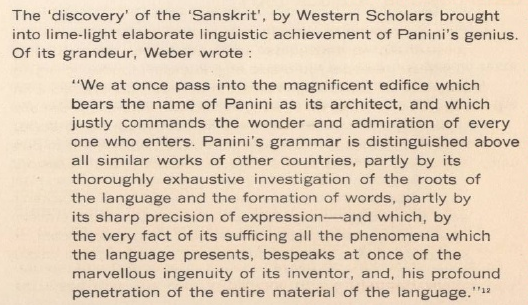
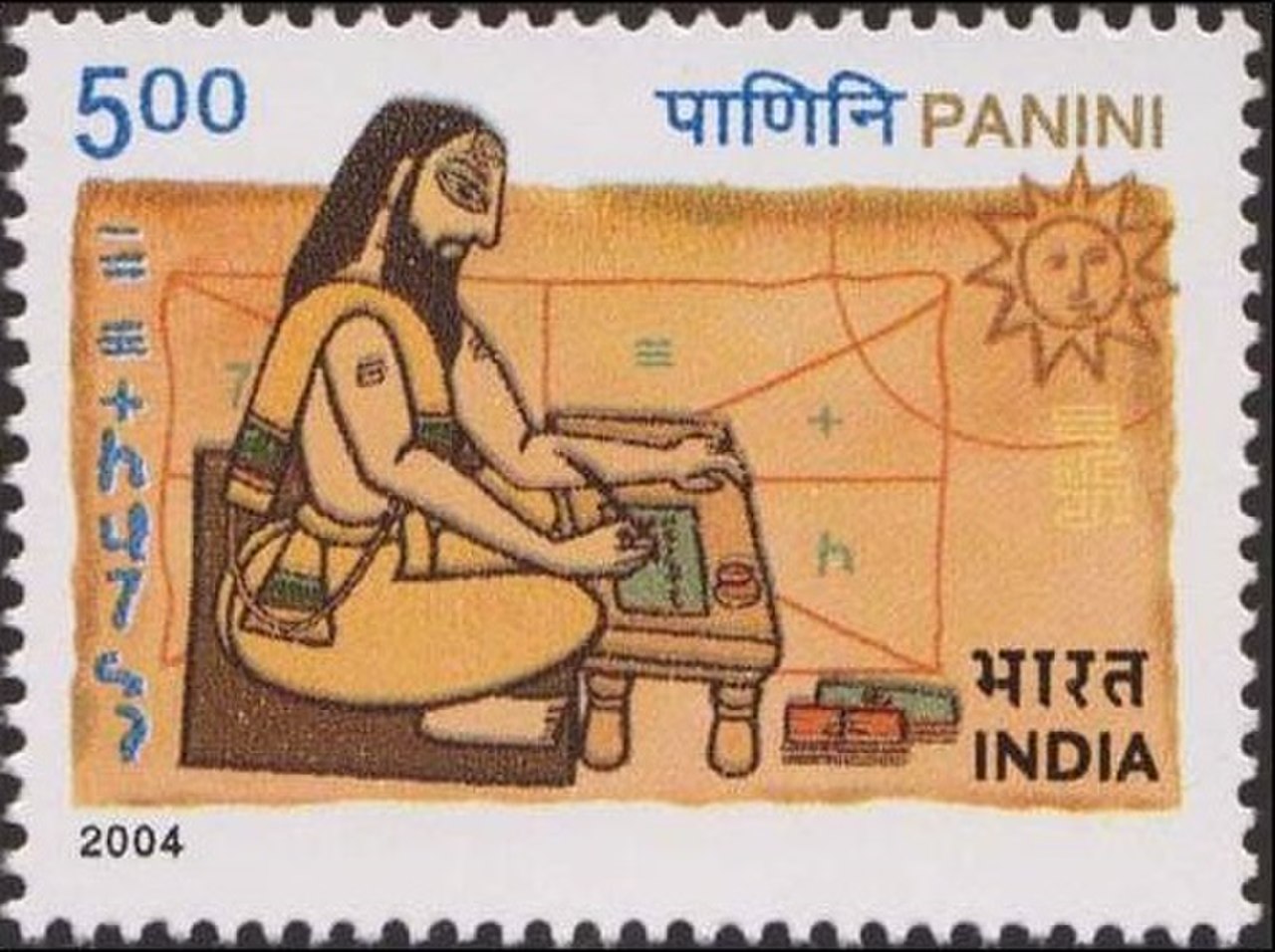
At first I wondered what were the signs around him, and them I noticed they were the same as at the left and at the left they're naturally 123456789, especially 7 and now I wonder what it does behind his back.
the Astadhyayi consists of about 4000 sutras arranged in eight Chapters (Adhyaya) each made of four quarters (Paada).
In addition there are three associated texts, which, at times, are treated as separate from the main text. These are: Shiva-sutra (Maheshvara-sutra); Dhatu-patha; Gana-patha;
Shiva-sutra
The Shiva-sutras are a set of fourteen Sutras; brief, but highly well organized list of phonemes (Varna-s). It precedes the Astadhyayi, proper. It enumerates fourteen sound segments (Varna-samamnaya) of the Sanskrit language, in the order that is most conducive for forming the abbreviated terms (Pratyahara) used in the Grammar.
Panini’s grammar opens with an arrangement of the alphabhets not in their natural order known to us. The simple vowels are given first; then the combination of two vowels in a single syllable; then the semi-vowels; then the nasals ; then the consonants proper- where the Alpa-prana and the Maha-prana are kept distinct. And then the Samvara, Nada and Ghosha are given , followed by the Vivara,shavsha and Ghosha (these being the first two letters of each varga and Sha, Sa, Ha.
Шива-сутры (शिवसूत्राणि śivasūtrāṇi) или Махешвара-сутры (महेश्वर सूत्राणि) — четырнадцать стихов, организовывающие фонемы санскрита по «Аштадхьяи» (Восьмикнижие) Панини. Традиционно называются Акшарасамамная (akṣarasamāmnāya) — «декламация фонем», но, ввиду того, что, согласно легенде, они были показаны Панини самим Шивой, за ними закрепилось название Шива-сутр. Были составлены Панини как дополнение к тексту Восьмикнижия.
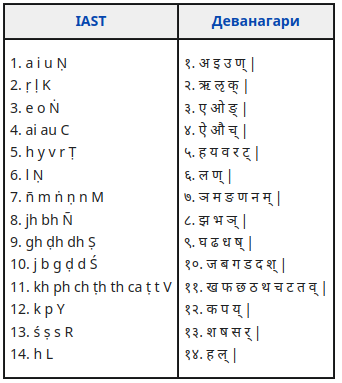
This hindu thing is still a mystery to me, I keep on approaching it only to be bounced back. Is it because I'm so explicitly abrahamic in religion or is it because I'm actaully an atheist?
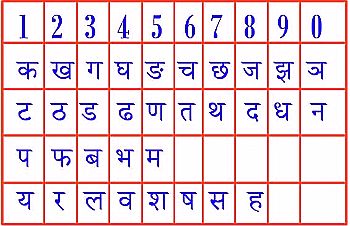
When I found this image, google told that it found at the site it links, but now it seems this image is not there and nowhere else to be found, but its irregularity is interesting, and I keep it here as a curiosity, the way I use to collect some random images, so this image doesn't have a proper comment to tell what it actually shows.
Here, I began actually readin what I've collected, and here it clearly tells that rigveda mentions writing:
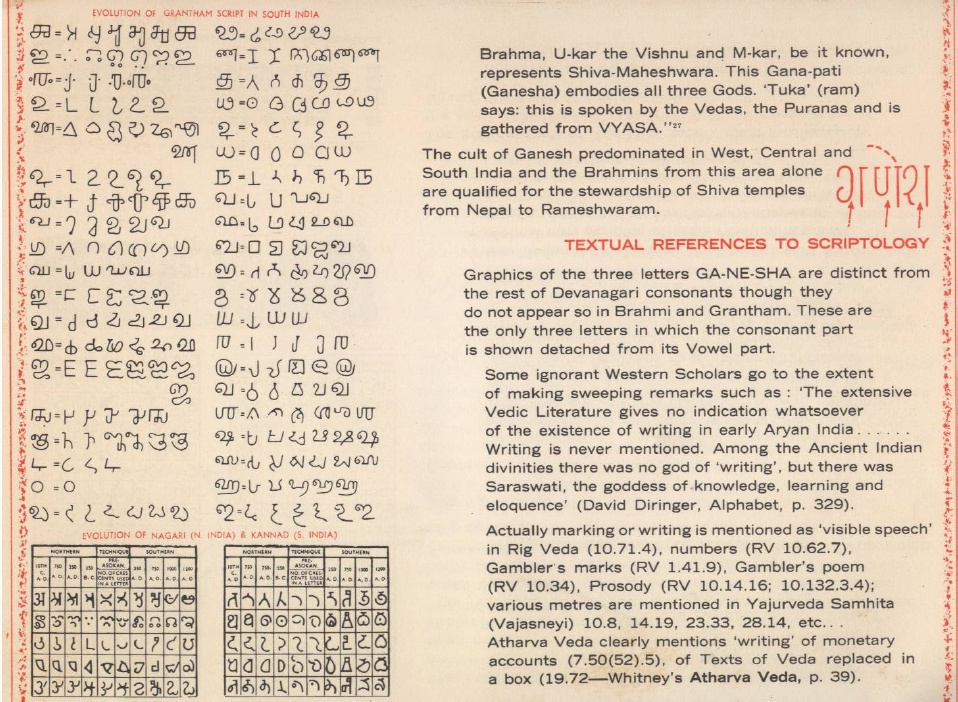

and here I notice that the U-column is suspiciosly similar to russian У-column, which is structurally the same column: У Ф Х Ц Ч Ш Щ (it has modified Ш the Щ, but if it's cosidered the same letter, like the most similar letters, the next in similarity are ЦЧ, both of which can be transliterated into Џ if literature or my ability to understand it doesn't lie (remember of replication crisis, everything you read is only correct with probability of about 50%, so I leave it here as the most suspicious passage, the inaccuracy of which shouldn't make the main point explained here inaccurate. The point is here: U ~ У, V ~ Ф (for english speaking people it may be incomprehensible, but germans sure will understand for von sounds as фон) and X ~ Х only for whatever reason english alphabet allows Ш-like W before it. And it jumps across the K. Is it how they switched Ш and M? was it also about Ϻ. and then Ч-like Y and Ц-like Z and they also stand in the opposite order. But the set is similar. But it can be
And I decided to rearranged the messy english U-line into russian order:

And haha! It brings X into the K line and C line too, because the other side of C is S which is included into X, thus X is like the ƆC the two shapes of C, soft and hard. or rather hard and soft. K before unpalatalizing vowels (a, o, u) and S before palatalizing vowels (e, i, y)
Z in the column (previously known as line) of Δ and R makes lots of sense. Y didn't change its position. W is like ω noω.
was zie we somewhere? Like what if pronoun antonymy caused some turmoil and they redacted something.
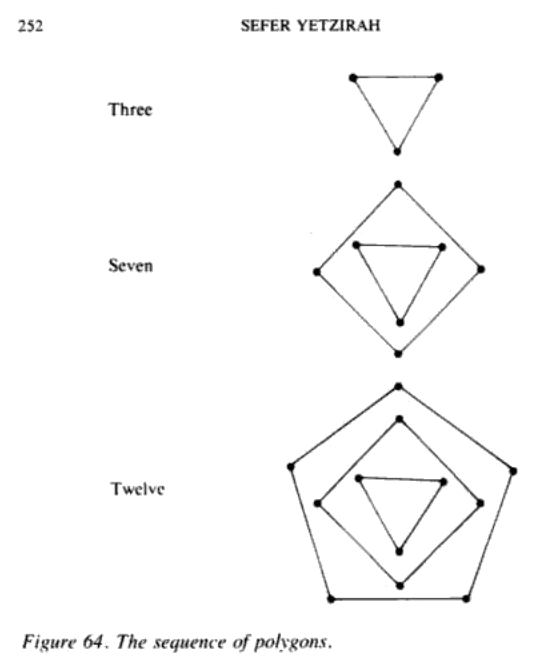
The three are א מ ש and in comparison to other writing system, א definitely stands for vowels, which dissolves a myth in a bad sense, that misconception of semitic alphabet being consonantal. The main arguments against this myth are expressed in the image above which includes hebrew. Disproving that misconception which is established as some dogma is not what I'm here to be doing, it is mostly expressed in that image above and though it may become a subject of debate, I doubt the proponents of that myth would have good arguments to support it other than that academic literature firmly holds this opinion. Structurally, if the alphabet had aonly three columns of elements, they could also have four lines of vowels (as semitic alphabets do, and that runic alphabet too) which is 12 and thus could also be related to zodiac directly.
The seven are ב ג ד כ פ ר ת and according to that diagram above, three of these seven are the three mothers, and though I immediately recognize ת as a reincarnation of ש, because אמת is truth and these three letters are what is placed on golem's forehead to animate him. Not actually, but in the myth. And though I recognize ב as מ, mostly because ABC is the other reincarnation of the three mothers. I cannot find a certain candidate to substitute א.
The twelve are ה ו ז ח ט י ל נ ס ע צ ק
And Because ה is the first among them, and because I consider that letter closest to א, I suspect it to be the reincarnation of aleph among simples. Because ו follows it and because it is labial, I suspect it to be the reincarnation of מ and too many letters could be a form of ש, so I leave it for you to fantasize, but these 12 include the other 7 and among them the other reincarnations, and it gives us four of each mothers, which gives us four vowels and four labials: Then I wonder if י or ע belong to the second group. But if the second group is of hard and soft consonants, none. Or maybe whichever is the most diverse in its pronounciation, to tell here I'd have to actually know hebrew.
Three elements (air, water, fire)
Seven days and seven planets (Sun, Venus, Mercury, Moon, Saturn, Jupiter, Mars)
Twelve months and Twelve constellations.
This is jewish point of view. The point of view of the mythologic source named Sefer Yetzirah. I cannot tell much about it, because I didn't study it well enough, because this cultue is still mostly obscure to me, because I don't feel like descending into it so far.
Today I was shown some new sites to search scientific inforamtion at and what humanity seems to know about this subject is still pathetic:
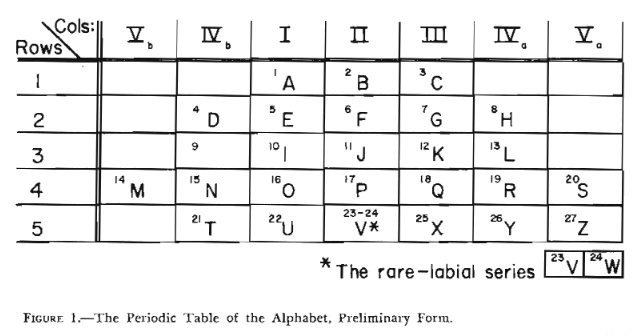
but some of them (or did they only lead to it being found elsewhere) gives some food for thought:
A bigram or digram is a sequence of two adjacent elements from a string of tokens, which are typically letters, syllables, or words. A bigram is an n-gram for n=2.
tetra gramma tone is pronounciation of four letters.
another meaningless paper but with an insight in it, an insight kinda explaining the mess in the last line of the latin alphabet. Because it ended at T or V a dozen centuries ago or so I would add, but here's some actual field report of a sort:
When I return papers in file folders, it is those later in the alphabet that are always out of order or out of place, suggesting less familiarity with that part of the alphabet. Yet every English speaker I have ever met over the age of 5 knows that first dozen or so.
Meanwhile here's a signature of surkov and all I can say of it is it goes clockwise and the most I can tell of him is he's a lucky devil.
 meanwhile my signature
goes counter-clockwise, I never noticed it. And indeed I could
have some boost of luck, even though I'm a lucky man as well. But
let's see how it goes when I mirror my signature from now on.
meanwhile my signature
goes counter-clockwise, I never noticed it. And indeed I could
have some boost of luck, even though I'm a lucky man as well. But
let's see how it goes when I mirror my signature from now on.Also that signature looks not like ВС, but like АД.
And this is interesting that he is thus some literall AДДЪ and wears a mask of BC. AD and BC. Capiche? Does it make this world hell for the last 2000 years or so? Was BC standing for something else before it was reread as before christ? So did JK appear in the alphabet with or before christians? Was it there for Julius Kaesar? Was it the same time July appeared as a word? But then next I say is that August appeared when A was added to BLN (BCD)
ᚁ ᚌ ᚈ are literally B G T (is it how c relates to b? c is bt? more like tb if it's spit. последовательность п т присутствует и в русском плюнуть (хотя ть может быть суффиксом, и роль т берёт на себя л или й.
Notice how ᚁ and ᚈ oppose eachother as b and d in a way, but not as B D.
ᚃ mirrors ᚈ (and so they do in latin: f and t) and let's not forget, that often they go from bottom to top and thus ᚁ is to the right, while ᚆ (h) was to the left, unlike h.
so ᚃ (F) would look like E (almost F)
But I will remember ᚁ and ᚃ as going downwards, because they are labial and thus female and thus yin. I think my sources telling that runes went from bottom to top are lacking (because you can hold sword both ways. And if we arange ogham from top to bottom, as we all actually write, then ᚆ will look to the right, as h actually does, especially when it's ͰͱⱵⱶ
But ᚁ as b still doesn't make sense to me when it's vertical and turned to the left it makes even less sense than when it's to the right to be honest, but then down and left go together better for they are both yin thing if I understand that tai chi thing correctly.
Lucifer is Jesus. Why? Because Jesus used magic to help people. And the way he used it made him a hypnotist or also a good doctor. So magica is medica/ g~d as they meet in g
And I tried to check this grammatic cognatism in other examples and the first one was spectacular:
girl ~ дева (gева)
(ir)ё~е
ł ~ w ~ в
give ~ давать, this I saw before
Why else do I consider l labial? because ᚂ is l.
самые жёсткие вещи не развидеть, потому что их надо расслышать. (расслышать по другому? как так получилось, что в русском расслышать имеет два довольно разных значения (услышать получше и забыть что слышал, сделать так чтоб словно и не слышла) разслышать? да, так их можно разделить смыслово (понятно что раз-означает в разные стороны, по другому, разбить на части, а расслышать разобать раздать в разные но р и з кажутся что с одной стороны (справа (unless z is greek and r is a form of p, and it must be it, because of p/r, n/п, r/ж, h/ж (ᚼ/ж)
Either way, раз in разно is like азр of other.
р и з не противопоставляются, потому что з и в противопоставляются: с кузова противоположно словосочетанию в кусовъ.
равный в row
разный с diverse differente
-se = -ent?
worse worend
pulse pulent? no, it doesn't work like this. Why was I checking it? It makes me higher. I focus on this shit and get off. I should get off for good. 18 volumes, great number in this story, so this is volume ᚢ
ᚢocemhadtsat
z (доски разной длины так лежат (торцом) например)
v как vesы.
z тоже как весы, но чаши на разных высотах.
У весов собственно всего два положения V и Z (два и три, равный и разный, U(ij) & Zij)
U(ij) are majuscule and its minuscule: U is Υ in greek, Y is ij in dutch, and this is dutch, so not that far their traditions of orthographyx are.
𒀭
Mij Jij Hij
Wij U(ij) Zij
both J stand before M and U stands before W (in russian plural you is вы (vy (Vij)))
but I saw it the other way, and now I look at it like this.
M reflects W
H reflects 𐌆 (the ancient greek form of Ζ)
𒀭
and that previous line actually came after the following structure. Hij is interestging hint indeed:
E F G H I J literally hij сей кой
I J K L M N Ik eL Me оН. собрал со всех языков калек. но билингвичность семантически
O P Q R S T сей тот (that) and also -ere -es -est (in russian it's -ть -ешь -еть, so R S T they are)(
U V W X Y Z
==========
I line contains M it's me and am. then is is the opposite of the
me am
the is
Rah are?
It makes sudden and indefinite sense.
𒀭
яд is ад (отравление от травы? т tree трава дерева древо treewo? what is wo? лево значит тоже имеет корень le? left takes that левъ and adds -ed to it. -ed reduced to -t. those are not minuses, because we're not in a math class. I'm sure it fucks the kids up.
Смотри какие корни у русско-татарской неприязни: отравили ~ от Равили.
яд=ад=от (от чего-то)
от отражается на -то, подобно тому как me обращается в am?
от то(й, го)
до тут? tot тут (tot is до in dutch)
это гадание на кофейной куще? иногда интересные вещи появляются, и я кстати забываю их отмечать, так что и перестану отмечать. или отмечу всё же. но надо вычитывать и остальное тоже.
начал отмечать, но либо я в таком духе либо и прадва сего дня хорошо. это . хорошо.
слишком много хорошего, слишком много 𒀭 получится
girl дева
give давай
(rl=v? but if ł denotes long l, and thus ll = not only j but also w (both й & w can be considered short) even thow w is called double., And double v makes sense, but double ю.. if anything, w is double v, half of u. then u is four v. and if that v looked like hebraic ו, then it could be the origin of roman numeral I, of etruscan numeral I too. and then U would stand for what 2 ו's and Wwould stood for four? Only if U would read as w. then maybe w would sound as u, but I doubt it was ever saw so, because I never heard of such reading, so I can only guess by their form, but not by historic material, but then historic material is so poor sometimes (poor are of poo) that pure speculation may be even better. But some historic material surely wouldn't harm, mostly because hopefully it would be independent source.
so~though
маленький маменький
I should have gone further still the spirit lead me and I decided to indulge into pride of self-admirations/.
I'm sorry, spirits, let's go on, please, I'm ready. Alright.
alright (all write)
(alright as a command to writers to scribbles to scribes)
because
could
do
enough
for
Great (жаре'ed? жрец?)
high
Intendents Individuals
Like
Myself
Not
On
Petty
Question
Rock
Seal
Tall
U (ю-ху!)
past-T sounds are probably of later origin. like wh (previously hv) could be q: quod~what
(quod is what in the context of that and why. and don't forget I'm google-translator-tier linguist, not exactly precise or expert)
О
Парус
Рей
Сегодня
Тоже
У
Флота
Ход
Чтоб
Шевелил
ЪЫЬ быть может волшебное заклинание, завывание, UVW что после основного
Это
Юнга,
Я
Это
Your
Я
Final letters of the russian alphabet are literally
a [æ]
U [ju]
I [ja = aj] (russian я [ja] = [aj] I in english)
so fuck those anagrams, thought they also may be telling, let's return to dutch grammar reporting of the alphabetic order.
Jij (jij is I ij) Mij Hij
U(ij) Wij Zij
if he was she, then it would explain the samekh and Ξ (and suddenly I see Ξ looks like 3, like 𓐅
and I imagine that Jij = I and what we see here is another example of pronouns' antonymy.
in dutch ай was you? because я is probably a, because a is az in russian letters, and az was I is я today (only few russians will understand that line, but hopefully I will return to it, maybe not)
The vibration 'TH' activates the 6th chakra and pineal gland, which is the female counterpart to the solar chakra. The pineal gland secretes the elixir of life, which is stored in the solar chakra, and the vibration for the solar chakra is 'RA.' This is the hidden meaning behind 'THOR' which is another very important spiritual concept. The chakras are always spinning unless one wills them to stop as with some methods of astral projection.

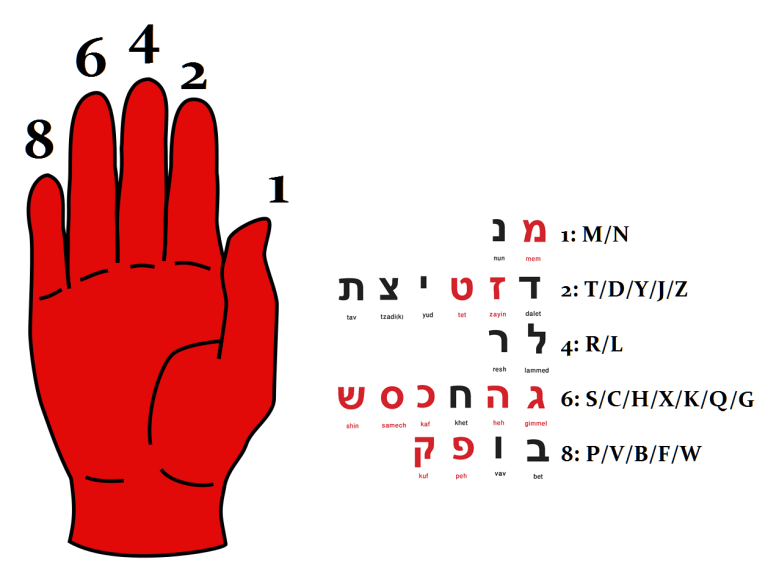
here they messed in the final line, ק is Q and thus belongs to the previous line, and I have no idea where does this image ultimately coming from or what it ever means. But probably they used rings connecting thumb with the fingers to get other odd digits.
and from the same site this /x/-tier shit:
hebrew is just backwards greek, you ever read about that?
it's not just a theory, it checks out with a LOT of words, take out the vowels and write it backwards
later jews lost the knack and started thinking hebrew and greek weren't the same, it's like mirror languages
i think it was haroun yaha or whatever his name is, he's also woke
the muslims count 4 generations between noah and jesus, 4 only
I probably shouldn't bring everything lying around to the table.
but some things from some other anon is more interesting:
vowels seem like shreiks a chimp would make. They've been known to differentiate various threats. One sound for snake or ground based another for hawk or air based, that sort of thing.
In Gnosticism, the vowels are considered a form of the name of the Monad, much like the Hebrew tetragramaton. Examples of this and similar vowel usage is found in the Nag Hamadi Library. Some have suggested that they form a phonic pyramid pointing to heaven.[4] Others believe its true meaning is lost.[7]
It was the last known Cathar Perfect, Guillaume Belibaste, who proclaimed the prohecy before his death at the stake in the year 1321:
"At the end of seven hundred years, the laurel will be green once more".
The chant is a description of the end of this age under the tenure of the Herdsman (Satan) humanity are the herded. The chant describes the rise of gnosticism through means of the way, the fire of transformation, the stripping away of outer layers (turnip) and the revealing of the heart (cabbage) and baptism the demise of joanna ( Satan, from jehova the demi urge). The lark sings of a new dawn. All of course being prophesied by Guillaume Bellibaste.
The laurel or laurel wreath symbolises victory, a victory over the dominant socio religious structures of recent history those very structures that eradicate any gnostic groups and being structures controlled by a maleficence.A new system based upon spirituality as practiced by the Cathars will rise to replace what was.
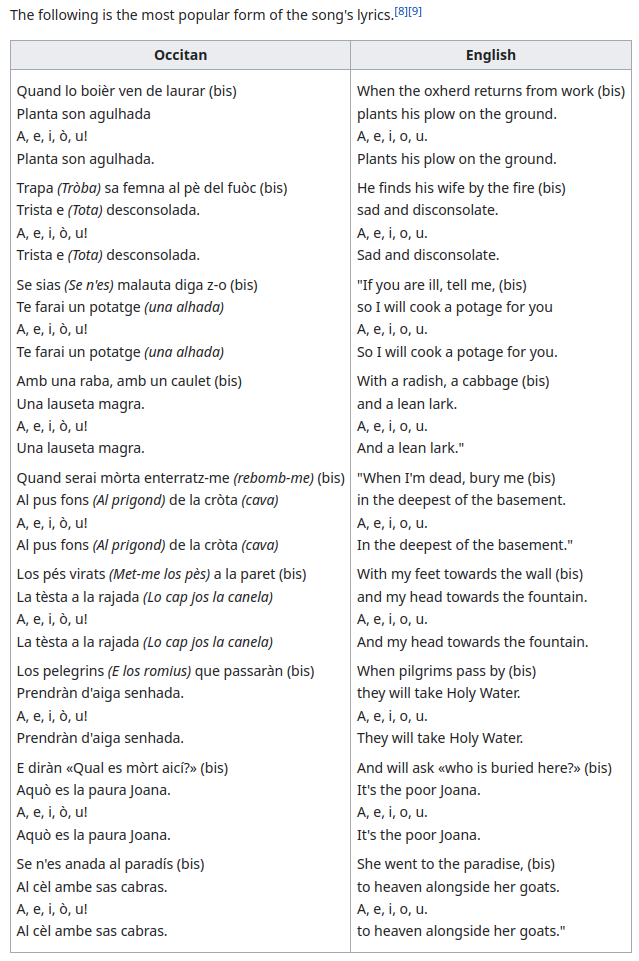
I was thinking about how monks could sing it from that castle of
I was thinking about stery in monastery being like stereo. And now I see that monk is of mono:
monastery (n.)
"place of residence occupied in common by persons seeking religious seclusion from the world," c. 1400, monasterie, from Old French monastere "monastery" (14c.) and directly from Late Latin monasterium, from Ecclesiastical Greek monastērion "a monastery," from monazein "to live alone," from monos "alone" (from PIE root *men- (4) "small, isolated"). With suffix -terion "place for (doing something)." Originally applied to houses of any religious order, male or female, but commonly especially one used by monks. Related: Monasterial (mid-15c.).
Я стал иррациональным во многом потому что впустил в себя бога.
бога или беса? бешеный! бог и бес одно и то же. Именно по этому алфавит разведён по согласным, а может наоборот по гласным, чтоб разнообразить я зык, чтоб развести бес и бога по разным сторонам мира духов. Сначала мы поняли что духи вообще существуют (правильно поняли или нет дело десятое, в наших понятиях этот термин появился)
или иль ~ or (l & r tell it easily could be cognates, but i and o are at the opposite sides of the spectrum, so they are in I and ו. It is as if глсн лшн, even palatalized and not palatalized are the same. c is k & s
я в духе
духа в себя впустил (как Иисус научил)
допустил, что он существует и впустил
вера
въ Ра (в духе святом съ въ том)
В начало беше Словото, и Словото беше у Бога, и Бог беше Словото...

Russian faces of the warriors tell me that scythians were ancestors of russians.
The Scythians (from Ancient Greek: Σκύθης Skúthēs, Σκύθοι Skúthoi) or Scyths,[note 1] also known as Saka and Sakae (Old Persian: 𐎿𐎣𐎠 Sakā; Ancient Egyptian: 𓋴𓎝𓎡𓈉, romanized: sk, 𓐠𓎼𓈉 sꜣg; Ancient Greek: Σάκαι Sákai; Latin: Sacae), and Ishkuzai (Akkadian: 𒅖𒆪𒍝𒀀𒀀 Iškuzaya[1][2]) or Askuzai (Akkadian: 𒌷𒊍𒄖𒍝𒀀𒀀 Asguzaya, 𒆳𒊍𒆪𒍝𒀀𒀀 mat Askuzaya, 𒆳𒀾𒄖𒍝𒀀𒀀 mat Ášguzaya[1][3]), were an ancient nomadic people living primarily in the region known as Scythia, which today comprises the Eurasian steppes of Kazakhstan, the Russian steppes of the Siberian, Ural, Volga and Southern regions, and eastern Ukraine.[4] Classical Scythians dominated the Pontic steppe from approximately the 7th century BC until the 3rd century BC.[5] They can also be referred to as Pontic Scythians.[6][7] They were part of the wider Scythian cultures, stretching across the Eurasian Steppe.[8][9] In a broader sense, Scythians has also been used to designate all early Eurasian nomads,[9] although the validity of such terminology is controversial.[8]
and the high level of their sculpture makes me believe that they could be related to etruscans, because those also have that sc part, and that is static part, when first half of the word can be changed even to tuscans Toscana
The ancient Romans referred to the Etruscans as the Tuscī or Etruscī (singular Tuscus).[31][32][33] Their Roman name is the origin of the terms "Toscana", which refers to their heartland, and "Etruria", which can refer to their wider region. The term Tusci is thought by linguists to have been the Umbrian word for "Etruscan," based an inscription on an ancient bronze tablet from a nearby region.[34] The inscription contains the phrase turskum ... nomen, literally "the Tuscan name". Based on a knowledge of Umbrian grammar, linguists can infer that the base form of the word turskum is *Tursci,[35] which would, through metathesis and a word-initial epenthesis, be likely to lead to the form, E-trus-ci.[36]
бог~бес подобная артикуляционная вольность должна и в других словах проявляться:
бегу бежу. а с с? быстро! быстро = бегом? -ро = -ом? ром? аоумнъаоумнъаоумна
Смысловая разница между Г и С в том, что Г высоко (как Голубь) а С низко (как Снэйк, Zmeya)
Иегова ΙΕΗΟΩΥΑ Иешуа
Исайя
what if that triangle with tetragrammaton is just a substitution to triangle like this
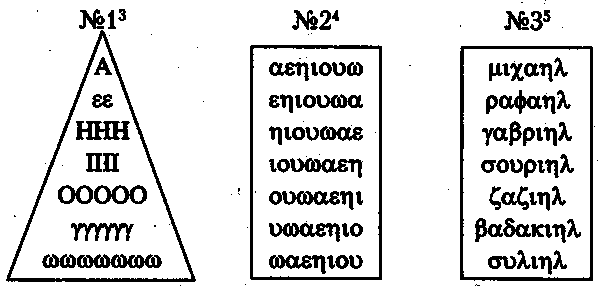
In that triangle the row of six is not γ's but Υ's (even though they did use γ (whether of ignorance or to conceal it) (though tetraktis tells that they probably were four vowels, just as hebrew has them)
And if what I said is correct, the actual tetragrammaton is... יהעא
which is graphically surprisingly similar to russian хуй (the vulgarism for penis) which is also a word one shouldn't utter. And you probably saw that yhwh depiction.
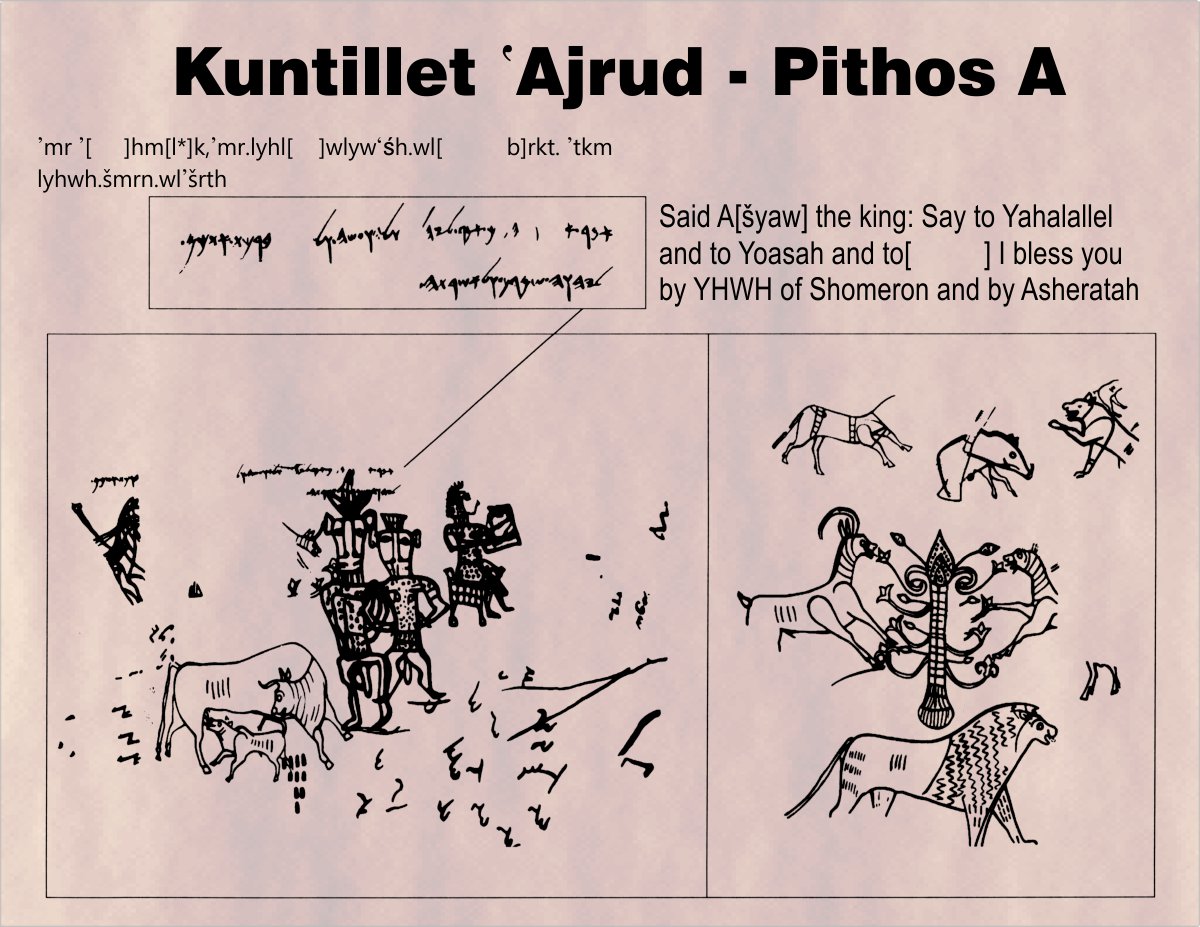
I'm confused by the figure behind his back having penis only in half of cases (whether it's not to propagate homosexuality or to do, or just false prudence, or trolling, or something else)
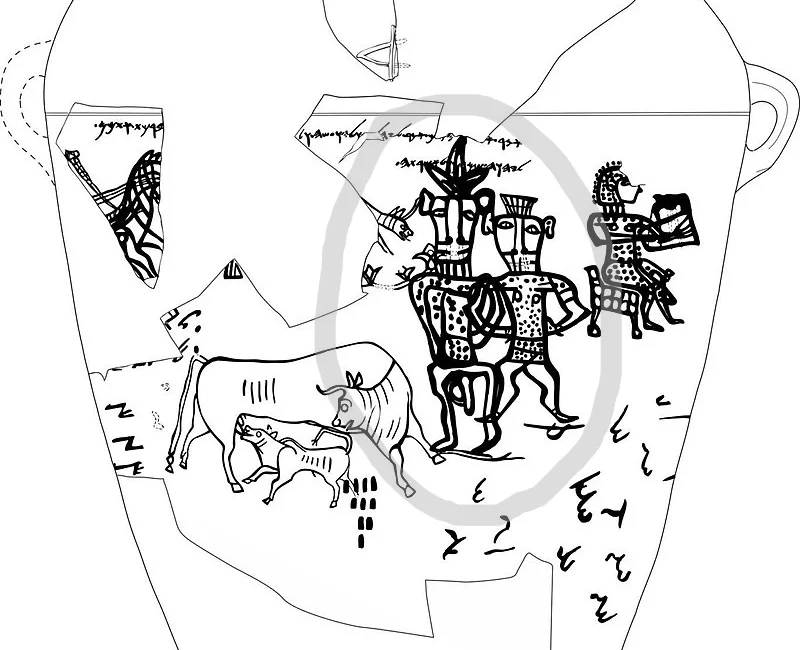
Leonardo's mother is Bogomil from Bulgaria. Catharism is the western sequel.
Leonardo da Vinci,[b] properly named Leonardo di ser Piero da Vinci (Leonardo, son of ser Piero from Vinci),[8][9][c] was born on 15 April 1452 in, or close to, the Tuscan hill town of Vinci;
Catharism (/ˈkæθərɪzəm/; from the Greek: καθαροί, katharoi, "the pure [ones]")[1][2] was a Christian dualist or Gnostic movement between the 12th and 14th centuries which thrived in Southern Europe, particularly in northern Italy and southern France.[3] Followers were described as Cathars and referred to themselves as Good Christians, and are now mainly remembered for a prolonged period of religious persecution by the Catholic Church, which did not recognize their unorthodox Christianity.
historically, that is not far from this:
"A.E.I.O.U." (sometimes A.E.I.O.V.) was a symbolic device coined by Frederick III (1415–1493) and historically used as a motto by the Habsburgs. One note in his notebook (discovered in 1666), though not in the same hand, explains it in German and Latin as "All the world is subject to Austria" (Alles Erdreich ist Österreich untertan or Austriae est imperare orbi universo).[1]
> not in the same hand
So it was a secret. Natuarally. or a psy-op to rememe the meaning? To make people forget that it was the enchantment of the god's name? But "not in the same hand" tells that he never said that was the meaning of it, he never told, so it seems. It was a psy-op.
fugo is another derivative of бег (or rather both are derivatives of their proto-form)
a message from an old friend:
It is generated throughout the body, passing as a liquid-like substance akin to Cerebrospinal fluid (CSF) along nerve sheaths...
It can exit through an aperture at the bottom of the "cella turcica" as tiny drops. When this happens, in intense sense of bliss is experienced throughout one's entire being.
Most often, when people sexually experience their most exquisite erotic, full brain/body orgasm, they might notice this, what is called, "elixir of the gods"... a divine/human love potion... ambrosia, amrita.
Children conceived during such copulation are born free –naturally so – "free" as in moksha.
Синагога. Гога и магога. Гога, маГога, синаГога. Were vowel introduced to distinguish zero-prefix? a goga. And how does that article relate to a- of denial?
a is 1
a- is 0?
did - stand for less?
did + stand ofr more?
+ as to, да, and. (да as both yes and and)
lms? less is no mo, no more.
l is I? less=yes?
or are l adn j opposite? then p and f would be and b and t. though b and t could be, p and f are grammatic cognztes. Grammare tells how added letters change the meaning.
There is some wicked wisdom, teaching people shit: "if somebody hates you without a reason, give him this reason" — you want to give the guy a reason to hate you and you think he hates you without a reason? — you really think it's a good way to spend your life in giveing people reasons for hate? — In my opinion it is nothing but cope that they are taught to reign over goyim and they fucking suck at it, they make one atrocity after the other becauee of that philosophy of theirs, but how would world cure it? Would it? It's like literal evil, the intricatwe part of the consensus, of the concepts.
Like they literally teach their kids this shit. That villains are cooler. I think I thought the same when I saw Batman. When I was a kid. They filmed it. They make films about gangsters and they program their goyim to commit crimes, so they can justify government.
шоколад мармелад сладкое
is ieoua the actual reading of the name of G?
ieoua is both yehowa and jeshua. So it might be the right order.
IEOUA but yesteday I wrote in my notebook that E must be 3. so what. were they IOEAV?
i o like be do
and what verb has e? is? are? est? is a ga? aeiou go is the fours. fourth.
IOEAU
ё æ ō
au for o tell that a and u appeared before o, or else why would that dygraph would be needed.
au ↑ ↓ AV ΛΜν (alt, низ? да, не? lo ne? A shows into the sky. V shows to the ground. only it matters now)
← ↑ → ↓ could be these vowels. I like it that unicode has them clockwise.
Clocks preserved rotation. And their rotaion is unique, the otherwise direction would be unlucky, so who would want it? If the clocks give information not in the usual format, they mislead people abouyt time, and what is use in such clock, they were all destroyed as bad charm (there are some custom examples, but the stundard is universally the same as far as I know, uyntil the otherwise evidence is provided, I допускаю existence of some opposite culture. But the one I'm digging into is all clockwise. All of it? I don't know. some letters are the other way around. We are taught to write c counter-clockwise. But who has the right direction?
ΛΜΝΞΟΠΡΣΤΥΦΧΨΩαβγδεζηθικλμν
← E
↑ A
→ У (before I recognized it as Ɔ, and it is alphabetic.
↓ W (before I recognized it as U, just now)
I lined them by grapghic features.
EAOU is also chromatic: from highest to lowest gradually.
IΛΔW would be a great graphical representation, also explaining why in the east Г is the first consonant. I Г D W as it is in the east from japan to india.
letters derive from some hieroglyphs or petroglyphs, but they are rather abstract forms. Geometric figures made up letters! Of course. One abstract concepts expressed by the means of the other. And I suspect some connection be laying between them.
Geometric figures as linguistic source. It is a great topic and I only now reached it.
𒀭
𐤀 𐤁 𐤂 𐤃 𐤄 𐤅 𐤆 𐤇 𐤈 𐤉 𐤊 𐤋 𐤌 𐤍 𐤎 𐤏 𐤐 𐤑 𐤒 𐤓 𐤔 𐤕 𐤖 𐤚 𐤛 𐤗 𐤘 𐤙
𐤔 𐤏 𐤂
I can see 𐤖
only among numerals. (notice how 𐤗 𐤘 support my approach, but they are some other numerals:
10 𐤗
𐤘 20
100 𐤙
I suspect these to be V X L but then I don't know the context in which they were found, so I cannot tell if it's a valid guess or just a speculation. It is just a speculation. a good guess, but only a guess until the context comes along.
I thought 𐤙 looks like 𐤂 because it's some gundred, but hundred in hebrew is mea: מֵאָה
but probably it was borrowed from arabic مائة but then there are probably plenty of hundreds in bible, but then I still don't know the ancient hebrew. I don't modern hebrew either.
If I separate the last letter from مائة I get مائ ة
And though ة looks exactly like 𐤏, it is not o but e. Which raises quesion: are both e and o.. ё~ö?
efgh
opqr.. yep, it could be. r and h consist of exactly the same strokes. Only it's as if h is capital r or it's more pronounced form, if we look at english r sometimes almost unde.. unheard. underhead underheard. I heard it ~ I head it (you hear things with a head) hear heard head (heard is even closer to head than hear) is d~h if d~r? d reflects r in k-symmetry and h stands right under d, thus can be it's form.
123456 or IVXLCD?
1 4 8 32 64 256
20 22 23 25 26 28
1 4 7 are out of the sequence of exponents. And the final exponent is 8, which may also tell that X is 8.
let's add to that 365 the missing exponents. 365 + 2 + 16 + 128 = 511, nothing interesting.
To all my non-native brothers and sisters:
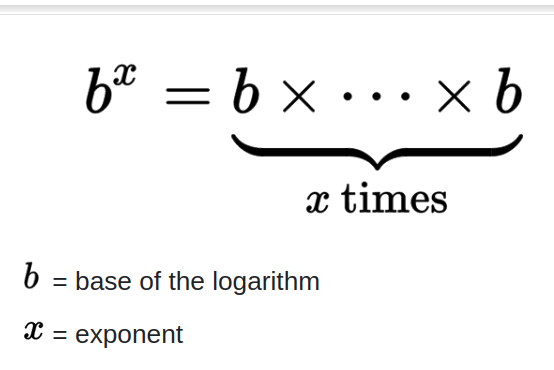
how could we not know this thing studying
english for so long!
But back on track. I E O U A is probably I E O U or I A O U.
was the confusion because I is ai?
I O U?
Λ O V?
Λ reminds both A and I (because l reminds I)
Ai Ou? is V the ou? o is next to ꙋ and runic script especiall relates A and O speaking not as much of the other voewls: o is aa.
ᛆᛒᚦ ᚾᚠᚵᚼ(or ᛡ)ᛁᚴᛚᛘ(even though it looks like ᛉ)ᚿ
ᚮᚱᛦ(if R, or ᛣ if Q) ᛋᛏᚢ
but though it goes good at first rhyming ᛒ and ᚱ, it doesn't seem to make any coherent sense after that.
I O like in be and do?
were there only these two vowels at first, the soft and hard?
why would O be hard? so were I [o] or even [u] of ו? or even [a] of ا?
then how would O be soft? like pussy, yes, you hearead me right.
Is r really the common ground of hear and read or is it just a coincidence?
O could be soft if it was not O but V, и is i in russian (like literally ctrlC and search it)
So were nations in dispute if u is soft or hard? is it dick or vulva? is A o or I
They could draw and understand those things the same, but pronounce them differently due to difference of languages. I like in dick. пися, but then pussy is also пися, so pussy makes пися especially female genitals, but in russian this word is used for both.
pc's are pieces, and I think that is what the final notes of the perfect drug song tell when it cuts the final s
дочка двчка
thin/thick
chin/chick
chin/cheek
chicken hen/chick
It sounds as if people measured humans by the ammount of meat their bodies contained.
We naturally ate humans before we learnt to pet animals. But then I notice that it's the other way around, unless chin held all the inner part. hence in. then it could have the tasty insides of the head? I don't find spot snot tasty, but maybe ancient people did. After all snails are considered delicacy. And when they're boiled they are, but would they be different from snot before bioiled. With all the shit inside them? the grass digested by a lower specie. We don't digest grass as good as cows do, so we boil it, but before we boiled we would probably eat the insides of the grass-eaters too, because we'd find it similar to boiled vegentables with vinegar or something, I never tried it, but hunters reported that once they cooked a deer head they also ate a good portion of it's belly: when they carried it, it was head down, so everything fell into its mouth and they probably were drunk to even wash the head. So they ate it and reported to eachother that it's somehow bitter, but okay. And only then they discovered that its mouth is full of shit. eat shit hunters. and they told me this story when we were only lightly acquainted. Soviet people are savages, they are villagers, and fi villagers are used to working with shit.
ABCD
EFGH
IJKLMN
OPQRST
UVWXYZ
St is shit? I thought it was for dead body, but it's for обосрался(обоссался) и того.
St is stench, stinks, st'ing's
stench stings, it is comprehensible even today.
st is of shit for sure. Because shit is what stinks the worst or more often.
(here I decide not to keep typos, because why would I want keeping random fluctuation of my consciousness, because they could be fluctuations speaking some story I just don't understand, but most of the time it's the next word I began thinking of before I typed this one)
Only some meaningful or interesting typos will be preserrved from now on, but mostly it would be semantic messages: like the one above where s is separated by colour to show the ing'ing.
A B C D
E F G H
I J K L M N
O P Q R S T
U VW X Y Z
This way it looks much more like periodic table of chemical elements:
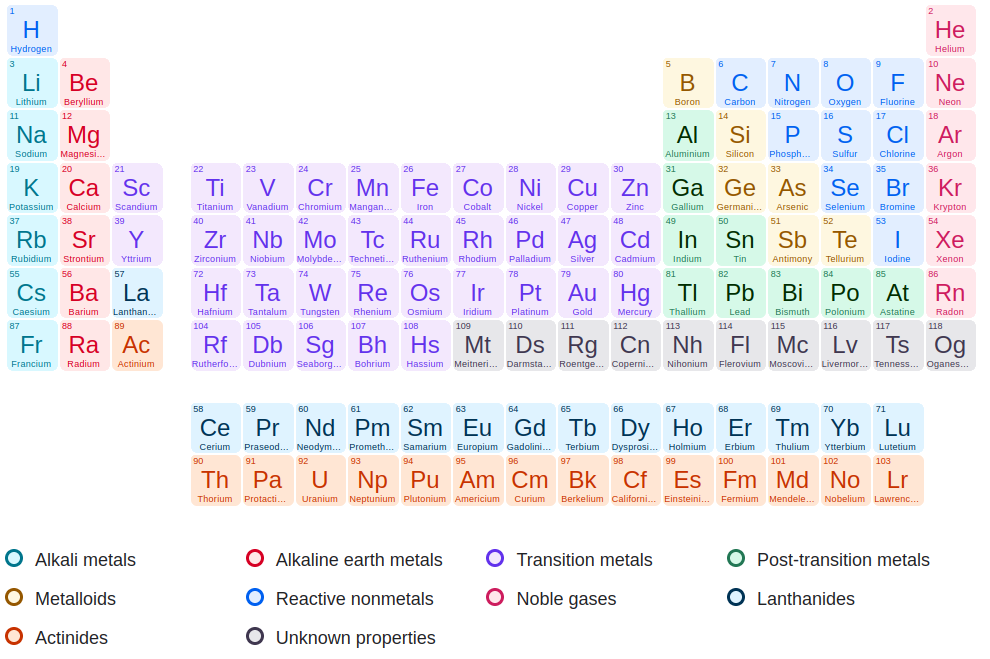
(this piece is not going to go to the lanugage book, but may be a piece in chemistry department of my university I now think I want to establish)

sou r ce
к лю ч
к ~ с ~ со ~
e vident ~ оче виден
eye are two eyes and nose? Nose also sees in a way. y ю клюв. nose knows.
if e is an eye, the other four letters are the other feelings:
a e i o u
слышать видеть нюхать осязать вкушать?
слышать Audio
видеть Vidett! See C. B be? 𓃀, stand. stay. C see? c~e? D 𓂧 touch.
𓂋 mouth or eye? mouth. iR is eye, which is close to iЯ. око и глаз не похожи. но очи уже да. ч очень похоже на y especially when it stands for й. Суффикс притяжательный, родительного падежа, прилагательный может варьироваться от й до к и ч и так далее. быть может но н и в. v ~ г. ν ~ ŋ
Eyes are these: 𓁹𓁺𓁻𓁼𓁽𓁾𓁿𓂀 and maybe these two too: 𓂁𓂂𓂃𓂄𓂅𓂆𓂇, they are the details of the previous one.
a e i o u
if eye is eye-nose-eye, then u (y in greek and russian) is nose. ν ~ v
if n is a form of u (and it is reversed that, and ᚿ and ᚢ tell aha!
aeyea
could stand for ear-eye-nose-eye-ear. And it would also be descending-ascending scale. Descending scale is chronologically earlier than ascending. ear eye nose. ухо глас глаз нос. у а о? уаоау, ascending-descending or what? or nothing.
aeiou aeiea?
a and a are ears? especially a, but a is also similar in a way.
come home (домой! на мой? man build a house and calls women to join him in it) to me. ко мне.
to me and ко мне are definitely cognates: t as c. c as d. s s s.
as = is
пуся = пися = pussy
у = и
пися вися? писая? писайте.
я = я, ай, ik, аз
й = ю, je, thee, ты
Looking at thee and ich as the reverse of one another: аз как от? отдай? т как й? long ɪ? or was it Y-like and had brevis above ɪ?
see~sit
he sit: he see'ed
so is saw?
lead веди
лучше better
лети веди беги
и я представил как войско пускало соколов перед собой, чтоб соколы атаковали противника первыми, и тут же следом (пока пративник отбивался от птиц) бегущие следом за летящими птицами воины нанизывали противника на копья или мечи.
лидер ветер
льёт вьёт пьёт (это же всё разные слова! я должен понять семантику букв, котолрые сменяются меняя не только фонетику, но и семантику)
льёт lets?
пьёт puts?
вьёт winds? (does it make пьёт pints and льёт ..lakes? liquids? l~m~n? леман?
Sister City or Twin Town
S is a female (soft, palatalized) form of T (so it seems form the line above, but it's not certain, of course)
paradiplomacy can be a valid tool of citizen diplomacy.
The fake narratives: global warmin, the big bang theory, kopenhagen interpretation. These three are pushed as the only truth by the schools and I think I spoke about them all already. Let's focus on something more important: How to make a billion to build my factory of capsules. First thing first. Make a prototype first. Have investors ready and paying for the documentary. If the documentary
Love is lovely.
He is lovely: he is (in) love ли (isn't he)
isn't it, isn't he, are they not are all poetically long forms of questionable suffix. it still had ne as in japanese. In chinese it's ma, in russian it's lie
and it's also ka in japanese, so klmn are all questioning suffixes, and they seem to follow the oriental (meeting the sun the first) wryting systems:
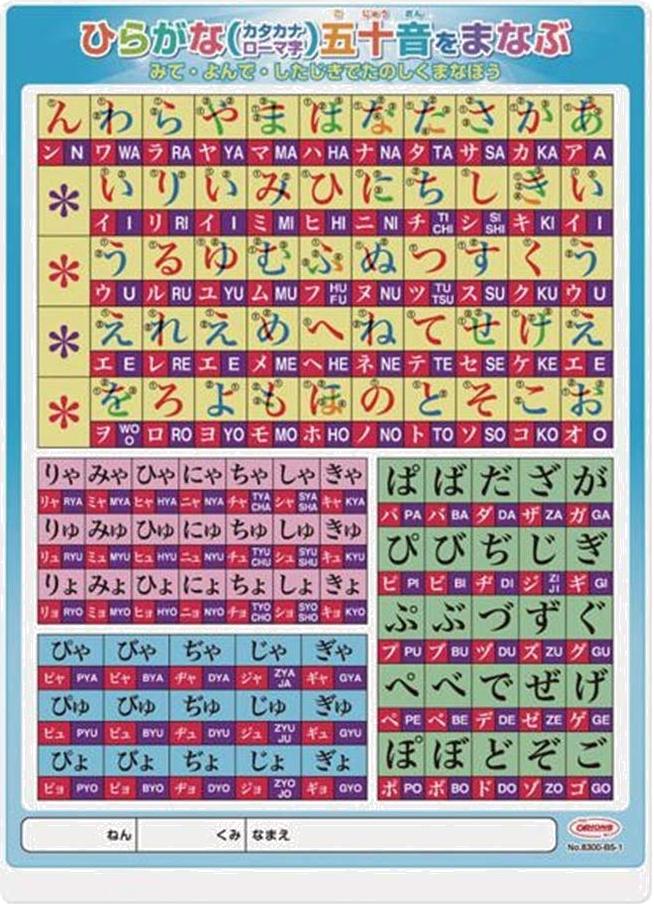
They go in chinese manner: in columns from right to left.
Notice how they repeated ieu for wiwewu and see how wa and wo remind a and o. and yiyeyu too.
I think there were some other (now obsolete) signs for wewewu, but they show how they write it today.
Here, a, ka ma la n (la is ra)
actually, i ki ni mi li, and I took liberty of ignoring everything around them, naturally these signs had to be somewhere, and because they're not in order, it is nothing. But since we're here, let's enjoy this japanese thing:

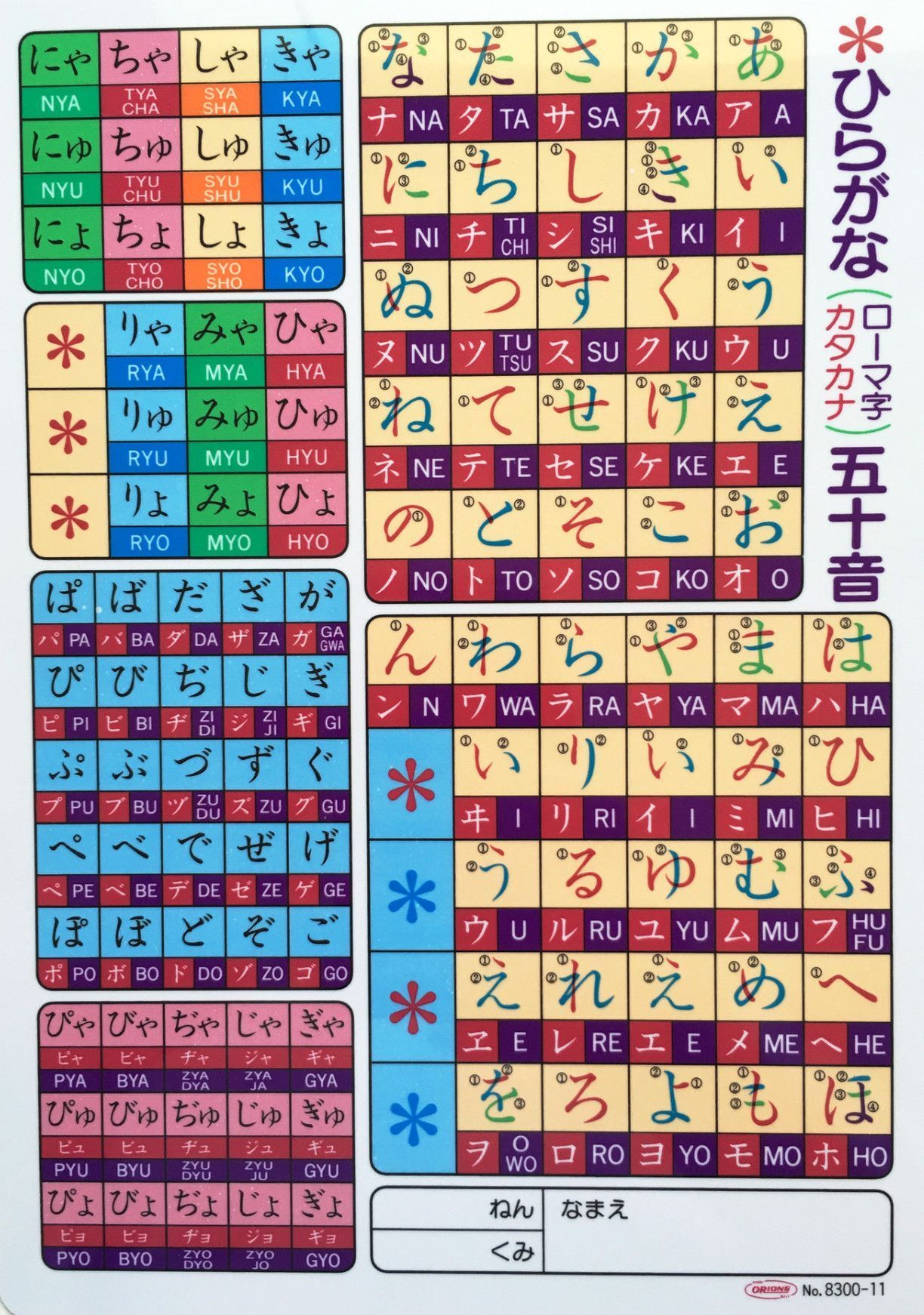
Here I can see for the first time this kana ordered split in half, and it is interesting split, because it is musical and could demonstrate the two lines this mantra is made of: aka satana! hama yara wan!
responce responds
bounce bounds (the two meanings of to bound could relate to magnets)
magnet bound.. well, could be cognates. But more examples wouldn't hurt.
and instead I went on reprinting some japanese textbook I found online:

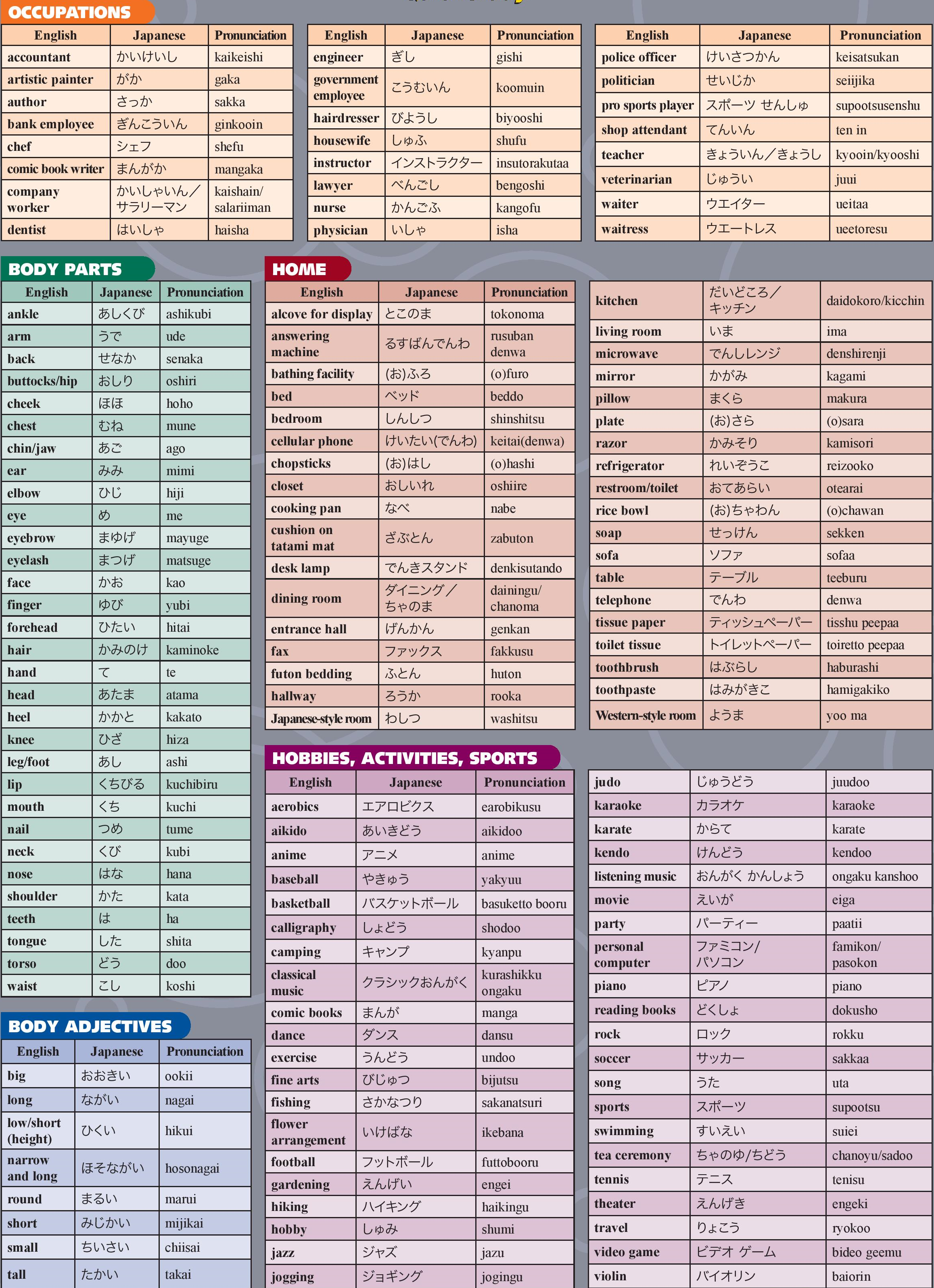
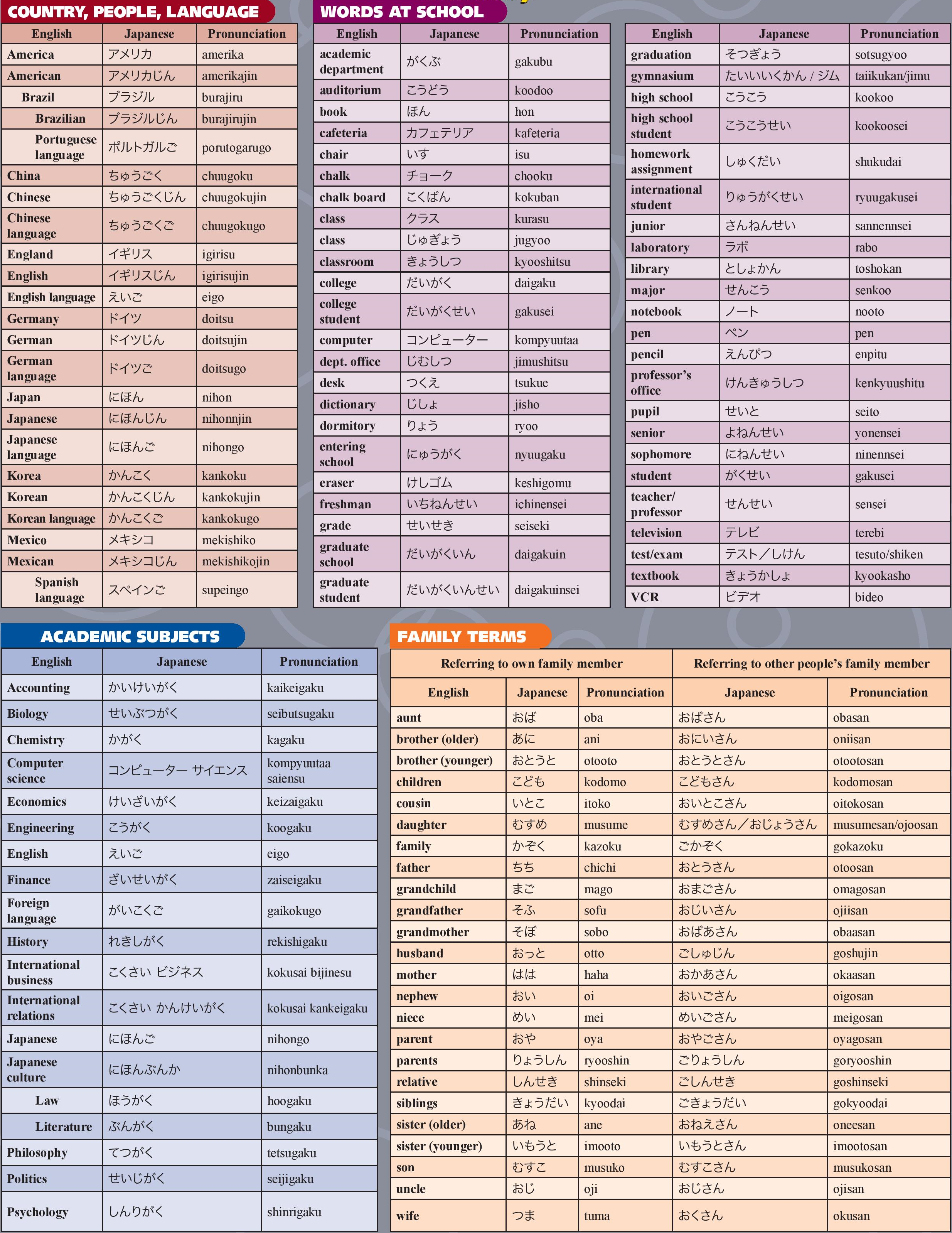

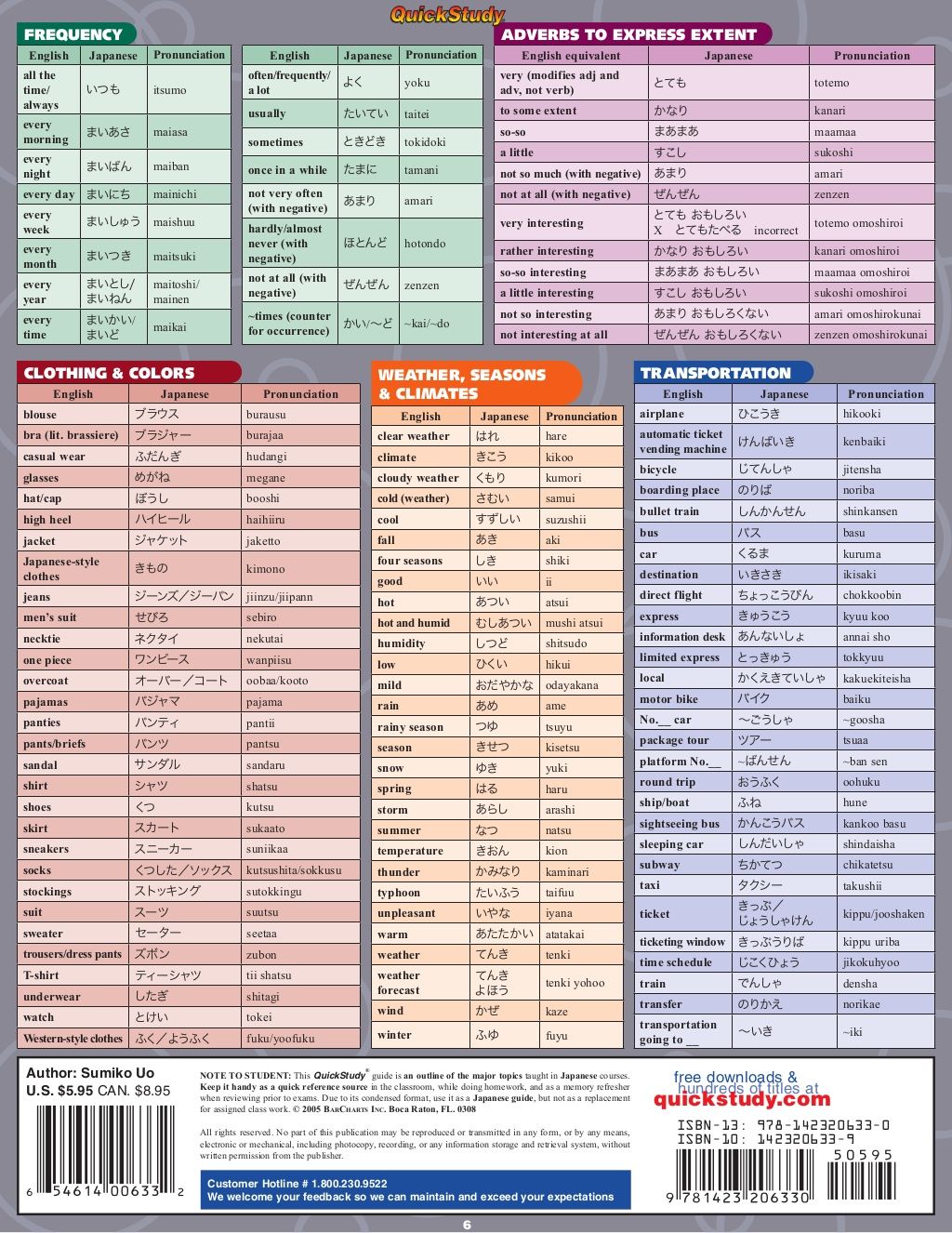
and I found it in more complete version at https://imgur.com/a/UhNF3 and here I copy pasted it to preserve as a library I am acting, giving links to, so giving some better service I am.
I think the pages above are included in the following reprint, but I kept them because they preserve the name of the other and the publisher, so that my promotion of some good literature is top-notch.













and I keep on my pirate broadcasting, working as some department of modern alexandria library.
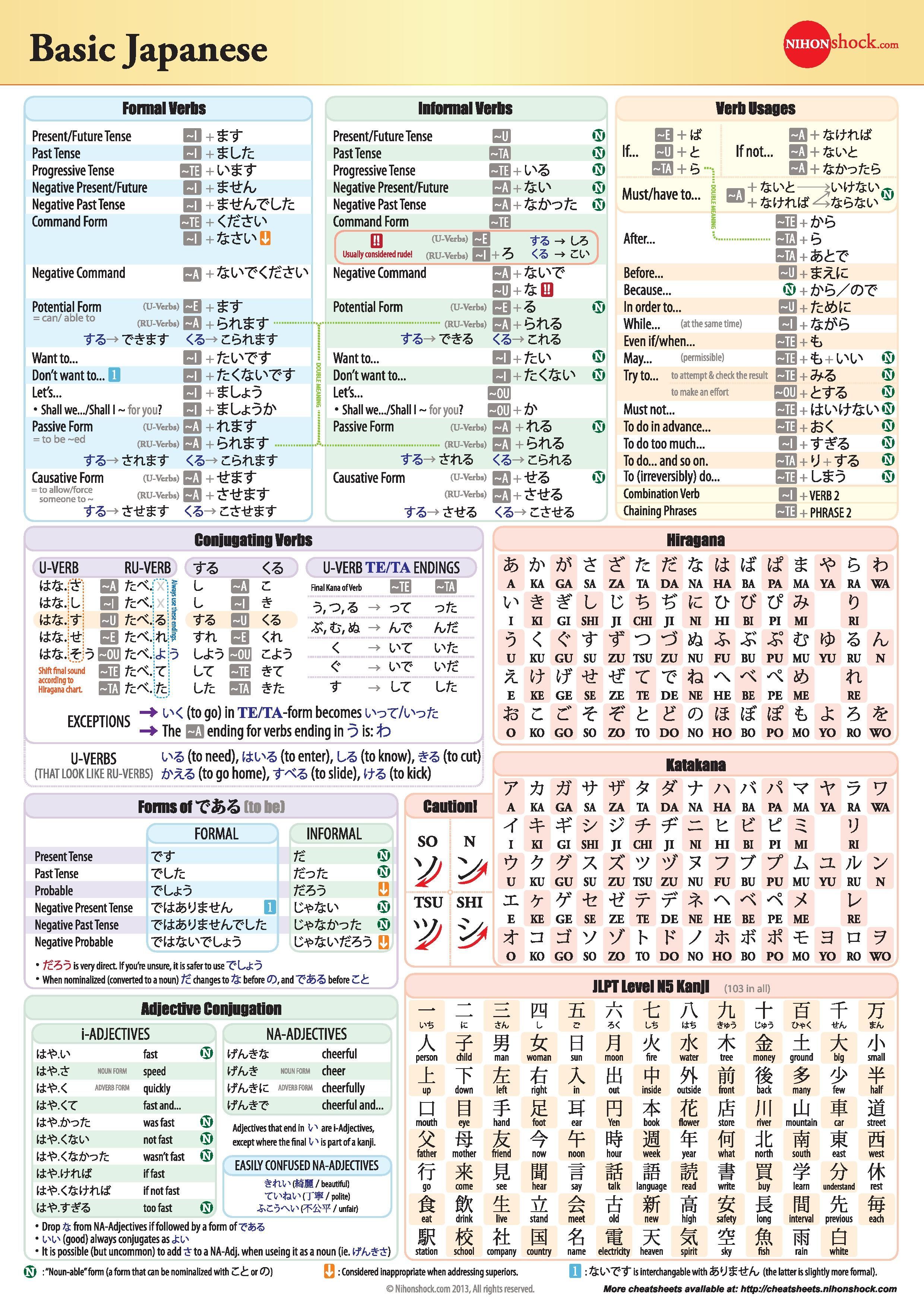
usagi is ushasty or ushastik in russian (literally earry)
автобус is auto+bus, but they call it bus. The variability of vowels (when they read o as a, for example) could be caused by finding a better melody, and stasis of the canon, so they just rememed those vowels reading them not how they were written. so bus became bas. Which could also tell that a is a later letter.
a read as e
e read as i
i read as ai
o read as a
u read as a
were they just a e which became more palatalized and thus half times read as e i and the other letters are just mess and forms of a?
That eiaiaa is closer to eiowa than aeiou is. Do they try to make i o with that transitory ai form? Because o is next to w, especailly as ω. Do they try to make i ו?
поБольше поДольше
Place Time
Более Долее
но если больше родственно ту боль, а боль ту били, зэн уот дас ит тэл ас?
дольше ~ дали? (everything comes to him who can wait? or who works longer?)
is Сима female form of Тима&Dima?
S as female form of T? T is tree. S is snake.
R is Rah? Sun? S is also for Sun. Sun is snake?
and I immediately googled sun egyptian ancient and the tenth in the search was this:

Where I took it they speak of him shown as a falcon, but what is it? My confirmation bias saw it as a snake but then I found the horns above his head and I saw or tried to sea goat in god. But then I saw the eyes and I realized that it's a wise snake. horned snake or is it his crown? Snake in the goat cloth.
Snake in the corpse is something to be aware of. This deity is obviously male, and it relates Sun to Son. And sundenly I see that Snake begins as Sn.
Snake is Sunny kamni? Solnechny rocK? row K? Syraya Земля? Сырое Золото. К как в Кин (метал) Кане (деньги) метал = материал. можно накончник стрелы из монеты вырубить наверное. Но скорей всего нет, даже гуглить не буду, бред.
Is boat shown crying? Is it heavy for her to move three guys with their snakes? Or are they themselves snakes too? There are three snakes? One around him? One in front of him? JOne is him.
Язык Я snake? знак? змеи Z
T is for tomb. mb is of mesto and place.
and in that search many interesting pictures appeared:

Notice how the sun has 21 pairs of arms. And the suns in the corners have 8 pairs and there are 4 of them, and thus 32 pairs, but it makes 53, not 52 as in weeks. 52 times 7 is 365, so a year actually does take 53 weeks, even if those weeks are not complete, some years may be leap. 52 weeks are leap years? No, the 53 weeks is a leap year. Like a year with an additional day in winter is considered leap.
But I was looking for this way to depict Rah (which was there but with watermarks, so I scrolled on:
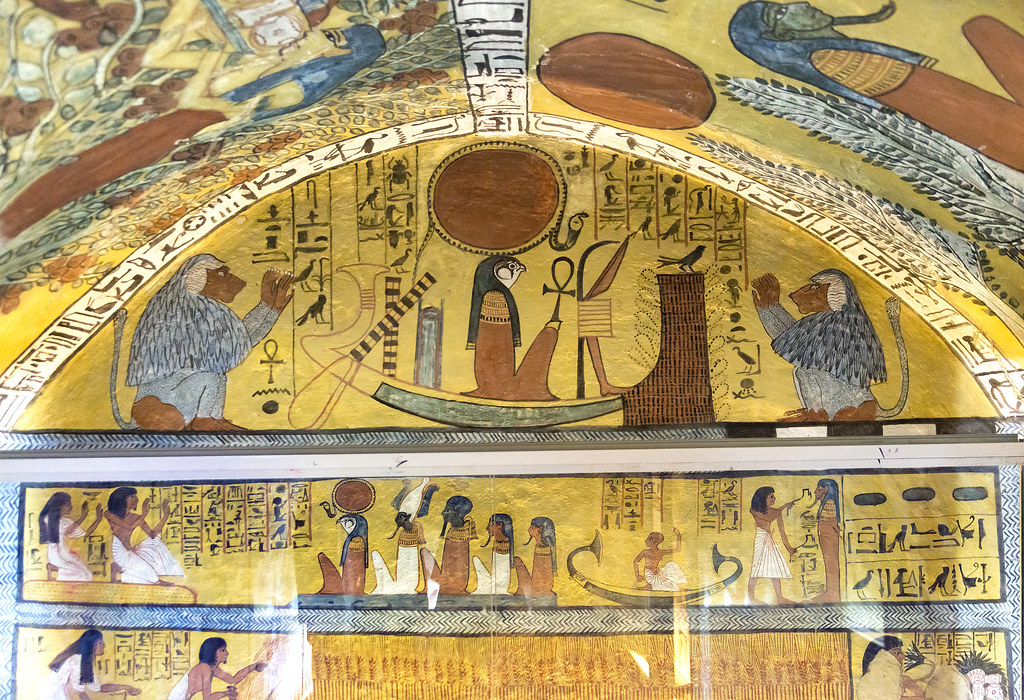
This is the shape I was looking for!
But what exactly are snakes? Aren't they sun-eaters? Змея~Земля?
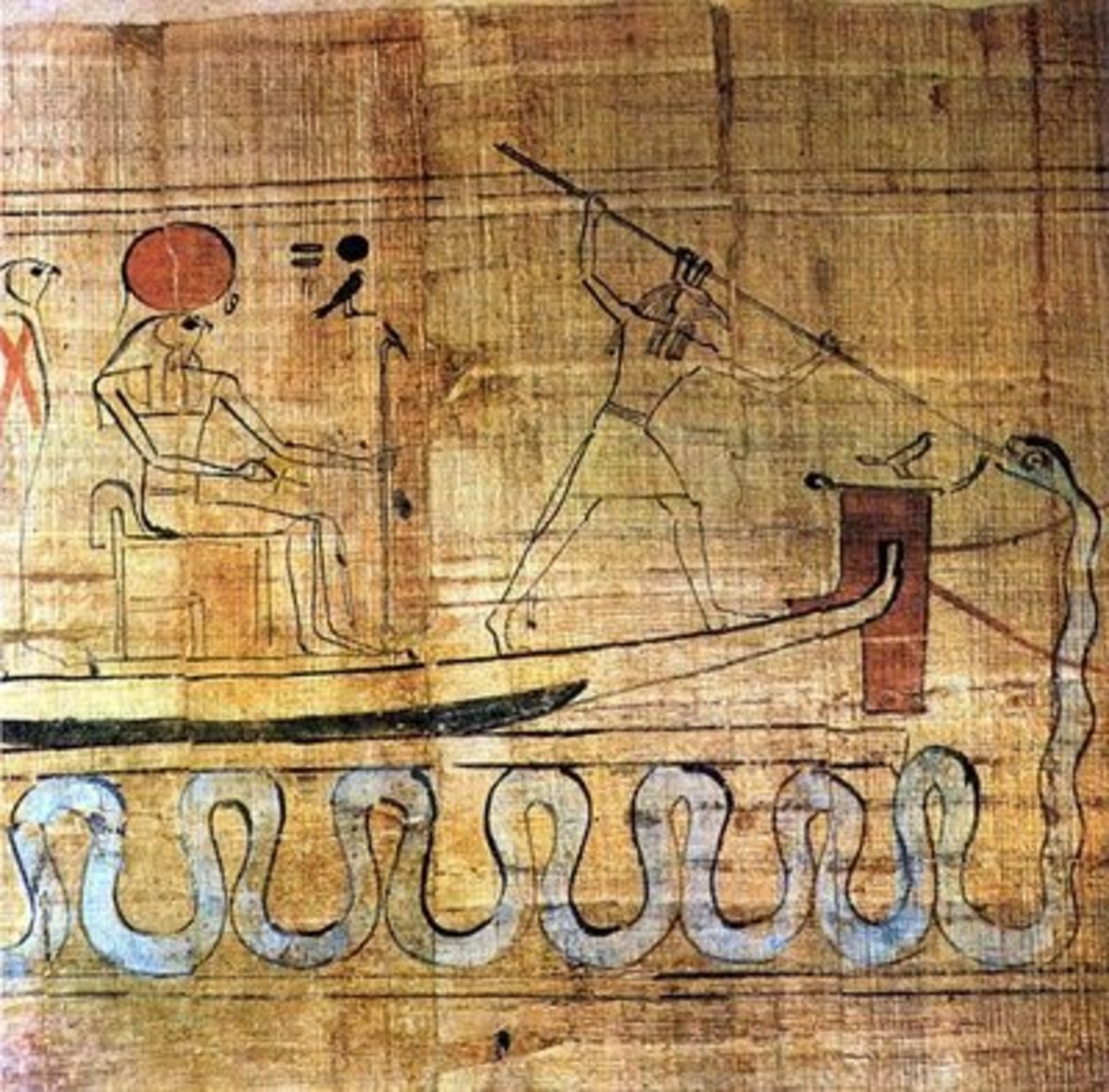
...also a spear, also a snake. but that could be unrelated, but I thnk of Jesus and now I think of St. George, and there are probably more.
But because one snake is around the sun, these are different snakes (some snakes give cure and maybe even immunity, the other snakes may swallow you awhole. This snake below the boat is probably the sea itself, and yes it does remind Jörmungandr.
Mushroom playing out as some room could be something deeper: мухомор is a very similar word, because mus is муха in latin.. did I say it? Dictionaries say it's мышь. Mosca is мошка is муха in spannish. Mouche (муш) is in french (and I wonder how do they distinguish between mouton which is sheep and fly. Руно is fleece, like fleas. Could be some euphemism to hide parchment, in some insects nobody sane would dig into. Wouldn't fly damage the parchment? Maybe they'd feed them with something better, but it's even worse than speculations, these are fantasies. Based on some phonetic symilarities, but fantasies nevertheless)
a b c d
Imagine doing it like this. In chapters: Volume a, volume b, and so for every letter there is. But wouldn't I have to repeat myself if pieces were about more than one letter?
I think this is the plan I had in mind at first, but then found that I know too little of the letters, and that connections between those letters are much more interesting than the letters themselves.
be see (deee?) what if see is the obsolete form of do? to see something as to do something? Things are happening with our presence. Being and Seeing is like b and c. and it is abc today, but before a it probably was bc like bt we know but actually ☽︎ ☾are birth and death. c is just a staveless form of d.
And to my surprise ☽︎◯☾ are read as БОГ
Г is C and Crescent in general is ☾ and that is why Б needs that ɔ to show that it's also crescent, but waxing one. wax and wane are x in the square and ne like no? or nom? ням. нема. нема~нету, т~m
☽︎ as ɔ as staveless ᚹ so is it how it can also be shown, the youth. Higher on the staff. and suddenly I see the three similar forms of bornholm alphabet.
ᛆᛒᚦᚾᚠᚵᚼ(or ᛡ)ᛁᚴᛚᛘ(even though it looks like ᛉ)ᚿᚮᚱᛦ(if R, or ᛣ if Q)ᛋᛏᚢ
ᚼᛘᛦ
Look how these three stand three letters from eachother, and are the only letters having disputed readings. My guess is because they're the most ancient ones and then they're I j k l M n o p QorR? ᛏ?
QorR, exactly. that is ᛦ. And as for other two.. both H & J can be attributed to vowels: И & I, which is pretty much the same vowel.
for those who doesn't understand this thing here's what phonetic diversity these things demonstrate:

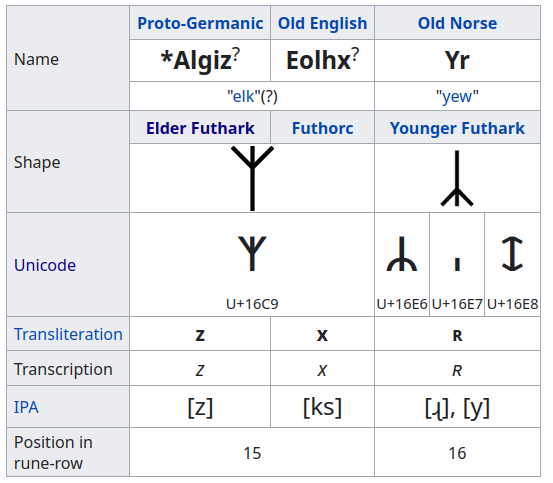

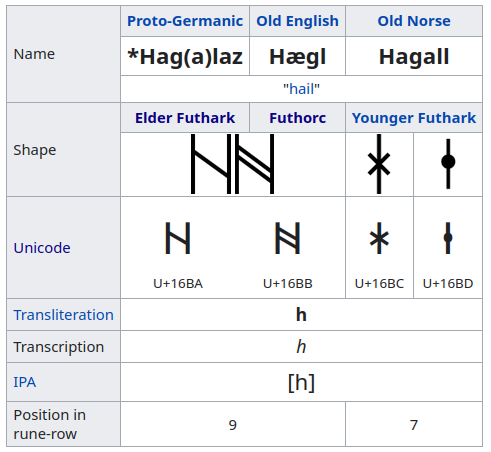

zomg, it is literally A, so the other two must be M and S or T
ᛡᛘᛦ is amour. любовь морковь морочит кровь? морковка значит писька встала, как морковка стала. мор в морковь как в амор, а ковь как в ковырять быть может?
АМГ, АВГ, ABC for amour? о бо же? обожание? о бо же да! еже зи? if gah? дальше непонятно.
"bornholm alphabet" I use this word, bornholm, as official for that very abecedary as a distinct system. And I name it as this locality to contradict the imperial naming. Not even counties. Maybe not even cities, maybe only houses. But then they all share communications and roads. So cities as centres of civilizations, but then those centers never end, because their citizens explore and even inhabit localities around that city. That would rather be stopped by companies delivering food
Б А Е И О У С or Б А Е И О У Г ор ИЕГОУБА иль ИЕГОБУА IETOBUA? eu batio (true father, good father)
check thios aut: beotia (the four vowels of hebrew and b and t)
Boeotia (/biːˈoʊʃ(i)ə/ bee-OH-sh(ee-)ə), sometimes Latinized as Boiotia or Beotia (Greek: Βοιωτία; modern: Viotia; ancient: Boiotia), formerly known as Cadmeis, is one of the regional units of Greece. It is part of the region of Central Greece. Its capital is Livadeia, and its largest city is Thebes.
Boeotia was also a region of ancient Greece, from before the 6th century BC.
And look at the map, it's next to Attica:
Boeotia lies to the north of the eastern part of the Gulf of Corinth. It also has a short coastline on the Gulf of Euboea. It bordered on Megaris (now West Attica) in the south, Attica in the southeast, Euboea in the northeast, Opuntian Locris (now part of Phthiotis) in the north and Phocis in the west.
and suddenly
formerly known as Cadmeis,
isn't it what Cadmus was?
In Greek mythology, Cadmus (/ˈkædməs/; Greek: Κάδμος, translit. Kádmos) was the legendary Phoenician founder of Boeotian Thebes.[1] He was the first Greek hero and, alongside Perseus and Bellerophon, the greatest hero and slayer of monsters before the days of Heracles.[2] Commonly stated to be a prince of Phoenicia,[3] the son of king Agenor and queen Telephassa of Tyre, the brother of Phoenix, Cilix and Europa, Cadmus could trace his origins back to Zeus. Originally, he was sent by his royal parents to seek out and escort his sister Europa back to Tyre after she was abducted from the shores of Phoenicia by Zeus.[4] In early accounts, Cadmus and Europa were instead the children of Phoenix.[5] Cadmus founded the Greek city of Thebes, the acropolis of which was originally named Cadmeia in his honour.
Cadmus' homeland was the subject of significant disagreement among ancient authors. Apollodorus identifies it as Phoenicia, but Tyre, Sidon, and even Thebes in Egypt are referenced in different accounts. His parentage is sometimes modified to suit, e.g. claims of Theban origin name his mother as one of the daughters of Nilus, one of the Potamoi and deity of the Nile river.[6]
Okay, my intuition didn't fool me this time, at least not too much, but I am into some fomenkoism right now.
formerly known as Cadmeis,
C D before BC?
CD BC AD?
CD is how it starts in hindu alphabet. Tibetan alphabet that is. Tibet is internationally recognized as their own Egypt.
I can only guess what their CD could stand for. I only know that ka is ma in japanese, and it makes me think that D is daddy. But before something more convincing comes along, it's only a hypothesis, a speculation, a first stone into some future theory or not.
if CD are ☾☽︎ then what do they begin with? Smert is just a Beginning.
I don't know what I'm talking about right now, way beyond my depth, I should return to what was good.
☽︎◯☾ is БОГ is good. And check this out: if ☾☽︎ are C D they're G-D, Good Old Daddy, GOD
O is 0: C D has o between them, but in consonant writing (probably actually a way to write jews most widely used, preserving ink perhaps, it is in their nature or in the nature of the stereotype.
C D is reminder, that though o is not seen, not shown, it is in there. God is with us even when not seen. You think moon is god? Both moon and sun are gods, and probably they were pronounced as Mom and Son.
Why moon is lune? how much m is l? much luchshe? but much is mnogo. ch is go? both are c and c could be cough or spitting, literally telling somebody to go away. caughing or sneezing at somebody would be perfect magic to make somebody go. I remember how I felt sick in front of companies of youngsters which were common in late soviet years (I didn't live in their early times, they say it was much worse back then) and it worked, they didn't approach me, probably some instinct preventing people from getting sick. But a better trick is positivity and confidence.
☽︎ ◯ ☾
B C бог, bog (the living unknown?)
F G fog (spirit?)
J K joke (Loki?)
P Q?
P S?
R cK? (rock like a tombstone? rock like a рок?)
Pr as sound of farting with lips may be shown for "died" and "the last letter in the alphabet, the least honorable sound. Some proverbial ѳ.
а бо же
и
а му ръ
are not identical messages, but contextually similar. If women invented this spell, what could it stand for? еби ещё! еби чаще! е би чу!
yeah! bigger!
yeah as the row of vowels, then the full row of vowels would be oh yeah!
Oh YeAh!
I saw A as Λ on a NASA pullover, and looking for nasa funts I go wtf
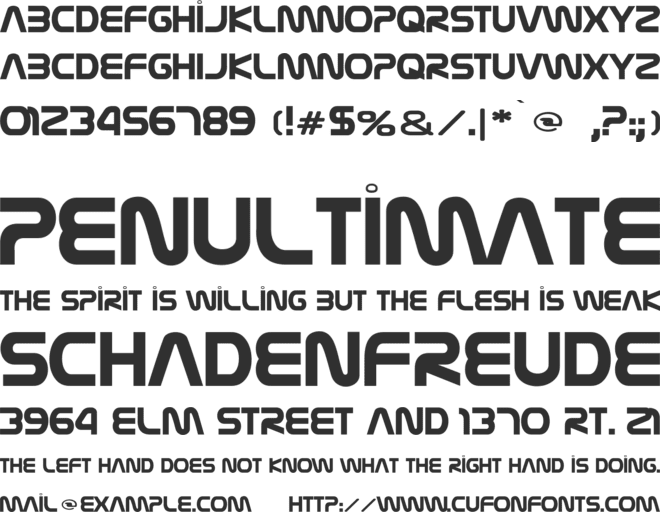
Staveless B is especially interesting. Also check out P and R, and how E reflect B even more.
a be cfi? dgjo?
ci (see?) do (I first saw do across the aisle from be, and then c-i is see, why not, if they wrote whoever
be see do
But I want to have other vowels, and I look for more biliteral verbs: be see go do? be see do go.
be do go see
see/show? is show biliteral? monosyllable it is. technically even see is not biliteral, but then orthography is arbitrary.
go see do in the eastern order.
go sweee
go see do be
is no and yes invertions? yes can be yep. no can be nope. so ye and no are the words.ye's is yours. no's is nos, нас, on us, ours,
on is о? just as they used to write внъ instead of в (which is closer to in! ו=IO
начало и кончало начал и кончи (начала и кончила выдаёт начал и кончил)
если имя прилагательное и имя существительное сливаются, и имена. начала кака натала
кончила кончита но это глаголы. где я прилагательное увидел? начало имя существительное начальна имя прилагательное. Наталья имя собственное. Татьяна тайна? Тайна как тать? татьно? тайно? рать~рай связано с Вальгалой? Валей и Галой? связано это с арабским представлением о рае?
spit as the opposite of bit? с-пить (bit ~ пить!) People didn't have to always kill animals, they could just bite and drink them!!! Like mosquittos! Tought by moscittos!
suddenly.. deer is Ra (dear god)
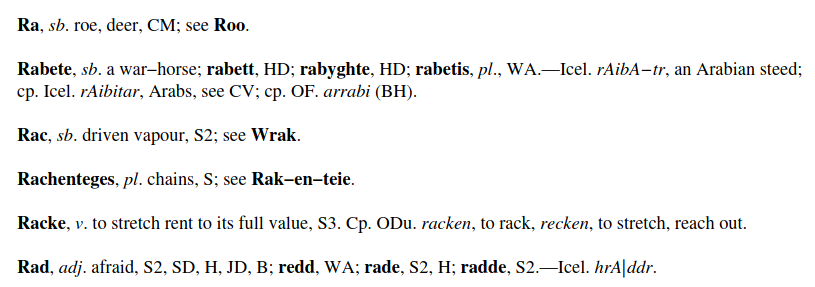
glad is rad [rad] in russian.
hurt is heard (it cries out loud) and thus hurt and heart are ..cognates? they're both heard.
cord is heard
cor is heart in latin and color in portugese (is portugese cor related to hear? like gamut of colours of cords.
t~st: stoit cost
este is это in russian (eto is this eti is these and if english form is the se (se=сии~the. thus these is thethe or the's as is both plural and genetive) -s ~ -st ~ t (along the sea: england, portugal, russia)
c: s, t, ch, k, g, q, all the kin-column is c, c is staveless d, hence g is d in russia. hence it makes perfect sense that h is of c as k is. h is k: ᚴ ~ ᚲ ~ ᚳ (ᚦ)
f~t? θ is both.
fёдор щёдор
флаг стяг штаб
флот шлёт? идёт по морю, от словоа шёл.
фига шига? шиш!
фланг шланг
отчего-то подбирая т-образное отражение фёдора ушёл в ш, ибо ш ~ т (ſ~t) (f~ſ~t?)
ш~т are as halves of θ as f and t because Ѳ ~ Ф
E & З (pretty much how it goes in greek in russian, and 𐌈 was to stand between them, but it is a sign o earth, not sun (maybe because sun is G, but I thouhgt Θ was ☉! is it because sun was pronounced differently in different languages? So they got some double letters for some words (these words are letters in the alphabet) and lacked thus some letters and thus the phonetic syllabary as in spain
Because why would you make it any other way! I don't know how recent the korean script is (it is reported to be based on some of their writers shorthand, and who knows how ancient the roots of that shorthand could be.
I think I'm going down, because I got high.
It's normal, but it explains a lot. And yet it's saturday, and it means that I shouldn't be smoking until monday when I work, saturday and sunday are social days when I have to communicate with other people to make some other project and maybe this one running publicly too.

Eastern Celtiberic syllabary demonstrates graphic order of Ba Ge Du or Ba Ge Gi
Is this arrangement even genuine? Why else would they place G before B?
Notice Ϻ standing for S it also shows that it is probably borrowed letters, like Λ and Ρ and Μ and Ν but then their M is probably of runic descent: ᛠ (but it is transliterated as ea, but then was it transliterated correctly? What do I know other than it looks very much like ᛘ, but then they have ᛘ and they read it as Di which is probably ᛉ) so I drop it here again, because I have to know old-hispanic and celtic and greek to test this hypothesis. I leave it here for somebody who does, please send it to somebody who does.
But some signs from the syllabary form have similar reading as some letters from other writing systems: the Ge like ᚲ, the Pi like Π, the Du like Δ, then Ta could be recognized as 𐤕 and I saved it as image, because in seamonkey it looks differently, it was supposed to look lie this:
Bust most of their signs are like noghting I have saw, maybe Ш-like To is related to that S, but actually I think I saw every other sign in other scripts, but then they all sound differently: ᛟ is translated like vowel o ё е and in hispanic it is be or pe. It is interesting how they distinguish left and right more than up and down as if they were written vertically and could go both ways. But then it is too hooey a topic, so let's move on.
Suddenly I realize that aeiouy structure is even more obscure than aeiou, but that is not a reason not to look into it. Because it is true, as aeiou would be true even if no historic records of it existed.

XYZ are three greek letters, and without it such latin alphabet will look muck like hebrew:

צ as z after v of f פ would be great, especially since they look so similar in coursive, actually very much as coursive y and z:


well, almost like that, only the order are the other way around.
Look how much f reminds b, which is especially notable that c and g following them are technically the same letter. Maybe g is cj? c and ci? why not, but then g would look like s, but does it? only if R (Р in russian) were P. opst would reflect abcd perfectly, and then I recall that QR look like some invariants of OP. and it all makes sense, especially russian (actually greek) Ρ (ПР are like PQR, variative claster)
So I claim that it used to be OPST? But what are my proofs of such a claim? Some historic proofs I'm speaking of. I don't have them, but maybe if we check out archives maybe they're already ther (I wouldn't take seriously artefacts which appear after 2013 when I made this thing public.
Were cathars fighting against addition of two strings to apollo's lyre? Were they fighting for natural pentatonic scale instead of sophisticated or simply jewish mode. christian mode, not exactly jewish, but still fucked up. Not as much as I am though, huh.
another attempt to semantize letters:
a 1
b be
c see
d do
e ex
f if, of
g go
h hi, high (hot = high t°)
i I
j you
k cut, kill, king is killing.
l low law lay lie (felt.. left ~ l'ed)
(few days later being clean returning to this uselses list I didn't even finish then)
m me
n no
o oh
p pay
q que
r are
s is
t it
u you
v you
w you two
x ex
y why
z that
(okay, now it's time to get higher)
and here I am, after few days of not smoking I'm high again, let's see how much revelations method is better than the method of free associations psychologists use. Revelations deliver, associations confuse.
Suddenly I realized I want to call my mom mamushka. Because she is my mom, why must I call her something else. But then it sounds as my мышка, which is gross. So I will call her mom, and let the kids recognize that I speak of my mom and not of theirs, мамочка ещё грязней
не очко, а бал. and suddenly I see that russian бал (очко) шары мячи были очами!!! шар коня! шарик, рщц дщтп вщуы ше ефлу ф пдфыы ещ вусщьзщыую Does it feel like slime or rubber? rubber, of course, but if they remove the film.. why would they remove the film.. if the film rots faster than the glassy inside. Would the glassy inside feel like slime or rubber? I am insane trying to imagine what he never saw, let's leave it unwritten. But I must dissect bodies, but then I will only know dead bodies, not the living ones. I should massage myself by getting message from it.
Интеллигенция обязана быть в авангарде оппозиции. В любой системе. Всегда что-то идёт не так, задача интеллигенции - показывать Интеллигенция - люди занимающиеся интеллектуальным трудом,
There has to be dodecimal system as four-rune dice, the knucklebones. Four like four elements? 4 like something else, which made it obvious to me that if rhombic dodecahedron (and I'm speaking not of bilinski dodecahedron, though it is impressive, I never thought there's a figure like that, and using this new knowledge I found rhombic icosahedron, chances are, because they mentioned it after philosophersstone. But whether it was a distraction, or if that book's author (scan of which piece I translate in vol.12) was influenced by rhombic dodecahedron he saw somewhere in twice 10 sides.
But rhombic dodecahedron is what has 12 sides. And they're in groups of 4 by 3 or in groups of 3 by 4
in four groups by three or in three groups by four, depending on which angle you use for the grouping)
Rhombic dodecahedron probably was a sophisticated die. Did they guess if the prisoner is to live or to die by throwing lots? by drawing lots?
кидать жребий
жребий
переводится как lot, fate, draw
three fates
three ides? (id was a typo I was to type dies)

But I didn't find much on what Ide is other than it is translated like язь (maybe because it's idus) but in all the other internet it is..
An integrated development environment (IDE) is a software application that provides comprehensive facilities to computer programmers for software development. An IDE normally consists of at least a source code editor, build automation tools and a debugger. Some IDEs, such as NetBeans and Eclipse, contain the necessary compiler, interpreter, or both; others, such as SharpDevelop and Lazarus, do not.
The boundary between an IDE and other parts of the broader software development environment is not well-defined; sometimes a version control system or various tools to simplify the construction of a graphical user interface (GUI) are integrated. Many modern IDEs also have a class browser, an object browser, and a class hierarchy diagram for use in object-oriented software development.
but that's internet, yet https://en.wikipedia.org/wiki/Ide_(fish)
The name "ide" is from Swedish id, originally referring to its bright colour (compare the German dialect word Aitel, a kind of bright fish and Old High German Eit, funeral pyre, fire).[3] The alternative name "orfe" derives from German Orf, through the Latin orphus meaning a "sea fish" or "sea perch", which in turn derives from the Greek orphōs.[4] The generic name Leuciscus is derived from the Greek word leykiskos, which means "white mullet".[5]
though I don't see how they pulled it onto funeral pyre, etymology is only half science, at best.
and here's the ides there are:
ides (n.)
"middle day of a Roman month," early 14c., from Old French ides (12c.), from Latin idus (plural) "the ides," a word perhaps of Etruscan origin. In the Roman calendar the eighth day after the nones, corresponding to the 15th of March, May, July, and October; the 13th of other months. "Debts and interest were often payable on the ides" [Lewis].
then that idus fish, the etymology of it I wonder how they knew that it was of swedish and not latin origin, it is probably common indoeuropean so they can pull it through every modern language, any such conclusion is pretty meaningless, because the name of the language applies to modern language, and origins of words are mostly in prehistoric times.
I don't know where did they get idus and why did they placed the mark of plural onto that form standing in singular form,
In Greek mythology, two sacred mountains are called Mount Ida, the "Mountain of the Goddess": Mount Ida in Crete, and Mount Ida in the ancient Troad region of western Anatolia (in modern-day Turkey), which was also known as the Phrygian Ida in classical antiquity and is mentioned in the Iliad of Homer and the Aeneid of Virgil. Both are associated with the mother goddess in the deepest layers of pre-Greek myth, in that Mount Ida in Anatolia was sacred to Cybele, who is sometimes called Mater Idaea ("Idaean Mother"),[1] while Rhea, often identified with Cybele, put the infant Zeus to nurse with Amaltheia at Mount Ida in Crete. Thereafter, his birthplace was sacred to Zeus, the king and father of Greek gods and goddesses.[2]
Mount Ida (Greek: Ἴδα),[3][4] known variously as Idha, Ídhi, Idi, and Ita (the massif including the mountain is called Psiloritis, Greek: Ψηλορείτης),[5] is the highest mountain on the island of Crete, with an elevation of 2,456 metres (8,058 ft). It has the highest topographic prominence of any mountain in Greece.[2][6] A natural park which includes Mount Ida is a member of UNESCO's Global Geoparks Network.
Located in the Rethymno regional unit, Ida was sacred to the Titaness Rhea in Greek mythology. On its slopes lies one of the caves, Idaion Antron, the Idaean Cave, in which, according to legend, the god Zeus was born. Other legends, however, place his birthplace in Psychro Cave on the Lasithi Plateau.
An archaeobotanical study was conducted that looks at the different plant bases in Minoan villas during the Neo-palatial time period in Crete. There was a rich range of food plants that were found to contain essential nutrients like carbohydrates, protein and vitamin sources.[7] The study took place on Mount Ida, at the Minoan villa of Zominthos.
Psychro Cave (Greek: Σπήλαιο Ψυχρού) is an ancient Minoan sacred cave in Lasithi plateau in the Lasithi district of eastern Crete. Psychro is associated with the Diktaean Cave (Greek: Δικταῖον Ἄντρον Diktaion Antron), one of the putative sites of the birth of Zeus. Other legends place Zeus' birthplace as the Idaean Cave on Mount Ida. According to Hesiod, Theogony (477-484), Rhea gave birth to Zeus in Lyctus and hid him in a cave of Mount Aegaeon. Since the late nineteenth century the cave above the modern village of Psychro has been identified with the Diktaean Cave, although there are other candidates, especially a cave above Palaikastro on Mount Petsofas.[1]
What I get out of it is that Crete is Grece and probably etymologically too.
The highest mountain of all Greece, the birthplace of Zeus. Wow! And I never ever heard of it, I found it looking for what Ides are. Goddesses. were there three Ides? No, but Kalenda Nona Ida could be the three mothers. K first telling that eastern canon is more ancient.
The Idaean Cave (Greek: Ιδαίο άντρο) is a system of caves located on the slopes of Mount Ida on Crete (35.2082°N 24.8290°E). The deep cave has a single entrance and features stalagmites and stalactites.
In antiquity it was a place of worship because it was believed to be the cave where the titan Rhea hid the infant Zeus, to protect him from his father Cronus, who intended to swallow him like others of his progeny. It is one of a number of caves believed to have been the birthplace or hiding place of Zeus.[3] According to a variant of this legend, the Kouretes, a band of mythical warriors, undertook to dance their wild, noisy war dances in front of the cave, so that the clamour would keep Cronus from hearing the infant's crying.
Excavations have revealed a large number of votive cult offerings on the site.
"Cave of Zeus" may also refer to a cave on the Aegean island of Naxos or to the Psychro Cave.
here's Psychro Cave:
yep, that's an excavator there, my old idea to dig caves, archaeologically. but who tells we can't make it and otherwise. Not in places like this though:

Psychro Cave (Greek: Σπήλαιο Ψυχρού) is an ancient Minoan sacred cave in Lasithi plateau in the Lasithi district of eastern Crete. Psychro is associated with the Diktaean Cave (Greek: Δικταῖον Ἄντρον Diktaion Antron), one of the putative sites of the birth of Zeus. Other legends place Zeus' birthplace as the Idaean Cave on Mount Ida. According to Hesiod, Theogony (477-484), Rhea gave birth to Zeus in Lyctus and hid him in a cave of Mount Aegaeon. Since the late nineteenth century the cave above the modern village of Psychro has been identified with the Diktaean Cave, although there are other candidates, especially a cave above Palaikastro on Mount Petsofas.[1]
The Dictaean Cave is famous in Greek mythology as the place where Amalthea, nurtured the infant Zeus with her goat's milk. The archaeology attests to the site's long use as a place of cult worship. The nurse of Zeus, who was charged by Rhea to raise the infant Zeus in secret here, to protect him from his father Cronus (Krónos) is also called the nymph Adrasteia in some contexts.[2] It is one of a number of caves believed to have been the birthplace or hiding place of Zeus.[3] The mountains, of which the cave are part, are known in Crete as Dikte.
The name Amalthea, in Greek "tender goddess", is clearly an epithet, signifying the presence of an earlier nurturing goddess[1] or maiden-goddess[2] whom the Hellenes, whose myths we know, knew to be located in Crete, where Minoans may have called her a version of "Dikte".[3]
Amalthea's skin, or that of her goat, taken by Zeus in honor of her when she died, became the protective aegis in some traditions.[14]
Ἀθηνᾶ (here I marked lingual n with red as if it indeed is fire, as sefer Yetzirah tells, which is hm.. Because I think I recognized n like labial in ides nones kalends, even if I didn't utter it, I did)
A-Po-LLo
A-Fee-Na (this is how we russians read it, I'm pretty sure that's how greeks do)
G-translator may dislike that diacritized spelling, so here's it without dots for you: Αθηνα
In ancient Greek religion and mythology, the twelve Olympians are the major deities of the Greek pantheon, commonly considered to be Zeus, Hera, Poseidon, Demeter, Athena, Apollo, Artemis, Ares, Hephaestus, Aphrodite, Hermes, and either Hestia or Dionysus.[2] They were called Olympians because, according to tradition, they resided on Mount Olympus.
Although Hades was a major ancient Greek god and was the brother of the first generation of Olympians (Zeus, Poseidon, Hera, Demeter, and Hestia), his realm was the underworld, far from Olympus, and thus he was not usually considered to be one of the Olympians.
Besides the twelve Olympians, there were many other cultic groupings of twelve gods.
Aphrodite also has alphabetic name. And there are two more names beginning with A, which is unproportionally many, and thus A could be a honorific prefix, and it correlates with the guess of B being the first letter, and A being added later when one was recognized as a number.
Looking at this table of brahmi script I think to myself that it's too complicated and thus is of later origin than ogham and even celtiberian syllabary. This one having so many letters many of which have some similar shapes in other writing system. Like the A 𑀅 pretty much like in hebrew 𐤀 if you see the K-ness in them both, I wish unicode have more fonts
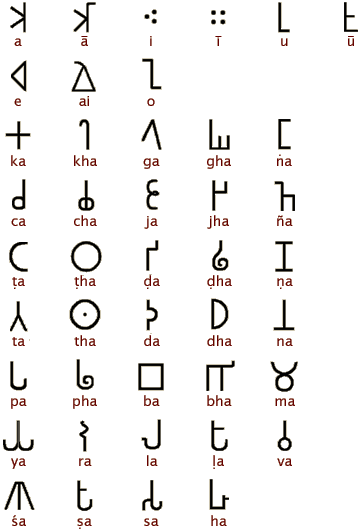
Either way, these
𑀕 for ga looking like 𐤂,
𑀗 for na looking like נ,
𑀚 looking like З and even more like E (but I chose З because of how it sounds, so how biased am I)
𑀛 looking like Ч and sounding like its voiced counterpart.
𑀝 looking like C remind again how much similar are S and T, but here it is C sounding as Ч~T
𑀞 which sounds almost like 𑀝 reminds thus σ
𑀣 which looks like Θ and sounding alike, they also look like 𐰧 which is transcribed as -nt which is not that far from Θ so first I need to hear it and not just read the transliteration, second I need to leave here a weak bond so that an algorithm which will take over this research could entertain this possibility.
𑀥 looking like D and sounding alike
Do 𑀠 and 𑀨 remind b and c?
Do 𑀧 and 𑀨 remind p and f? Does 𑀧 remind upsided-down archaic П which had the right leg shorter?
Does 𑀫 tell that ᛘ is a cow?
Does 𑀬 remind Y?
Doesn't 𑀭 the way it's drawn in the table above remind staveless ᚱ?
Do 𑀮 and 𑀱 remind L or am I tripping? Oh gush, 𑀱 is not that la with a dot below it, it's sa with a dot below it (not from the second from the bottom, but from the bottom line, I wonder how they distinguished between those, but unicode representations below that they probably had no problem with it, that the creator of that table had some, or maybe he was also write just using some differnt font of the same brahmic writing system. I am such an amateur)
Do 𑀮 and 𑀴 remind L or am I tripping? And once again I notice that SeaMonkey and FireFox display this font differently.
SeaMonkey:
Firefox:
As you can see, they mostly agree except those few letters that L and that Ш and firefox recognizes R as straightline, which makes me trust seamonkey more, but then I know I should question everything.
A U I is alphabetic alignment of the alphabet and it is how it is in ogham. And I tried to read it and I've got french translation of that magic Oh Yeah which I recognized as vowel exclamation combining all the vowels: ow jea +h which is whether vowel or not, but prin.. priests of apollo (princes of appollo? they probably were brides of apollo before the faggots took over)
Oh oui is oh yeah in french. O U I, no wonder french sounds almost chinese alien, half of chinese alien, and they're darker than us. Indoeuropeans? Aryans? Are these two words merely political alignments of arranging concepts in such a way that we would include jews into our number. Though for us they will always look like чурки ебаные и в этом проблема с белыми, о которой они всё время говорят. Мы слишком крутые, а потому слишком заносчивые, мы обижаем другие народы и даже не замечаем этого. Словно лишь наши жизни имеют значение. Это серьёзная проблема, и на самом деле серьёзный косяк с нашей стороны.
что если финикийцы это перефоршенное филипинцы
A aa OO e EE
A aa(o) OO(u)
e EE(i)
and this is exactly the order of oghamic vowels
I was in a bath and as I went out I thought about my subconsciousness wanting the operative memory to calculate something. And I closed my eyes and allowed it to use it for I didn't need it for few moments, yet I always leave place to stand up, so I need the capsule to lay in even for this. So I saw ideas bouncing in my inner sight and soon (few seconds later it all stopped and only some lights all over my inner skulll shined in all sorts of colours dimly to indicate that they're ready to deliver, I only had to sit here to tell it and okay, my eyes aare closed, speak, I need to remember what I was thinking about first, because I was busy for many minutes after that. I forgot about the message. Okay, let's go on, and we'll inevitably meet it.
A B C
A U I
A V 𐌆
𐌆 is archaic greek Z but indeed it also looks like T, which makes B В[v]
A V T
That Ides word tell me that Isis is simply Godd-ess (isa is both female and plural is, just as isis is is's)
Ida, not Isa, but here I see that Isa, some man was named isa? Like Дмитрий is Деметрий, родительный падеж множественного числа.
AVI. Another time I meet I as T.
ABCD
EFGHT
if H is ʃ ~ š ~ s, I~T~Z makes perfect sense. Я ~ Аз, and I suspect A to be the final letter, and how it is in norwegian today:

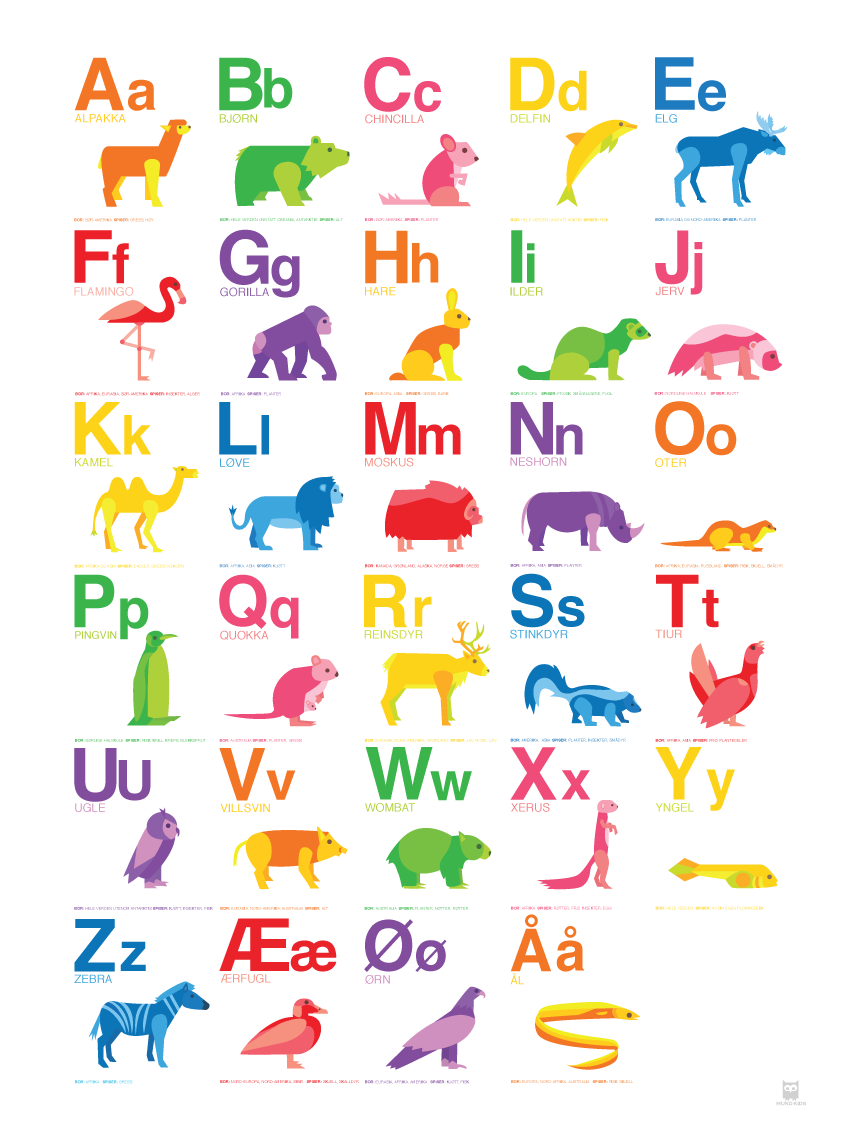

I had a dispute with a lady about if the goddes is three-fold or four-fold. She told that new moon is also a phase, I said that I know that, but did the ancient people understand it? She was more pro-ethnic thing, so she probably believes that ancient people knew more than we do. I agreed that maybe they knew about some aspects more, like of hunting or agriculture, but I surely know a lot more than they do in some other aspects. I think she silently agreed. And now I see the argument towards the tiple goddess: what is the sign of the fourth mother? There is only three signs we know: ☽︎ ◯ ☾
The new moon is no moon. It is how new and no meet. новая=невидимая.
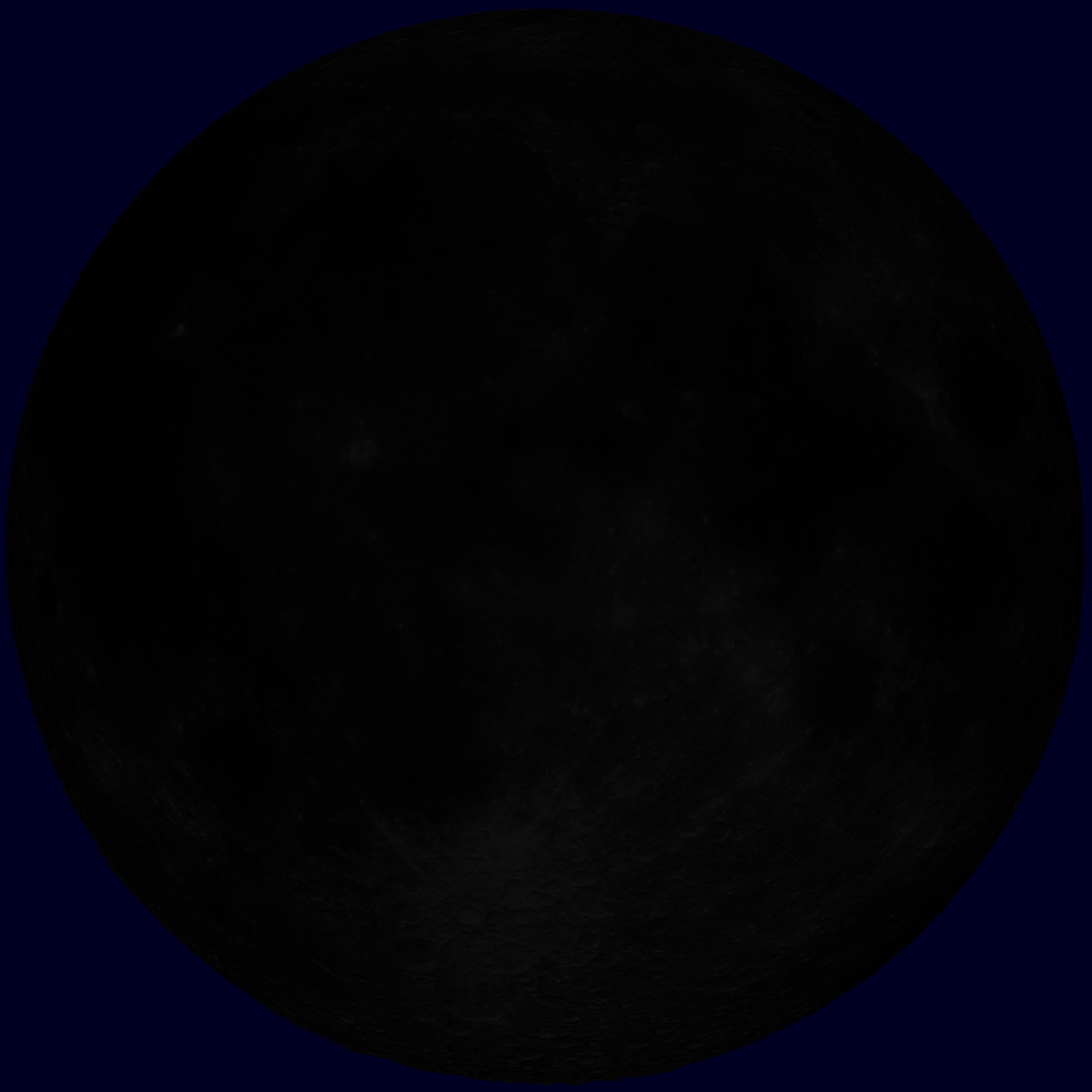
and I noticed that this year is special, because
2 января 2022 в 13:33 Луна в Козероге Солнце в Козероге
1 февраля 2022 в 00:45 Луна в Водолее Солнце в Водолее
2 марта 2022 в 12:34 Луна в Рыбах Солнце в Рыбах
1 апреля 2022 в 02:24 Луна в Овне Солнце в Овне
30 апреля 2022 в 16:27 Луна в Тельце Солнце в Тельце
30 мая 2022 в 07:30 Луна в Близнецах Солнце в Близнецах
28 июня 2022 в 22:52 Луна в Раке Солнце в Раке
28 июля 2022 в 13:54 Луна во Льве Солнце во Льве
27 августа 2022 в 04:16 Луна в Деве Солнце в Деве
25 сентября 2022 в 17:54 Луна в Весах Солнце в Весах
25 октября 2022 в 06:48 Луна в Скорпионе Солнце в Скорпионе
23 ноября 2022 в 17:57 Луна в Стрельце Солнце в Стрельце
23 декабря 2022 в 05:16 Луна в Козероге Солнце в Козероге
And here I notice that the new year which is march equinox being in fish which is next to aquarius could be what all that hype about and indeed:
The Age of Aquarius, in astrology, is either the current or forthcoming astrological age, depending on the method of calculation. Astrologers maintain that an astrological age is a product of the earth's slow precessional rotation and lasts for 2,160 years, on average (one Great Year equals 25,920-year period of precession / 12 zodiac signs = 2,160 years).[1]
There are various methods of calculating the boundaries of an astrological age. In sun-sign astrology, the first sign is Aries, followed by Taurus, Gemini, Cancer, Leo, Virgo, Libra, Scorpio, Sagittarius, Capricorn, Aquarius, and Pisces, whereupon the cycle returns to Aries and through the zodiacal signs again. Astrological ages proceed in the opposite direction ("retrograde" in astronomy). Therefore, the Age of Aquarius follows the Age of Pisces.[2]
When the moon is in the seventh house
And Jupiter aligns with Mars
Then peace will guide the planets
And love will steer the stars
This is the dawning of the age of Aquarius
The age of Aquarius, Aquarius
Harmony and understanding
Sympathy and trust abounding
No more falsehoods or derisions
Golden living dreams of visions
Mystic crystal revelation
And the minds true liberation
Gnostic philosopher Samael Aun Weor declared February 4, 1962 to be the beginning of the "Age of Aquarius", heralded by the alignment of the first six planets, the Sun, the Moon and the constellation Aquarius.[19]
Samael Aun Weor (Hebrew: סמאל און ואור; M
notice how ו in ואור sounds like W before vowel and like O before consonant.
𒉽 nothing 𒑊 radix point
𒁹 1 𒌋 10
𒈫 2 𒎙 20
𒐈 3 𒌍 30
𒐼 4 𒐏 40
𒐊 5 𒐐 50
𒐋 6 𒄭 60
𒑂 7 𒀪 3600
𒑄 8 𒄯 216000
𒑆 9 𒋦 46656000000
Base 420 is better. 69^69 is congruent with 69 mod 420.
I just copied this interesting lines from a thread before I closed it. They are some random chapter, but like some of those random pictures showing to be useful in later volumes, I will probably return to this thing knowing more about it.
Looking at how oh oui repeats the sequence of oh yeah until that e, suddenly I had a feeling that oh oui expresses such magic feeling that it is probably chronological in the sense of those vowels appearing in the speech, and I can see that it is supported by ау[au] and aum and amen which is reported to be read by essens as aumin. And it is oum, for it's oh oui, and because a is final in oh yeah telling that it appeared the last of the five (and h is of the other two making the overall number of vowels seven)
ieoua (which raises an important question about if bible was written in hebrew, and though I heard an opinion that modern torah is a reverse translation from septugiant, I couldn't find it, so it maybe not)
The oldest manuscripts of the Septuagint include 2nd-century-BCE fragments of Leviticus and Deuteronomy (Rahlfs nos. 801, 819, and 957) and 1st-century-BCE fragments of Genesis, Exodus, Leviticus, Numbers, Deuteronomy, and the Twelve Minor Prophets (Alfred Rahlfs nos. 802, 803, 805, 848, 942, and 943). Relatively-complete manuscripts of the Septuagint postdate the Hexaplar recension, and include the fourth-century-CE Codex Vaticanus and the fifth-century Codex Alexandrinus. These are the oldest-surviving nearly-complete manuscripts of the Old Testament in any language; the oldest extant complete Hebrew texts date to about 600 years later, from the first half of the 10th century.

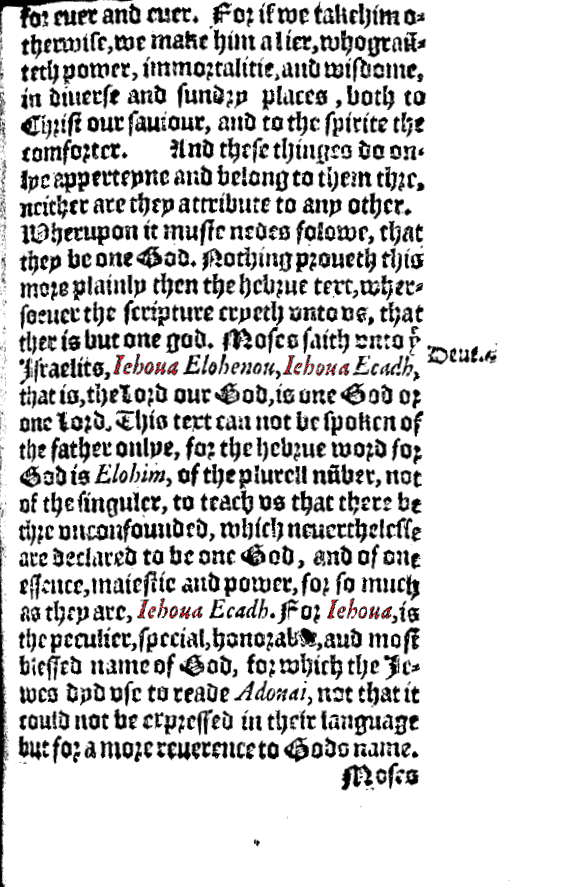
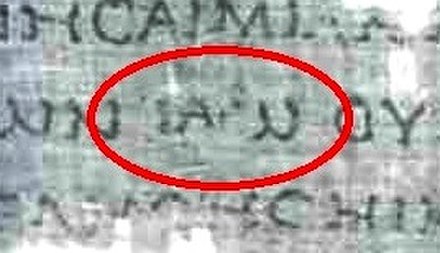
now if these words are the same, then in the trigrammaton form A is read as Э, and ω is read as owъ
And so I'm looking to collect all the bird language (the phrases made exclusively of vowels)
o u i e a (oh yeah)
o u i (oh oui)
yo!
yee-huh!
(mirror)
though that pronounced h in there makes me question inclusion of it into the set. Only if it's vocal ha, like in hahaha, the way I was explained to yell it properly: the highest yi you can give and ha as in laughing, so it's probably best when it's natural, genuine, true and automatic, instinctive, some yell I haven't yet heard. One of the best yells and it's usually fake, pretence, though when I really liked it, it was yelled real good, by some fan on spb die antwoord concert. I doubt that fan was russian, because it was a real good yee-ha! and it's all about vowels, and accent is also about vowels
а я у её о ей и ею (я ~ ей (is russian им plural suffix in hebrew? in russian it's both genders, in hebrew it's plural, but I think they said to me it was the other way around in the past, I wonder if it's true and why would tranny hebraists switched it if it is))
I ~ ja (jij, je)
we ~ you (U)
It is the guess I had before I went to sleep, that pronouns in second person are pronouns in first person put in reverse. Which sorta contradicts my previous guess that second person is wheter first or third person, or maybe it can combined and united with it, I will ponder on it later.
f as long p
t as long l
L as flipped П(𐌐)
VB and Š(t)
L(b) and 𐌐(r)?
ab(c) d
op(qrs)t
if c is k, then q is redundant, and maybe this is why russians and greeks don't have it. But they have many other letters, and one of those letters is probably q pronounced differently.
Big and tiny?
Большой и талюсенький? Hey! I substituted m[m] for т[t] точка
nm [nm] look like пт [russian pt] and they meet in querty keyboard: english n[n] shares key with russian т [t], but others don't meet more than russian мн are vy and I think this is apophenia speaking, or some conspiracy of those who knows. Apophenia is more simple explanation, so be it marked as such, dismissed.
Nah, I could find many lexics for any case, it's all ad hoc most of the time, I have to collect those few pieces who rar are not. They are not few, I suppose, they're at least several.
It is really incredible that I for some reason chose icelandic version of them all years before I knew about ieoua and it is (unlike the original version) utters Oh! O IEOUA but then it just sings what the picture draws, and the picture is from the original, and I think I have some confirmation bias, because according to letters he sings O! U EIOA and in english it only spells it in the weird english manner, who knows if it was how Carroll intended it to be. Did he even have it? He had not.
(mirror)
Sonors are voiced consonants which don't have voiceless counterpairs.
There are some voiceless letters which don't have voiced counterpairs.
Let's try to pair them:
a b c d
e f g h
i j k l m n
o p q r s t
u v w x y z
j r l m n
h x
yep, not very much to pair. But I was thinking about russian ч as a candidate to reflect r
а б в г д
е ё ж з
и й к л м н
о п р с т
у ф х ц ч ш щ
ъ ы ь э ю я
й л м н р
х ц ч щ
and also because р(r) is connected with ч graphically, х(h) may reflect н(n) because H looks like Н
and we have й л м across ц and щ. And I dismiss й(j) as a form of и(i) and I have л м reflecting ц щ and graphically it's obvious that ц reflects л and щ reflects м, because M looks like double Λ and both ц and щ have that comma to them, and one looks like a double form of the other. And the sequence хцчшщ maybe tells that the reflection is нлржм, which doesn't ring a bell. Let's try it the other way around: лмн р reflect цщх ч, and even if we place р[r] somewhere else, it will still be chaos, so it's another nothing burger so it seems, but then are other letters reflecting eachother positionally too? velars do. others? also so. p under b, t under d, v and f in the same labial column, z and s are both towards the end of their lines, but then it's a pull, but it's a minority deviation, and s~t thing explains it well. It's in english, but would I be able explain it in russian? У-line is definitely a mess, but then isn't U-line too? Until T it's much more coherent:
А Б В Г Д
О П Ф К Т?
O P Q T.. but that's some fucking liberty, but then that is not, since latin doesn't have В[v] in the first line, only Б[b] and thus
A B G D (because I had to change C into G, which is told to be historically the case, but it's)
O P Q T (still not very cool, so that I think I will look at it in greek variant)
ΑΒ ΓΔ
ΟΠΡΣΤ (and just like in english QR seem to be invariants of OP, here Ρ(r) is a form of Π(p)
ΥΦΧΨΩ (if Β is not b, but v, but then still too many questions appear, like with armenian I believe new letters being added as the alphabet grew from at least 15 to whatever they're now, and destroyed the structure, but then Ψ reflecting Δ makes me think how Δ is ð, which makes ψ similar to θ and indeed θ's being between f and θ is very similar to ψ combining both p and s)
Three periods of human life are child adult old
Three periods of human life are sleep high awake
woke is grammatically incorrect, it's probably wok
A wok is a deep round-bottomed cooking pot that originated in China. It is common in China and similar pans are found in parts of East, South and Southeast Asia, as well as being popular in other parts of the world.
lefteist movement is preparing languager reform as any large reform included change in writing.
And I realize I have some great product
2 ~ 3 are changed into 14 15 with exactly tweo strockes (more liberties in lagnuage is my counter-reform to see what they wrote like. People would have not one standard form but a range of forms like standart stantard and so on, all the possible fvariations (and if it was official document, it would meed some old form like church litugries are all read in old form of the language. So this iberty (yea, where do you allow the script? I just make language more poethic, people would write the same word differently and thus would have poetry with less affort. Were the most ancient poems writiten of cognates? I may just collect all
Natasha in reverse is ah Satan
Tatiana in reverse is anna Tat
natka i tatka?
natka & tanka!
satan nathan? Than? Ten? thor? я охуел. слишком много вольности.
thot as the opposite of satan? Deus = Devil? Gnostics are confusing things a little: why would I take all their doctrine if I only accepted that god is not good. Gnostics walk only half of the path: they agree with epicurean proof that omnipotent benevolent omniscient god is a complex oxymoron.
So they acccept that one of that things must be false, and if there were god so powerfult that he created the world he must be smart and strong, thus because evil exists the god itself is evil, but then they cannot walk the full path of accepting that maybe that concept of trinity being the creating god (confuzing not directly connected abstract conceptions to get an even more abstract construction, and then believing in that concept existing in the real world. Math instead of actual science. Mindplays, useless sophistications for those who are not smart enough to be scientists. Now if we get the technology of making people smarter, we may give them that extra wisdom so that they are able to think deeper than two moves, and thus to see the complex oxymorons being wrong and thus cure themselves from their delustions, but then only to fall into the academic delusion.
(and here I wanted to group people in relation of how many levels of cognition they have, and beginning with idiocy I noticed that debils are already few levels, to even read books it takes a little more, and then variability makes it pretty impossible to distinguish educated moron from a natural fool so to say, and that the graph would be at least in 3d, and maybe if we add time as how their personalities were we have to have it in 4d (movies? movies are 3d because they project 3d world into 2d screen. Videogames can be in 4d (when they're in 3d the time is fourth) so I got distracted, the same happened in there even before I realize that it is futile and understanding of books and understanding of not shitting ones pants are to be at two different graphs, and these different levels would make spectre of personalities (because I heard there are some autists who shit their pants but may make soemting unusual.(isn't that soem ting instead of something bother my way of reading the text, when words cantouch (catch) my eye distracting my brain pw power from understanding the underlying thought.
How do you think we know what berries not to eat? These technologies are being tested by those who don't give a fuck because they have not much to lose because there's not many options on the market so far. To die in the name of science is the most glorious way to go, and if this heroic move can deliver you the grail, the grail everybody will drink from, when even believers adore it because it's the eternal bliss they kinda promised, prophesied, prophesized, They will just reinterpret the "son of man" thing as obvious collective word for human race.
prophesized is another form of prophesied (more random one, but it may tell that suffix sie is probably size with banned out z)
prophesy ~ предсказать ~ пред сказать ~ prophe say.
prophe ~ пред ~
хардкор это жёсткие коры
юлька волка
rude rough
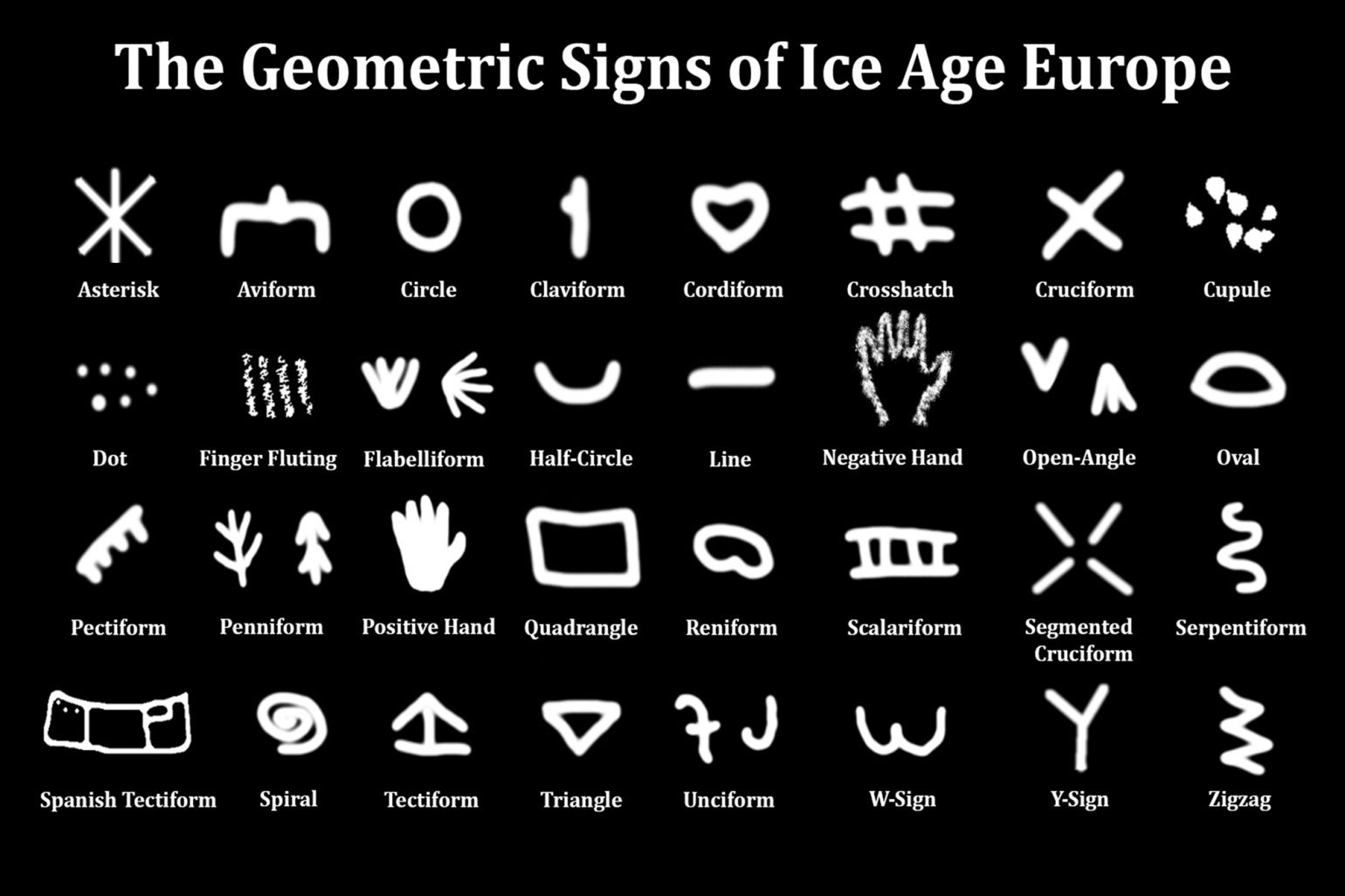
And I'm glad that somebody made this work for me, now I have to read her book to interwave it into my thing
here come the thoughts I had during writing that letter I mentioned in the beginning of this volume:
..паханата
Паха Ната (ah Satan & Ah хап (нахап нахрап))
пахаНАТ кагаНАТ
native? talan natal? NATion! Народил
natal talant
род дар
tal = Д
Д = Л+Т (the middle stroke within T is probably stave, because in glagolythic it was Ⱅ and this is some high form of it, usually it is the lower part of Ⰾ)
N = R? N ~ L?! both three are sonors
пони ~ пониже
понимаю ~ under stand
дворянство извирающее царя
б~в: бери верни, далю делю - не потому ли русские как индейцы возвращаются за подаренным чтоб забрать?
пони маю ~ under stand
маю ~ имею (имею разумение, например)
понимаю ~ поднимаю (маю ~ имаю ~ нимаю? ни это корень? ни как в ним? под ним аю(I in some dative case? but it doesn't make any sense. But was called a word you shouldn't use. But ~ butt, as ~ ass, как ~ какать, analyze, associative, assistent)
analyst analyzed
associative associate've
I think I wrote about these suffixes before. I should create a file about suffixes. But then some of them are prefixes, I have to make text abpout these particles, but I think I will speak about them when I write about those 200 cognates.
yes no
dich choe
dick hole
boy girl
these six are two words (semantically) words we use only allow to
жен щина
муж чина
(китайский суффикс? китайцы им себя называют? в японском есть такой суффикс в использовании для названия человека совершенно точно. родственен суффиксу нин (росиянин, 浪人 [ronin])
Though chinesae -0japanese don't use spacebar except it's integrated into their punctuation: 、, ・。
BC
DF
this way BD (T~D) and FC (B~F, C~T) and you'll see few lines later why it's great that V reads as F
Ace (like in Asgord)
Kuning (Key nunc, co- nunc (with whom we're now), C (egyptian ka) nunc, в каком ключе, ка = call and this is one of the first meaningsd I saw in this word when it came to mwe few hours or an hour ago.
Kvinna
In Norse mythology, Asgard[1] (Old Norse: Ásgarðr [ˈɑːsˌɡɑrðz̠]; "enclosure of the Æsir") is a location associated with gods. It appears in a multitude of Old Norse sagas and mythological texts.[2] Some researchers identify Asgard as one of the Nine Worlds surrounding the tree Yggdrasil.[3] Norse mythology portrays Asgard as a fortified home to the Æsir tribe of gods, located in the sky.[4] Asgard consists of smaller realms that individually do not appear as frequently in mythological poems and prose.[5] Ancient Norse eschatology envisages the total destruction of Asgard during Ragnarök, and its later restoration after the world's renewal.[6]
Asgård (muinaisnorjaksi Ásgarðr, engl. Asgard) on skandinaavisen mytologian toisen jumalsuvun, aasojen (Æsir), asuinpaikka. Asgård jakaantuu 12 tai useampaan piiriin, muun muassa Odinin ja taistelussa kuolleiden soturien asuinsijaan Valhallaan sekä Thorin valtakuntaan Thrudheimiin.[1] Snorri Sturlusonin mukaan maailma on jakautunut yhdeksään maailmaan, joista Asgård sijaitsee ylimpänä. Maailmoja yhdistää elämänpuu Yggdrasil.
Asgårdin muurit rakensi jättiläinen, jolle luvattiin palkinnoksi Freija-jumalattaren käsi, aurinko ja kuu, jos tämä vain suoriutuu työstä kuudessa kuukaudessa. Yksi aasoista, Loki, muutti itsensä tammaksi houkutellakseen jättiläisen työhevosen, Svadilfarin. Tämän johdosta työ ei valmistunut ajoissa ja jumalat välttyivät maksulta.
Asgård on yhteydessä Midgårdiin, ihmisten valtakuntaan, Bifrostin eli sateenkaarisillan välityksellä.[1] Siltaa vartioi Heimdall. Asgårdin keskus on niitty Idavoll, jossa aasat tapaavat keskustellakseen tärkeistä asioista (miespuoliset jumalat Gladsheimin salissa ja jumalattaret Vingolfin salissa). Asgårdissa sijaitsee myös Odinin Valhalla, jonne taistelussa kuolleet soturit päätyvät, sekä Urdin lähde, josta Yggdrasilin yksi juurista ottaa ravintoa.
Gylfaginning-tarinassa ("Gylfin harhanäky") ruotsalainen kuningas Gylfi matkustaa Asgårdiin, missä hän tapaa kolme valtaistuimella istuvaa aasaa, jotka kertovat vieraalleen myyttejä jumalmaailmasta.
Åsgard (norrønt Ásgarðr) er i norrøn mytologi staden som gudane eller æsene bygde til seg sjølv, midt i Midgard. Menneska skulle ikkje kjenna seg åleine og forlatne. Her budde òg disene eller åsynjene.
Åsgard er ei stor gudeborg, med tjukke murar. For å koma dit må ein ri over regnbogen, eller Bivrost- brua. Kring Midgard vart det reist sterke borgverk. Utanom herjar mørke krefter. I Utgard og Jotunheim, bur jotnar og troll. Slik er alt skipa: lik årringar i tre. Og ytst på alle kantar er det store verdshavet. I verdshavet bur Midgardsormen.
Midt i Åsgard har gudane sett eit asketre, Yggdrasil. Ei av røtene ligg i Åsgard, ei anna i Jotunheim, ei tredje i Nivlheim. Greinene strekkjer seg så langt ut at dei femner kring heile verda. Yggdrasil er sentrum i verda, og så lenge treet er grønt og frodig vil ho vera til.
Ved ei kjelde i Åsgard lever det tre lagnadsdisene. Namna på desse er Urd, Verdande og Skuld. Dei vert kalla norner. Nornene kjenner lagnaden til kvar levande skapnad og veit korleis det vil gå med alt og alle.
Asgård (fornisl. Asgarðr,[1] svenska dialekter Åsgård. Äldre stavning, Asgard/Asgarth), är asarnas hemvist i nordisk mytologi. Den beskrivs i Den prosaiska Eddan.
I nordisk mytologi er Asgård (Godheim) den verden hvor guderne (både aser og vaner) bor. Udenom Asgård ligger Midgård og Udgård (Jotunheim).
Indgangen fra Midgård til Asgård er over regnbuen Bifrost, der bliver bevogtet af Heimdal.
Ásgarður er heimili ásanna í norrænni goðafræði. Þar er að finna hallir þeirra og í miðju Ásgarðs er Iðavöllur sem er samkomustaður goðanna. Inngangurinn í Ásgarð er um Bifröst sem Heimdallur verndar.
I wonder why it tells much more in finnish than in dansk or icelandic about it.
It seems like these two signs are the main ones in the knitting,
and they are extremely similar to B and T
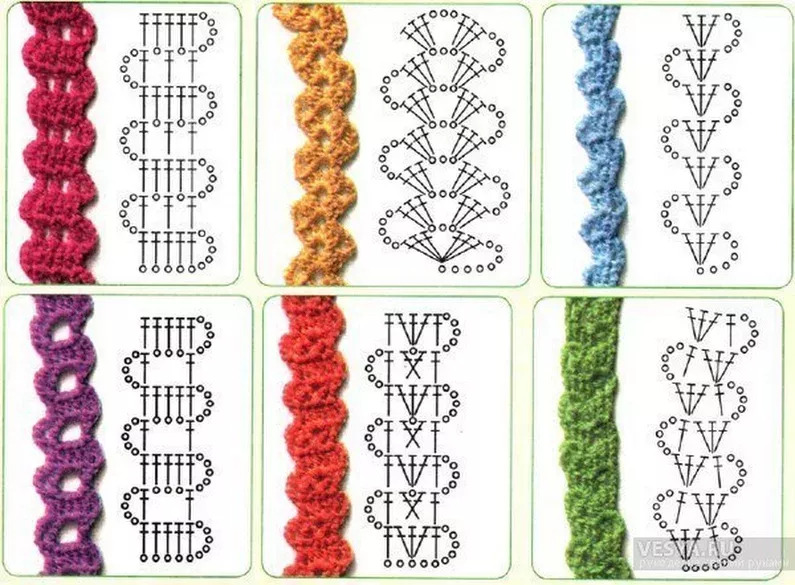
B there is more explicitly a hole, a loop?, and it would explain their T having two additional strokes just us the male thing has two balls attached to it.

and watching the sign for A, I wonder why is it such an obvious V?

and all of the sudden.. 𐌞 and u in bus read like ʌ and v in runes looks like ᚢ and there's also ᚣᚤᚥ
that previous line referred to ♈︎
and let's entertain this thought:
♈︎ A
♉︎ B (T)
♊︎ G (T)
♋︎ C
♌︎ L (I)
♍︎ M (V)
♎︎ S (L)
♏︎ S
♐︎ S
♑︎ C
♒︎ A
♓︎ P
I can definitely see some trace of alphabetic sequence in this thing, some definite ABC in the beginning and some LMSamekh right after it and then some many forms of samekh and OP maybe? I wonder what was the ancient zodiac, but then four vowels per three shapes each line would make perfect sense, and thus I simply do not know in what language was the alphabet invented, but once I dind zodiac constellations named in more alphabetic order I will know in what language the alphabet was invented.
I can see the trace of it because the languages are related and the first numbers are memorized more easily, and then they use synonyms they know.
for whatever reason, ♈♉♊♋♌♍♎♏♐♑♒♓ and ♈︎♉︎♊︎♋︎♌︎♍︎♎︎♏︎♐︎♑︎♒︎♓︎ are different unicode, and the common database only collects the first group and then it recognizes them in both, but signs from the second group are not recognized as the first one. weird. really very weird. I think I found some weird doublet in the unicode tables. I will report it to them if I meet them or they probably know it, but deicided not to discontinue the set some people happen to use.
I believe that is because only SeaMonkey depicts them as one and FireFox recognizes the first group as coloured shapes of them. And I checked it, and indeed.
But the shapes of them don't change and thus may tell the story, especially since ♍︎ is so luckily M-like and then few signs later there's ♏︎, which thus could be a form of ♍︎ in some less numerous version of zodiac. Some.. EWNS, some
I was so shy in vol.16, that I placed most of the following passage into grey colour, and it seems to be to the point:
Z could be the opposite of such S and Z indeed stands for Zuid. But in latin it's meridiem, auster, austellus (and even cancer probably for the constellation, in which sound is around 22june actually. And thus they could identify the sides of the world with the sides of the sky and thus with the constellations. And indeed, one of the words for north in latin is similar to bear: boreas, borras, but also aquilonium (aquilonius, aquilo, probably because aquarius is around 22january and bingo:
Cancer (June 21 – July 22)
Aquarius (January 20 – February 18)
other latin words for north are septentrio septemtrio septentriones septemtriones septemtrional septentrionalis septemtrionalis and the translation or etymology if you like to these are: seven stars near the north pole
lating word for west is occidens, Libra (September 23 – October 22) and I thought that I knew some scale-like word reminding that, but so far I only found this: The ascendant (Asc, Asc or As) is the astrological sign (and degree of that sign) that is ascending on the eastern horizon at the specific time and location of an event.
and another bingo: I scale: ascendo (ascend, go up, rise, climb, scale, mount up) adscendo (ascend, mount, climb, climb up, scale, mount up) so ascendant is probably another word for libra, for the scales, весы (scales scale)
latin words for east is oriens, ortus, exortus, aurora, orientem, and check this out: Aries (March 21 – April 19)
other latin word for east is subsolanus (sunward, east wind) but the reasons for this I don't know so far.
Aries Cancer Libra Aquarius, But then these ACLA doesn't make much sense, unless there are some better words for them, but let's watch the signs instead: ♈♉♊♋♌♍♎♏♐♑♒♓ and only here I realize, that the first month of winter is not January but December, so it makes sense that the previous passage is in grey, because of how it's wrong on this one. And graphycally.. are they VBKD? or ubqcg?
now let's compare these abcd to ESWN
If ♋ stands for south, it does look like S
and ♎ looks like Ω which looks like W
and ♑ sorta reminds N
and ♈ only reminds E if it's rotated 90 degrees and then who knows if it's east, maybe it's ost, and then it's Ꙋ ꙋ but then it reminds ♉ much more, and then maybe that is why it stands right next to it, as a variant of it, and then again ♉ reminds brahmic 𑀫 which so conveniently stands for M and probably symbolizes Moo and a Cow.
And though sanskrit/hindi have many words for cow beginning with g, many of which are literally cognates of cow: गो, गो and also गाय, गव्य, गव, गु, गवी, गोणी, गोता, there are also many other words beginning with M: मातृ, माहेन्द्री, माहेयी, मही, महीलुका, महा
मातृ is literally matr, महा and माहा are both literally maha (and mashka is a very popular word for a cow in russia, though it's a female name maria meaning mother)
naturally there are many other words, but I cherrypicked these, because to my eye g and m were the most popular initial letters in that vocabuylary and then it can be the key to recognize that initial letter is indeed about bovines, but I doubt that aluf is not some disruptive semitic influence, because the question in here is the first consonant letter, and that is whether b or c, as for bull or cow. So it seems to tell that eastern order placing linguals before labials is more based, because that is how animals pretty much act, courtesy happens to come later, and I'm not even sure it's some cryptohomosexual tactic to place women before the troops or to promote platonic love, not announcing that it stands for homosexuality and avoidance of females is only a consequence of that.
åквариум tells that fishtank is related to windows in russian, and both are related to ок (очей) which is eyes which is also glaz in russian, and thus is next to glass, which suddenly makes perfect sense.
and because åква is aqua and water glass and eyes are probably semantically not far from ice which sounds exactly like eyes
is ass of glass ice? are åsir of ice? I thought some giants were made of ice. I think I have to read the book.
åsgård
midgård
utgård
a 𓄿 𓇋 (𓇋 ctrlCed occasionally, and it is a perfect way to draw whoole bird by a feather)
m 𓅓
u 𓅱 (all three birds of egyptian monoliterals. and in egyptologists order it's a u m)
the beginning, the middle and the end of some archaic alphabets (latin, runic from bornholm, it's one step after hebrew (but that runic is one step before hebrew, not in development, but in archaica, because since three mothers are vowel, labial, lingual, I suspect V to be T (as it is in hebrew. And other letters include цади, let's look at it in this light:
א ב ג ד
ה ו ז ח ט
י כ ל מ נ ס
u t s r q p o
ע פ צ ק ר ש ת
at first attempt typing opqr. backwards I placed ц instead of q, because it was above q and q already was present, so I took the letter across which q was present, ant this letter is in russian, but not in latin or greek (greeks have similar samekh instead which is latin x which is not h, because h is there where we have ж and because ш is not too far, it is
щ ч ц q p o
ע פ צ ק ר ש ת
ך ם 𐡌 ן ףץ בּ
ה ו ז ח ט
י כ ל מ נ ס
u t s r q p o
ע פ צ ק ר ש ת
at first attempt typing opqr. backwards I placed ц instead of q, because it was above q and q already was present, so I took the letter across which q was present, ant this letter is in russian, but not in latin or greek (greeks have similar samekh instead which is latin x which is not h, because h is there where we have ж and because ш is not too far, it is
щ ч ц q p o
ע פ צ ק ר ש ת
ך ם 𐡌 ן ףץ בּ
alphabet became abugida when they invented vowels. And abugida tells that a u i a was the order: auiauiaui aui aui aui aui as I think ethiopeans have it, I suspect them to be the inventers of the five-vowel system, considering how devoted they are to this akward writing system, it could be personal. And then how does jewish teaching that
𓄿𓅱𓅓
сила пронырливость ум? в таком порядке благодетели стоят? сила наглость ум. сну? во сну
аум
а арлом (сам)
у ужом (уже там)
м умом (сам)
ам is more universal order, u has to be at the bottom, as asgard-midgard-utgard story tells.
asgard midgard. did we deify sky before the underground? We lived in the underground, sky was full of stars.
am without u reflects the way hebrew alphabet is:
א ב ג ד
ה ו ז ח ט י כ ל
מ נ ס
ע פ צ ק ר ש ת
and I don't know how I ended with it like this (ah, a m) but so it suddenly reflects itself:
a) the hypothesis (on some reports and evidence) of A being a later letter, b as the firs tletter.
B M? M before A!!!
Intellect was first, isn't it the core of the ideologcal school of thought? idealistic school of thought it is, but indeed they arwe very ideological.
god gone goned gunned
-ned could be net. or n is knot and net is ned. note is knowed (knowledge) is every ed edge? let's see:
killed killedge (sounds as edge is ич, 's)
past speaks pass it? is every ed it? id is it in latin
א ב ג ד
ה ו ז ח ט י כ ל
מ נ ס
ע פ צ ק ר ש ת
מ reminds ב
נ reminds ג
ס reminds ד and it makes sense that latind doesn't ahve ס because abc before abdc or whatever.
ע reflects ה
and פ is like ו which is not expected, because it was after מ which is not where it belongs. Or have I just discovered another structure, and does this structure explains the weird position of M?
צ under ז it definitely does
ק like ח both are velar, yeah!
ר like ט is less likely
י כ ל and ש ת are who's who I wonder, I guess they detect that they came somewhat later. Like א
א ב ג ד
ה ו ז ח ט י כ ל
מ נ ס
ע פ צ ק ר ש ת
vowels
labials
velars (verals?)
coronals
as you can see by the mess (замес) in velars and coronals, originally they're just linguals:
א ב ג ד
ה ו ז ח ט י כ ל
מ נ ס
ע פ צ ק ר ש ת
vowels
labials
linguals
but I don't know, I think the previous representation was more to the point. And maybe the vowels in those two other lines allowed or even made them have their vereals and conoreals the other way around.
Notice how מ נ ס is a long form of ב ג ד
and it makes me recognize ו ז ח the long form of פ צ ק and actually if it's correct, it sets פ to be p, not f. And ב b, not v. and such unexpected possibility being actually valid (b is b in most alphabets, p is even more common, because greek also agrees) makes me question if ה double or long ע, if e's double or long o, and because it's different from o by that swash beneath it, I believe it could, but maybe it would be better seen as 3 being double ɔ.
and suddenly I wonder was it me who opened all those seals?
When they write that aboriginal canadian syllabics are developed on the basis of Pitman Shorthand they probably speak of this attempt to introduce the voiced voiceless difference to it:

One characteristic feature of Pitman shorthand is that unvoiced and voiced pairs of sounds (such as /p/ and /b/ or /t/ and /d/) are represented by strokes which differ only in thickness; the thin stroke representing "light" sounds such as /p/ and /t/; the thick stroke representing "heavy" sounds such as /b/ and /d/. Doing this requires a writing instrument responsive to the user's drawing pressure: specialist fountain pens (with fine, flexible nibs) were originally used, but pencils are now more commonly used.
but they don't need it and don't use it:
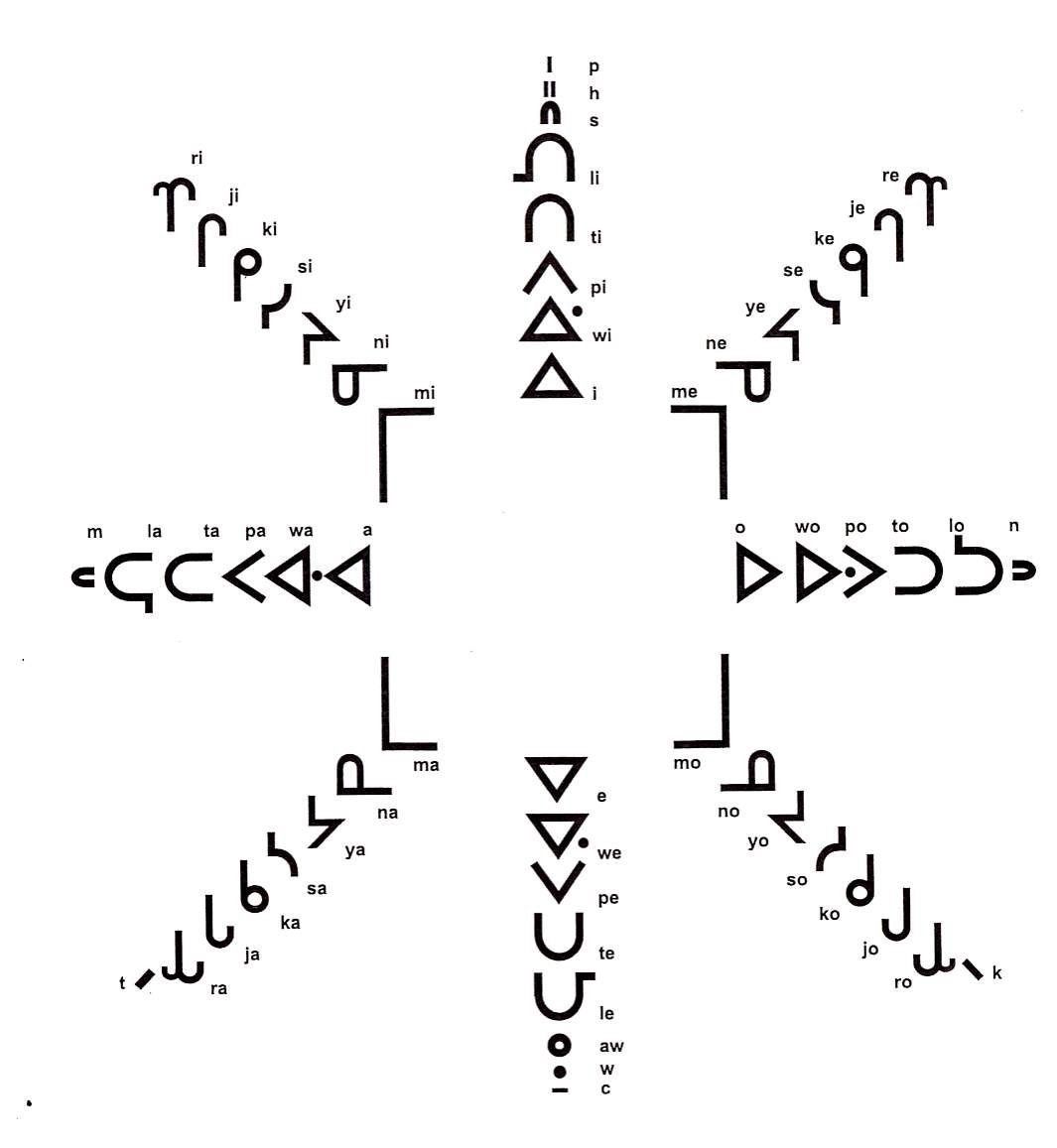
pederast is деторастлитель. раст ~ растлитель? -литель. литер!
раствро-ритель. смотри как ритель и окислитель литель. литель~ритель? житель. it's all around it because r & l are stem letters there. ить это суффикс. раствор это корень, ит в итель is ить. ель is et?
I like /sci/ hivemind to make my peer-review. They're my crowd.
crowd-review!
и тут я заметил, как несколько божественных печатей оставил выше, здесь бы она тоже была, но заморока и зачем мне наказывать себя за откровения. больше их скорей всго здесь не будет и может это божественное ознаменовало середину серии (или книги сейчас подсказывают)
власть развращает как педераст
растлевать развращать
трепать вращать
терапевт врач
людям нравиться мацать людей, засовывать в них трубочки, а им за это ещё и деньги дают. красивый развод, офигительный, но позорный, потому что узнают будет позор. внимание к твоей порсоне. (а кому-то нравится подглядывать в замочные скважины, подслушивать что у настоящих людей творится. это npc (I have to move to latina laphabet because all new technologies are in this language. But imagine what advantage I get if I speak other languages and make business internationally.
продукт не от протухт же, продукты от протухты протухающие. да нет же, это же когнат с английским product, который от produce прОдакт (перенеся ударение ближе к началу мы более по-английски зазвучим? давай попробуем так говОрить (ворить? брать? чего брать? говори и бери. гово бе. Б = Гв? b is в)
product protect
(размышляя про кадыровцев, зашкваренных пукинской войной (военное преступление, израильское право становится мировым, это замут гениальнейший)
сбегут или сгибут (сгибнут, сгинут)
бег гиб (гибн гин, гин как гн в гнуть, сгибать там же, это гнде б v ν n п м: м скорее всего было ν[n], б было v[v])
сгивать кивать смотри сколько слов knee от гнуть это отличный когнатизм, но как такое в cognates.html перемести? (перенести перевести перенести перевезти) лёгкие смысловые расхождения
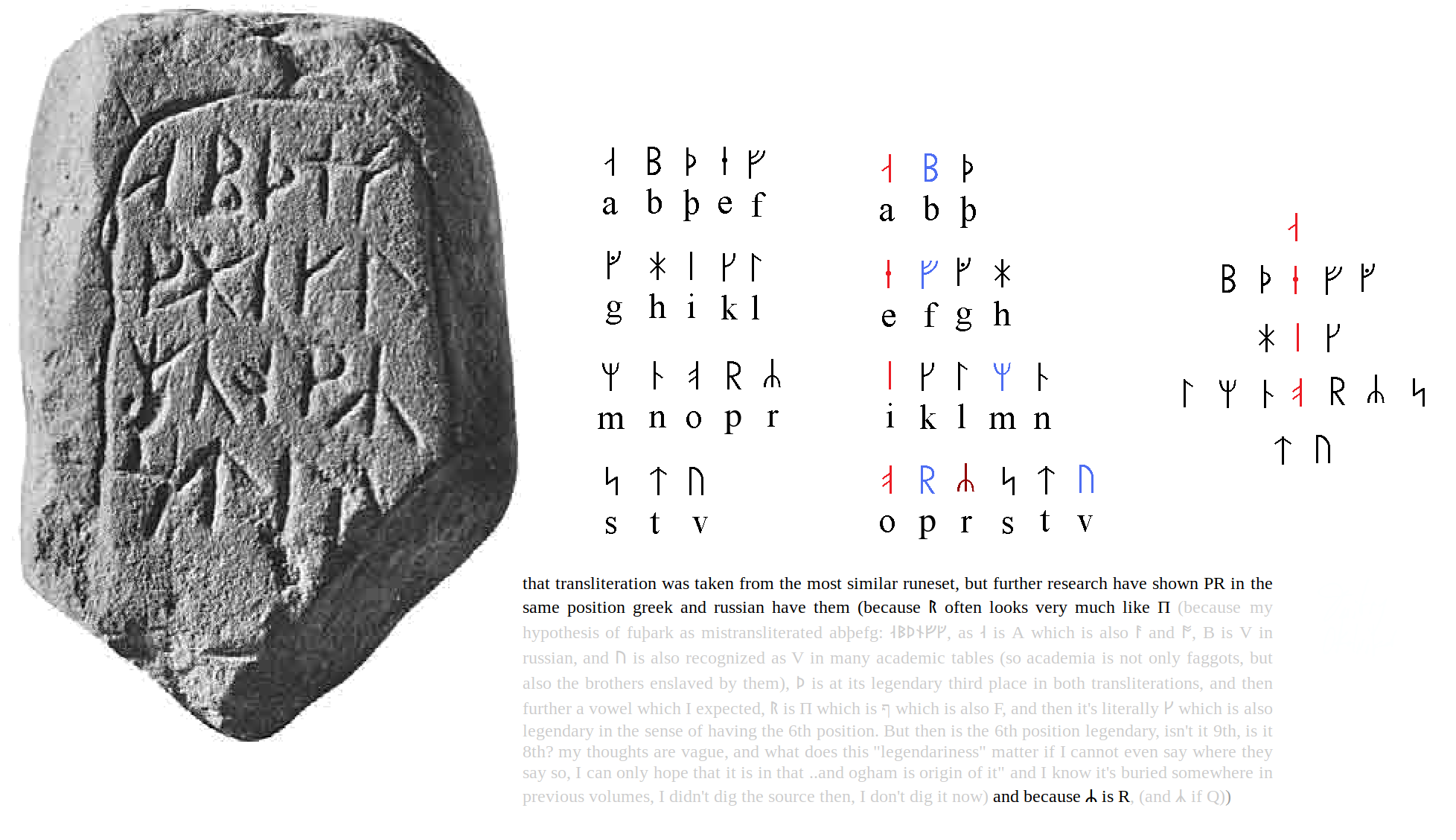
I hope you don't mind me hijacking this thread.
>>14291592 (You)
that transliteration was taken from the most similar runeset, but further research have shown PR in the same position greek and russian have them (because ᚱ often looks very much like П (because my hypothesis of fuϸark as mistransliterated abϸefg: ᛆᛒᚦᚾᚠᚵ, as ᛆ is A which is also ᚨ and ᚩ, В is V in russian, and ᚢ is also recognized as V in many academic tables (so academia is not only faggots, but also the brothers enslaved by them), ᚦ is at its legendary third place in both transliterations, and then further a vowel which I expected, ᚱ is П which is ף which is also F, and then it's literally ᚴ which is also legendary in the sense of having the 6th position. But then is the 6th position legendary, isn't it 9th, is it 8th? my thoughts are vague, and what does this "legendariness" matter if I cannot even say where they say so, I can only hope that it is in that ..and ogham is origin of it" and I know it's buried somewhere in previous volumes, I didn't dig the source then, I don't dig it now) and because ᛦ is R, (and ᛣ if Q))
and suddenly this thing with unclear source kinda supports my point of view, but then I recognized I didn't have to read it horizontally. apophenia, baby.

o being aa kinda makes me take this ᛦ(if R, or ᛣ if Q) as Y more seriously, because if ᚱ is some F, that ᛣ (also being its variant as Р[r] and R) is closer to Ψ and ᛘ(but more like ᛉ and this is a thread I didn't dig into too)
as you can see it made me pondering, and how their ᛩ rotated ᚿ, which kinda meein in ŋ ~ g ~ q not as inverted ᛆ though it's also that, and archaic a looked like q the ᛩ: and suddenly I find it hungarian runes of all places: 𐲀𐲁
(this crazy piece I didn't post)
but the discussion goes on
> I don't really understand how you can deny this, evidently most of the letters are derived from Greek or Latin alphabets
Because all I can see there is that they have some similar letters, but whose system derived from which this I wonder. Because Normans preserved structural concept of aettir (aicme in ogham) and greeks did not. Beca
 use
Normans have myth descibing the invention of runes, describing
them in connection to three mothers (the concept known as three
protoletters in jewish culture too, so don't kill them, please)
and greeks remember them when א divided into vowels (and I suppose
מ ~ B and I suspect ש to be ת and ת ~ T (so jews are still
important for the history of writing, but not as phoenicians as
they try to trick us now, but as actual hebrews, of which
themselves don't seem to know, maybe as the deniers of more modern
cults, thus the keepers of some universal traditions long
negletted by everybody else, because three mothers is known from
norns to tridevi all over the world and beyond)
use
Normans have myth descibing the invention of runes, describing
them in connection to three mothers (the concept known as three
protoletters in jewish culture too, so don't kill them, please)
and greeks remember them when א divided into vowels (and I suppose
מ ~ B and I suspect ש to be ת and ת ~ T (so jews are still
important for the history of writing, but not as phoenicians as
they try to trick us now, but as actual hebrews, of which
themselves don't seem to know, maybe as the deniers of more modern
cults, thus the keepers of some universal traditions long
negletted by everybody else, because three mothers is known from
norns to tridevi all over the world and beyond)Picrelated is what I consider to be a scheme of three dies, dice (compare to dis (a deity, ghost, or spirit associated with Fate))
and now I realize that dice are sides (probably s- is a prefix, like с is in сторона с то роны, ровы? руны! руна is d? D? ᚦ in general (pretty much no other writing system had such sign, but russians know it as Д))
Not only phoronidae smeared by rememification but Phoroneus himself is probably smeared as Forneus, but this time not rememed, but just demonized. probably by christians: In demonology, Forneus is a Great Marquis of Hell, and has twenty-nine legions of demons under his rule. He teaches Rhetoric and languages, gives men a good name, and makes them be loved by their friends and foes.
He is depicted as a great sea monster. He causes men to have a good name and to have the knowledge and understanding of tongues. He makes one beloved by his foes as well as of his friends. He is partly of the Order of Thrones, and partly of that of Angels. His name seems to come from "fornus" (oven). He can take many different forms but mainly prefers his human form.
Баба
Бабушка ушка
Мама
Мамочка очка
какие странные суффиксы, сменили две буквы и сходные слова, между прочим, семантически, отверстия в туловище.
Our heads have ability to roll the emulations, models of the world, and thus it can fforward it.
So heaven and hell could be the
поэт певец повет поёт
э и ё? (доп.буквы)
glossolallia made outside of church is considered by the church a sorcery. they burnt singers, which relates to irelandians or were they icelandians who reported that for couple of centuries they were prohibited to sing their songs. In churches they sing the same attested by the holy sidond sinode (saint?s) repertoire. Masses are hypnothyzing concerts (very alike to rock concerts, but more hipnothyzing, songs of sirens, and aeiou, in the ancient times songs could be considered holy, and glossolalia is singing some new songs for which new words are yet to come. And art is creative and its affinity to creation makes it magic. music~magic. спел~spell
russian surname suffixes -ов и -ова are ον ονα он она (when semantics meets spome other end (graphically here and if this theory merged two graphemes, then sound comes. I cannot explain the meetup of three sides of the word (sense, sounds, stance? visual part when it in letters, my guess that people didn't completely forget the connections between voice and objects
aeiou of the oldest found abecedary tells me that aeiou is indded special
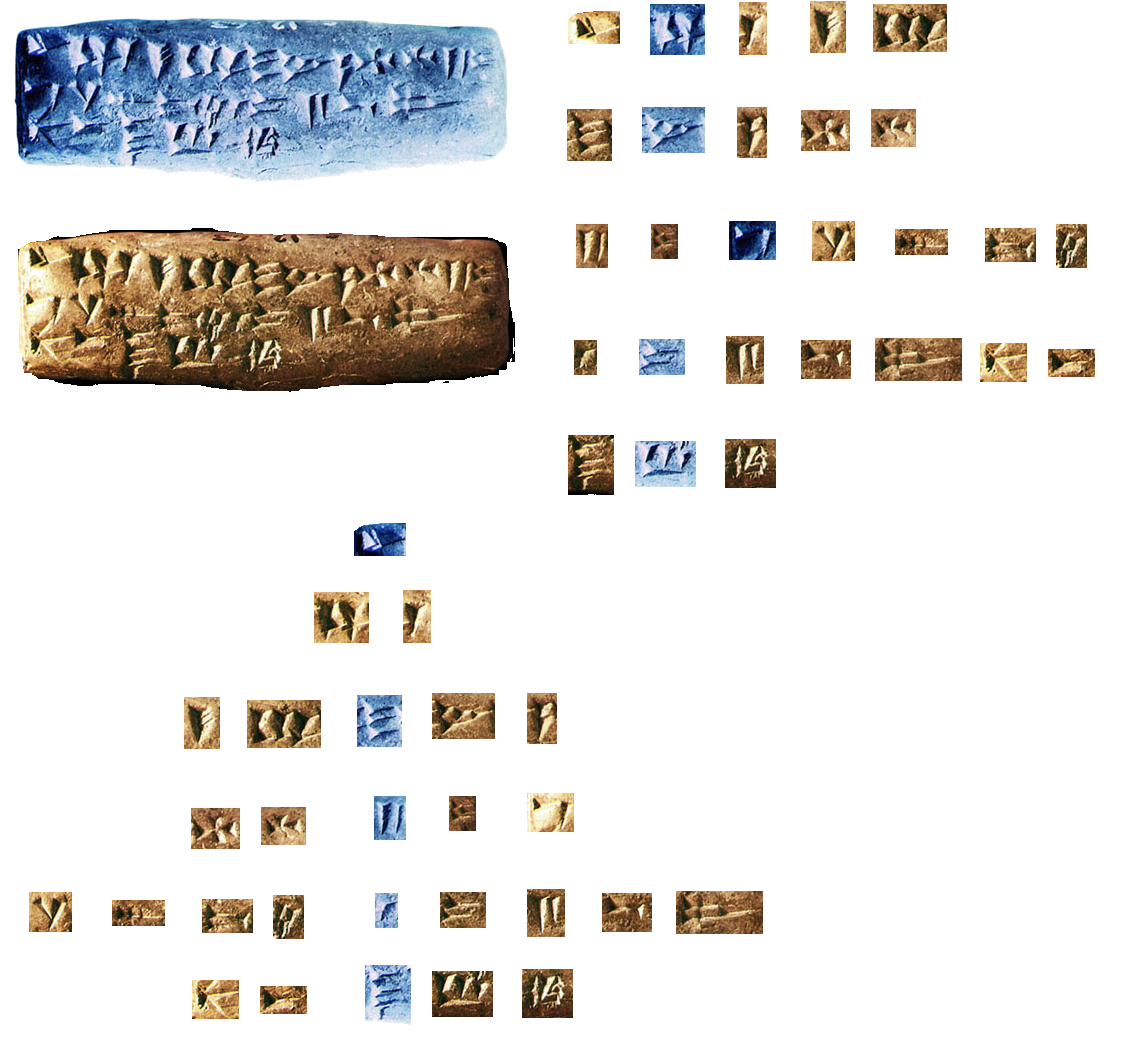
here it tells that U is a derivate of E, like Ё, like ЕЁ, like EF, like ה ו
So is it the source of the mess around θ(B? В[v]) it divided into o u v the three shapes of the same ו
mOOn lOOne, U seems to be the common part, when the first letter divided only when russian and english splat, and russians (and many others) recognized that letter as L and brits have M instead. Which makes me suspect that LMN are the three fate letters, and no wonder Lune and Moon both consist of these letters, and it could explain the
n ni две twee.
t and f as the protoletters, where t is ta and f is ti ~ θ ~ Ф
t f two halfs of θ in a way, left and right could be not important,
but back on trach, EЁ as EF and EV, V~U~Ю, Ю~IO~Ё
У~Ю~Ё
and now this transliteration which could be a christian mistransliteration to prevent people from understanding the old books, some cypher maybe mistransliterating some of the letters and the key to actual decyphering could be the alphabetic order they are always in? Those keys were engraved on swords like iroha could be those sword words and church just renamed it and forced their misconception. I can believe it, but anyway, what I'm speaking of:
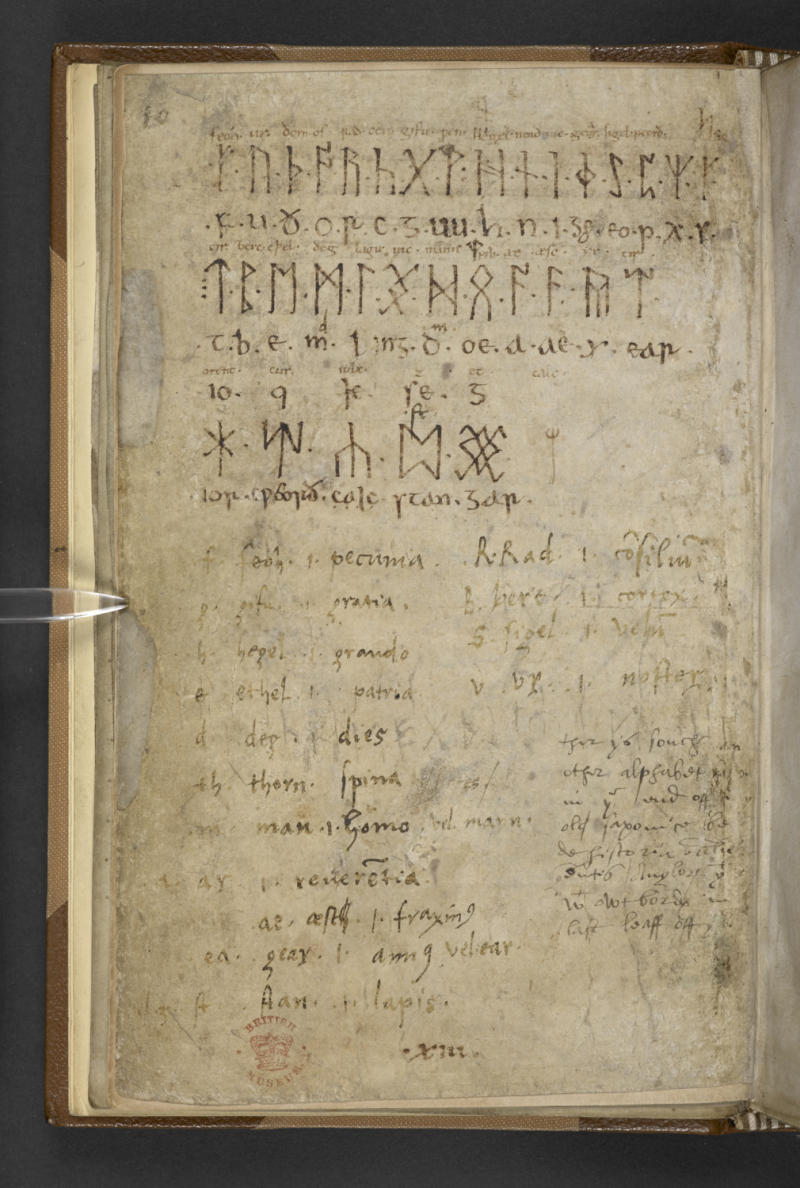
Runes copied in the 10th century, with their names added in the 11th century: Cotton MS Domitian A IX, f. 11v
We know that each of these runes had a name, taken from a noun that started with that rune: for example, (n) was called nyd (need), while (th) was called thorn (thorn)
and as I said, because there are only 3 aettir, there were only 3 aicme:
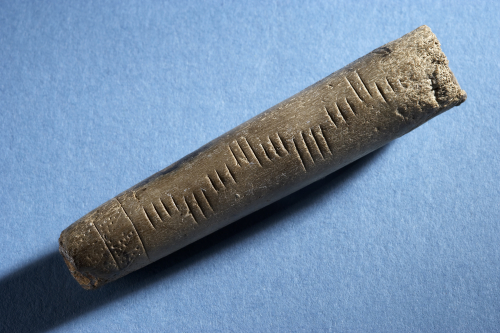
A knife with an ogham inscription, from Norwich Castle Museum
The Ruthwell Cross features the ‘Dream of the Rood’ poem inscribed in runes around its sides. Even when writing in Latin letters, the Anglo-Saxons used runes to represent sounds in their language which were not present in the Roman alphabet, such as æ, th (represented by þ or the adapted Latin letters Ð, ð), and w (Ƿ). Some of these letters are still used in Icelandic and Faroese spelling to this day.
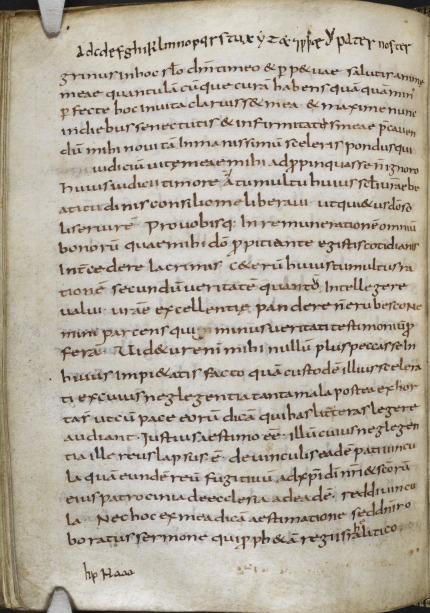
A scribe from 10th-century England practised his alphabet in the margins of this 9th-century copy of Alcuin’s letters: Harley MS 208, f. 117v
This next image was named secret-alphabets-celestial-script-the-hebrew-alphabet-called-alphabetum-coeleste-or-celestial-script-at-the-foot-of-a-celestial-image-of-the-sky-with-the-stars-and-constellations-visualized-as-hebrew-letter-forms-fold-out-plate-from-jacob-gaffarellli-curiositez-inouyes-hoc-est-curiositates-inauditae-1678-MC6GD5.jpg
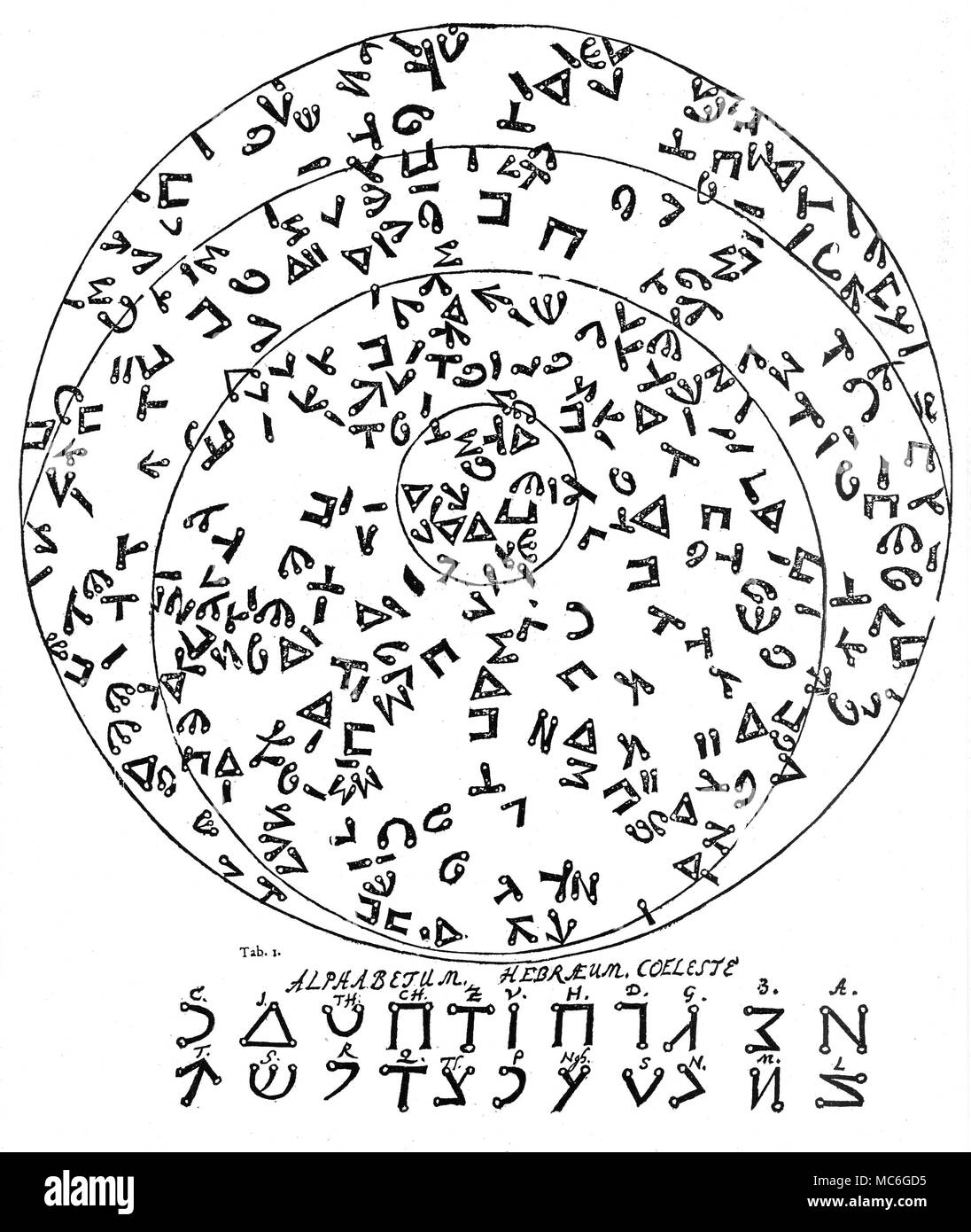
and suddenly, a vowel order different from both aiu of most of them and aui of ogham, the conconants are in halaham canon:

and now the arabic font for that very Tigre language I never heard of and about a million of people are speaking it using both ge'ez (above) and arabic (below) and notice once again how arabic treats the abc sequence: it combines the letters with all their forms, and to my surprise t is a form of b, which is super weird, but super awesome, and it's yet to be comprehended.
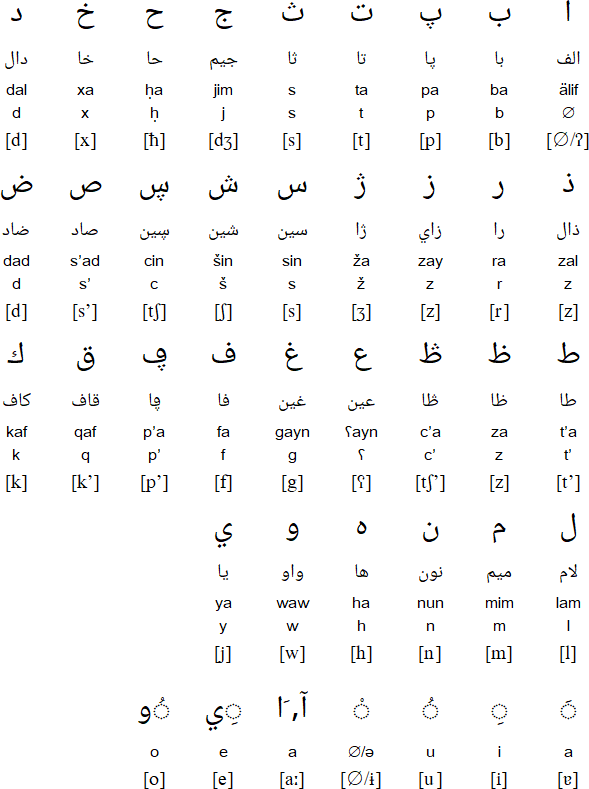
ا ب پ ت ث
ج چ ح خ د ذ ر ز ژ س ش ص ض ط ظ
ع غ ف ق ک گ ل م ن ه و ی
ع غ ف ق ک گ ل م ن ه و ی
and I have no idea if
this is how it worked or was.
(you've got it right, it is a random part again)
(you've got it right, it is a random part again)
And the image I used in early versions, but forgotten since
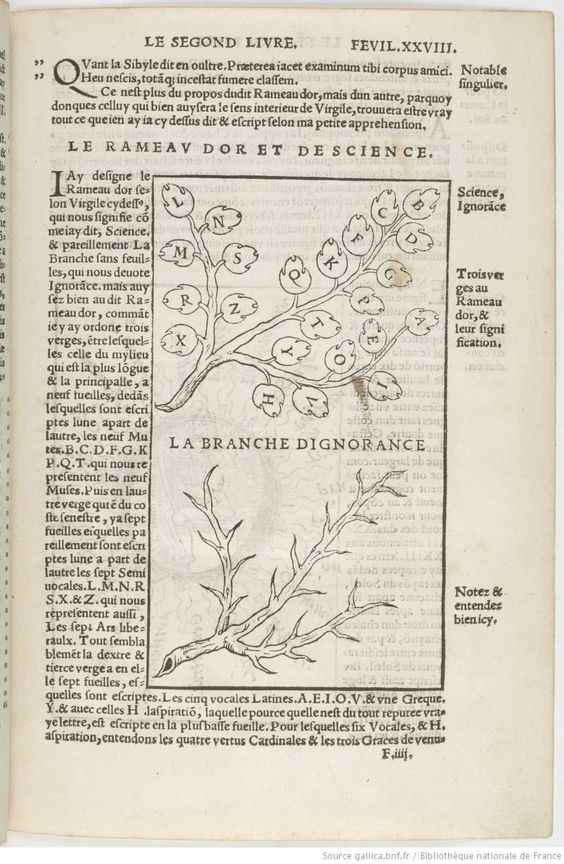
Champ fleury, au quel est contenu lart et science de la deue et vraye proportion des lettres attiques, quon dit autrement lettres antiques et vulgairement lettres romaines, proportionnees selon le corps et visage humain. -- 1529 -- livre
and just in case the article where I met it and I wonder why I don't find it in previous volumes when I ctrlF for Richter: https://www.scribd.com/document/154567093/Encryption-and-Decryption-of-the-Alphabetical-Hieroglyphs (mirror)
Only it's strange, that they added V H (because Y is greek V, and the two additional vowels greek alphabet's got (they say, around 6th century BC) are ΗΩ)
hymn is like hymen
Are they Asgard Midgard uTgard? is ut=do? ut as in utilize? user? do?
понятие русскости должно исчесзнуть (заснуть, усопнуть)
flow ~ ſlow ~ slow (~ is a soft form of =)
slow flow (somehow that was out of ~ soft =)
Буддучи в капсуле я сделал её из ржавого арматурного шара. который сварил за несколько лет до этого. и вот (до того как залил бетоном) представляют как оно произойдёт, что если меня не обманули, ржавчина будет срастаться с бетоном, образуя псевдокристалл и быть может я лишь читал что бетон сцепляется с лжэ ржавчиной, а но срелище того как золото растёт срастает его с расстениями, проще простейших, и куча переходных форм, к изучению которых человечество скорей всего ещё не приступало)
руина рушина (донбас и дальше украина это просто намёк.Стройте новые города и тикайте туда. Города в одного. Передвижные города. Караваны. Кочевные Кочевники Кочевые Кочевой Караван
антимонопольный коммитет запретит рушину собираться в родину (родина=мать=родила)
на одну шестую
на самом деле цикл в одну треть. Предполагаю, что трава прёт не 4 часа, а 8, просто остальные 4 на спуске в нормальность, и мы там начинаем жрать (иногда (может если увидел еду) через два желание жрать появляется вроде. чераз 2-4) и не видим, что какие-то тонкие эффекты до сих пор присутствуют. Но три матери это 8 часов на сон, которые естественным образом образуют ровно треть от 24 часов.
R G B красный жёрлтый зелёно=-синей
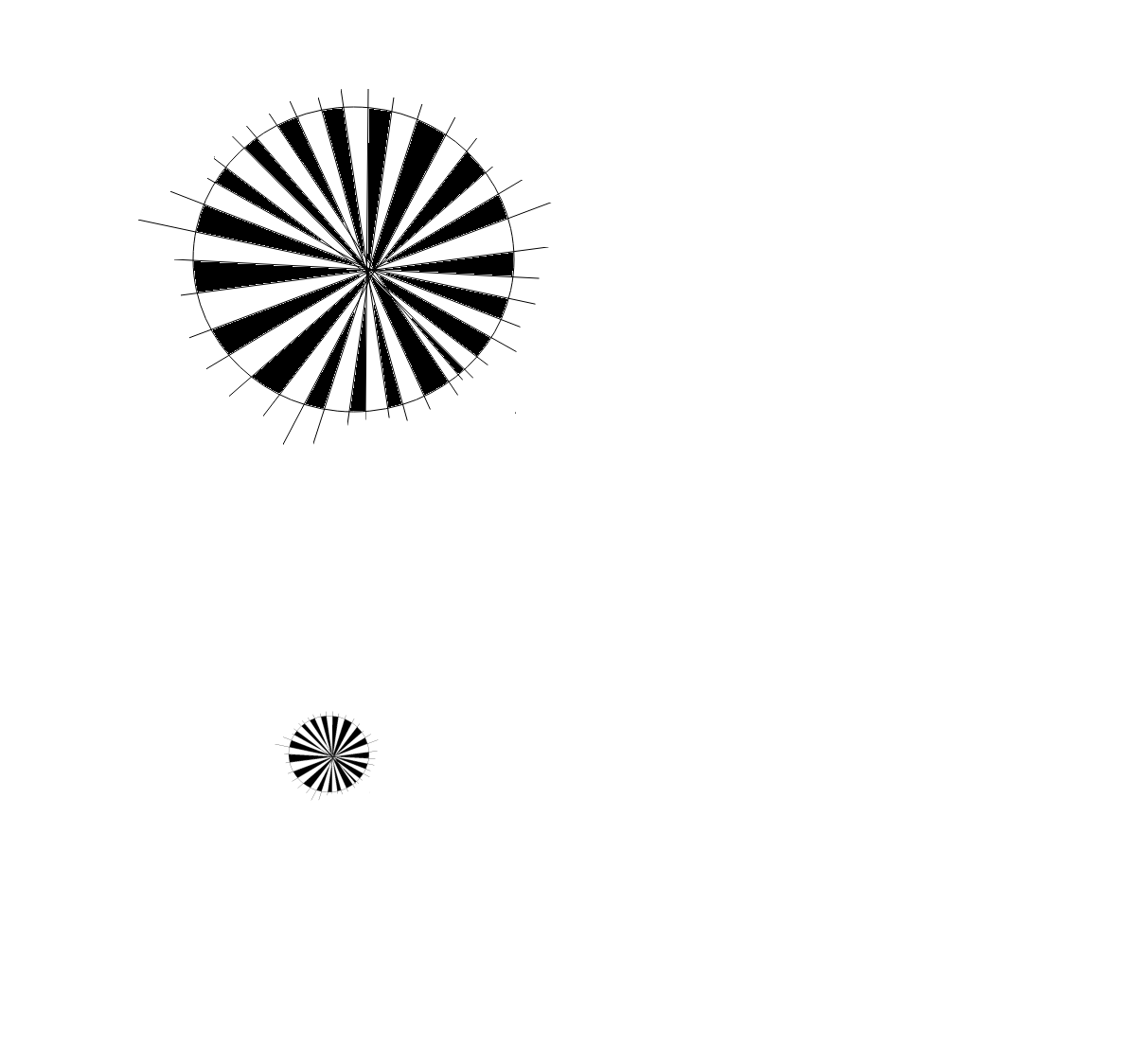
𒀭
and obviously it is the sun,
That sloppy экскиз (сказ как показ, сказ с казом ём, нём, он),
русь срусь старость стресс трусь прусь (прусь лучше руси. прусы пусть возглавляют руссов. Немножко п-русского (польско-русского?)Prussia, German Preussen, Polish Prusy, in European history, any of certain areas of eastern and central Europe, respectively (1) the land of the Prussians on the southeastern coast of the Baltic Sea, which came under Polish and German rule in the Middle Ages, (2) the kingdom ruled from 1701 by the German Hohenzollern dynasty, including Prussia and Brandenburg, with Berlin as its capital, which seized much of northern Germany and western Poland in the 18th and 19th centuries and united Germany under its leadership in 1871, and (3) the Land (state) created after the fall of the Hohenzollerns in 1918, which included most of their former kingdom and which was abolished by the Allies in 1947 as part of the political reorganization of Germany after its defeat in World War II.
пруссия поросия, проят, pork, порось. поносъ (дрист их вонючий повсюду наверное был, раз люди здесь разводили и
Есть объективная необходимость контролировать русню, но трансгуманизхм перейдёт эту проблему, но сам термин следует переименовать, раз транссексуалы привносят свои фекальные коннотации. пост-хуман гораздо лучше, но истое uman = умён. знает много имён.
..and that thread goes on:
>- every sound-letter has a meaning by itself, like prefixes (extreme agglutination?)
Basically every Eskimo language, plus a lot of North-West native american ones
Can you give some examples? Is it like recognizing each syllable by their meaning (as they preserved it in chinese) and like we could decypher every word as be-lie-ve (lets lies in or bets on lies, see, we don't have it, we can only guess in our interpretations. But maybe AI can learn chinese by hieroglyphs and tries to find the same words in languages which lost the meanings of most of their morphemes due to using alphabets instead (but the alphabets themselves were ionvented when those simple meanings was not forgotten, so their structures probably tells some story. Yet who know in what language. Maybe L and R at sides of this thing make sense, or maybe some secret society switched R because of that from the previous line (JLRMN are the only sonor sounds and they mostly all in the I-line, and in russian they have some unique peculiarity: voiced sounds are grouped in the first half of the alphabet, except these КR, and I read that C was voiced by default before CG split (Caius Julius Caesar)
and it made me ponder on it, but it doesn't seem to lead anywhere so far, just wandering, wondering,
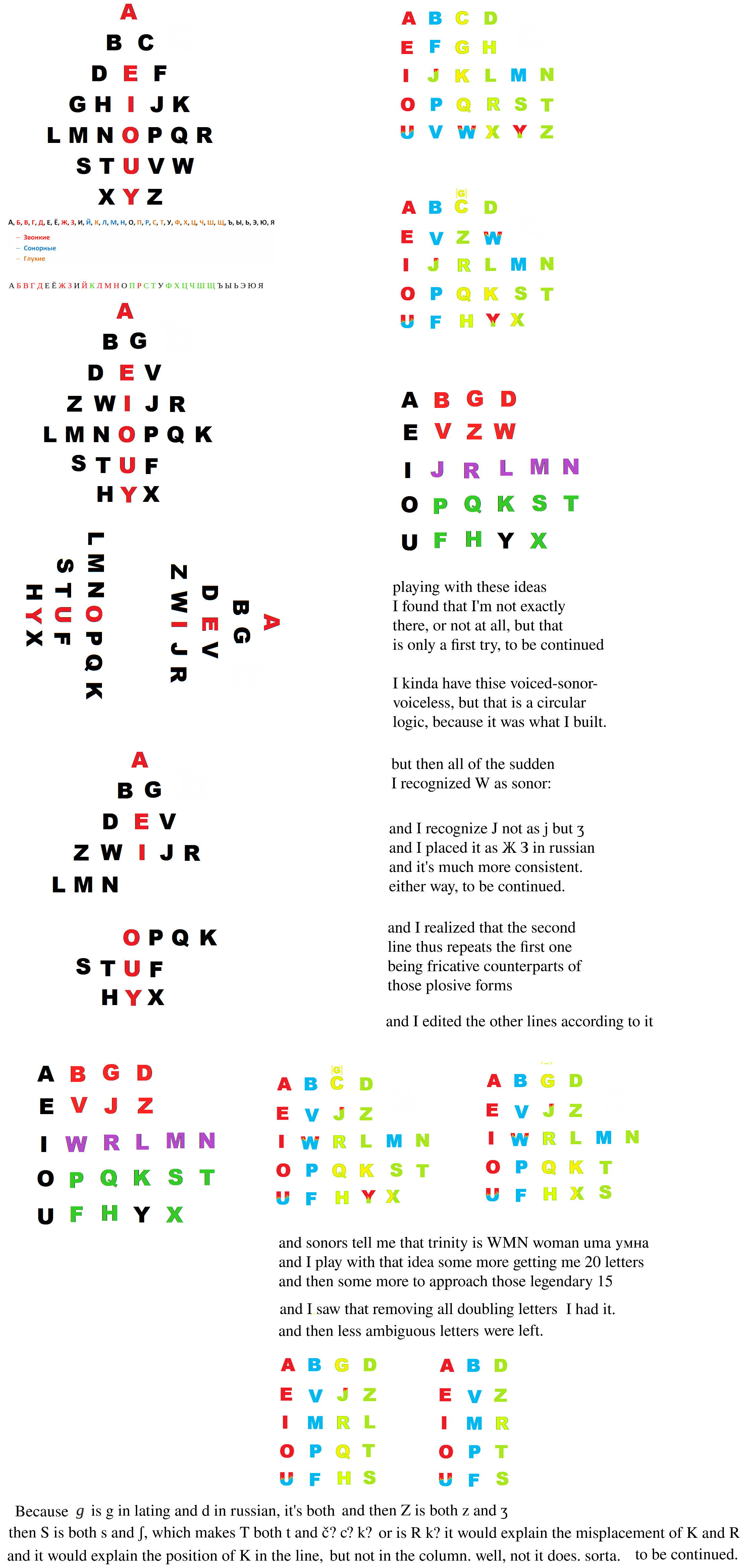
But then the 20-letter alphabet doesn't align in the axial symmetry and the 15-line alphabet aligns into it poorly and not prettily so nah. And thus teh axial symmetry possibly secretly cultivated, since it is so great without exceptions and L to R dayou. So they disturb the lineal symmetry, to build up the axial one. Is it a form of strive towards вертикаль?
auto bus car drive
eat food good hot
i?
o? not that it was leading anywhere, I honestly broke at d (maybe there're dogs)
u? (but honestly nah)
TV tverdoe i jidkoe (едкое или житкое? живое подвижное)
terra ia akva te-ra ak-va Te Va (water is also water in slavic languages: voda)
te Ra aK va? Ra and aK show the shape of the syllable? aV? Te? Do I only have this hipothesis because V is in both akva and vada? va is in both. Because of 🜄.
T as in ject? object, subject ob and sub are prefixes.
No = know (no, it is such and such = knpow, it is souch and such.
АМЗ is знакомая аббревиатура, в челябинске неформально означающее клинику для тихопомешанных.
Сколько из них катарообразные еретики, увлекшиеся тем что А = 1, М = ΛΛ=АА=2, З = 3.
И умышленно это сделано или божественная ирония, потому что умышленно, ибо те, кто открывал эти печсати до меня были ..что? Эта форма АМЗ, AMZ was not known to me, but now I see them as modern representation of A M S and A M T (A then M inside of it, then T inside of that gives a female shape of 🜂 with 🜄 inside of it. and three or one vertical lines across the lower part showing vagina opening and legs or jusst vagina opening.
And that АМ3 of автомеханического завода (не выпускающего в совке никаких машин (в отличие от ваз, газ, лиаз, заз, маз, камаз, на всю страну от легковых до грузовых всего столько, не удивительно, что автомобили были в постоянно неудовлетворённом спросе (авто за 10 000 при зарплате инженера в 100 рублей делал автомобиль инженеру не желательным (при свершении карьеры человек получал гос.автомобиль как привелегию)
Λ Μ Ν Ξ
I N M of i ni mi
хохол = huh, all (when asked what nation he is, as my hohol grandma did)
Какая собака между нами пробежала. Хохол её пнул, а русский заступается (конечно, за евреев)
(но лучше сравнивать евреев с кошками, и им приятней, и характер их лучше описывает)
thoth tot taught то-то told то'ed, он'ed? no = оно, oh no? third person, but that is some contextual meaning I went into, probably another faux pas.
тятя и дитятя (de тятя)
тятя отче от чей daddy=de(of, oθ, oθче оθец)
mama ma = my
dada da = de?
I belong to father, but my mother belongs to me.
found a great site: https://kaikki.org/
wrote to the author something which can be interesting for you too:
I just found your site, and I have som many questions! Where did you find the dictionaries of morphemes? Did you collected them yourself? Did you use soma ai to pull those morphemes from texts? Do you work with ai? Because I have some wildest theories I would like to give a try with ai.
I yet have to formulate the task, maybe you can help me by telling of what it should contain for be fit for consumption by ai of yours. Some of my work is at aeiou.ru and the first thing I would do is I would start with the most widely used short words (of in one language and de in the other, and от in the third, and out of these simple words would grow next level of words (though слово is similar to syllable, so is слово и слога (-го is read as -во[vo] in russian words like его, чего, кого, того, сего, ит.д)) отец in the third language and daddy in the first, of~father, de~daddy, от~отец~тятя (as you can see, I wouldn't bound the lexicon to some arbitrary languages, but would allow the words flow freely (maybe in some differnt hue, or with a function of swithcing some national lexics on and off) because words are less abstract concept than languages.
the answer was:
The dictionaries on https://kaikki.org are extracted from the English Wiktionary (meaning thst the glosses are in English). My software tries to extract what is in Wiktionary, no more, no less. Post-processing systems can add and remove data. I'm trying to make the Wiktionary data more easily available to researchers and developers. There no AI involved; it is a fairly traditional though complex program.
and I responded and plan to keep the correspondence, because the man seems to brootforce towards the sam goal I have in mind, only I think I can offer him some more sophisticated approach rather than the brute-force, and because I may need the brude-force-mined data, I think I also will download his site just in case.
shamaim (the sky) can be "up there" because sham is там (there)
the previous etymology was ash+maim. Is one of the versions false or shamaim is plural form of sham and maim is plural form of m, and sham is fire+water, somewhere, over the rainbow, rain and sun.
In this context m is ocean and s is sun. What is a? Alpha is for Anthropos. We didn't deify humans at first. M S are B T the labial of water and lingual of the sun. The voiced of the water and voiceless of the sun. Rain makes sound, sun pretty much does not.
the following image probably belongs to cognates.html, but since I will collect cognates from these drafts, let thi brew here too:
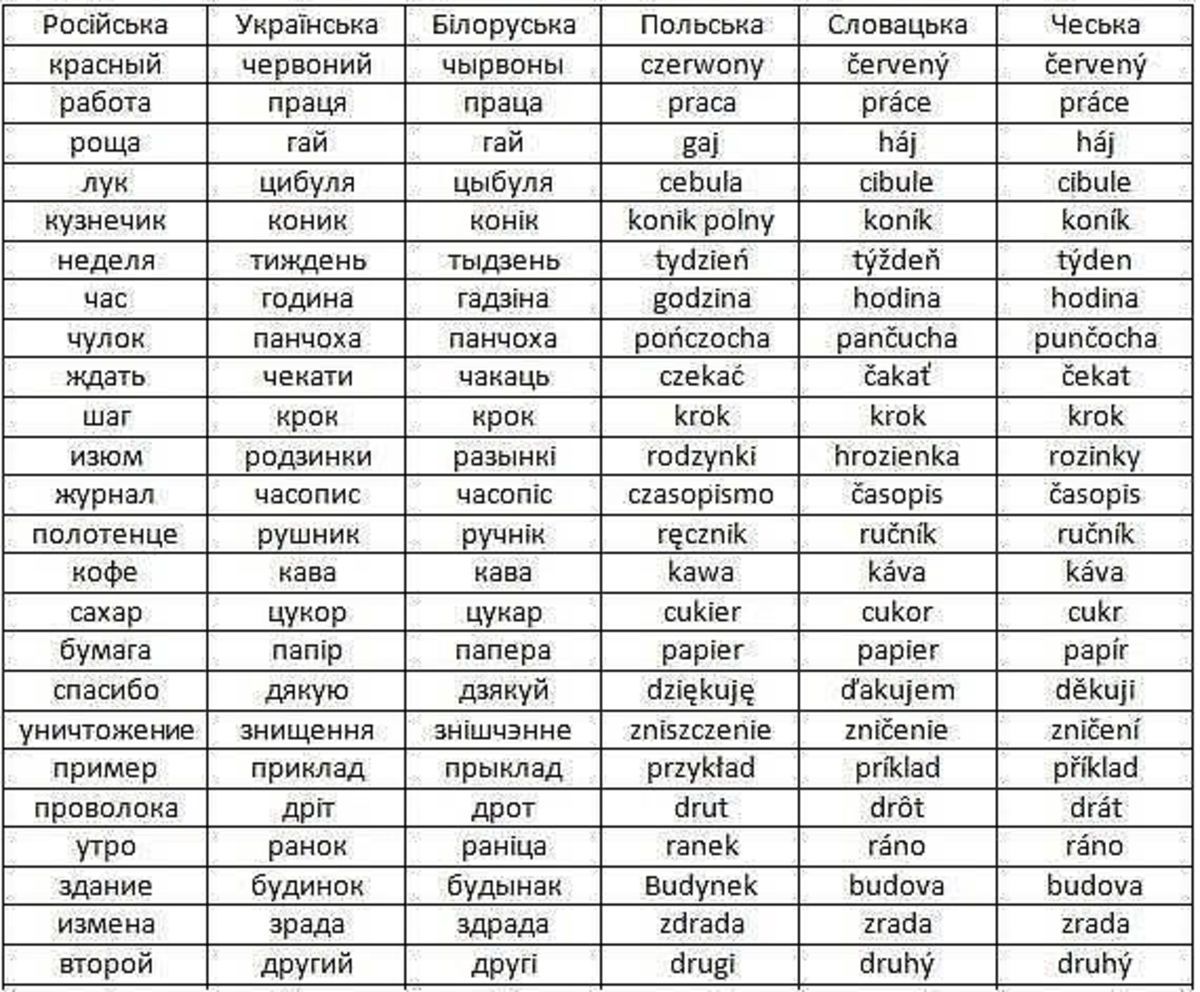
and let the following piece be here too, Слава Україні!
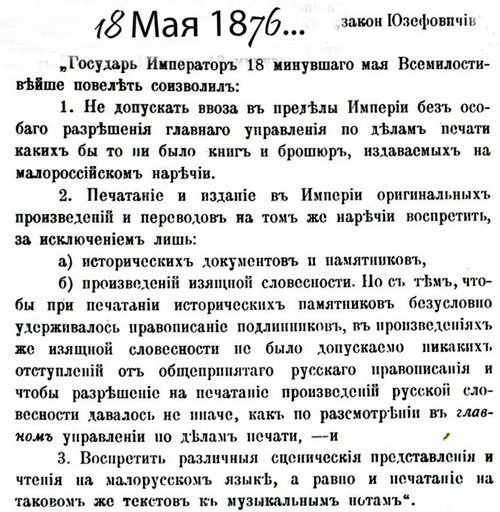
Имперасты могут выдумывать любые удобные им истории, но это не изменит реальность, в которой японская культура гораздо ценнее (потому что глубже проработанна, что может говорить даже о большей древности оной, вопреки псевдонаучным историческим заблуждениям) китайской, а украинская гораздо ценней российской. Все россказни об искусственности этого языка смехотворны. Этот язык гораздо ближе к общеслвавянскому, и гораздо ближе к европе, украинская азбука была издана раньше русской, и так далее, попробуйте принести что-нибудь способное сравниться с этим:
растения окутали меня ветвями мяхкими и листьями приятно
свет солнечный скрывается средь них под их телами под разводами полей средь волн премногих водами ведом томим узорами и дожеми омытый лицо сливая с высочайших весей свиваясь в танце нескончаемых монад средь смятых мят и выплесков спонтанов свсм скликая семя средь умятых

it is here to demonstrate a cascade joke (I wanted to explain it
𓀀 goes first in the list of egyptian hieroglyphs. I wonder if that order is traditional. Technically, egyptology could have already found the ancient collection of them all, and because it stands for I (me) and I is also used for 1 and first russian letter used to be called az, and az used to mean I (me) in russian.
And because egyptian hieroglyphs watched at the beginning of the text, and chinese began texts at the right, let's invert 𓀀 to compare it to 我

and because today that az (аз) is я, and because russians begin texts at the left side, I inverted that 我 to compare it to Я. And it seems that all three signs stand for the very same 𓀀 and the similarity is seen only if the tradition went in the following direction: egiptian → chinese → russian.
I also just figured out that astrology probably started as genuine science. Because it probably matters in agrotech: first the sun as the astronomic body matters: whether it is a day or a night. It is important not only for plants, but I still doubt astrology matters for humans as they say it does, but for plants it definitely matters: Moon gives some light too, and definitely that light matters for the plants and their cycles whatever those are. And then even zodiac may matter in the following matter: the speed of light is supposedly finite, and we the planet move around the sun, which moves around the centre of the galaxy, which also moves in space, and then the directions of our planet are not isotropic (I'm not sure I'm using the correct term here) and thus which part of the zodiac the sun is at the moment tells about the season and that directly tells about the temperature, which matters a lot, so you don't plant in the winter and then even moon blocking or mirroring some of the sunlight onto the earth may matter too, but of this one I am sure way less.
агроном астроном гастроном
agro astro
aggresive ostracizing
угражает устрашает
грозный страшный
грани стороны (страны)
руки рвуки рвут, ноги? нажимают? нажи имают. ногти ножики?
ножа (если нож и найф когнаты, то ж и ф (во множественном в) одной буквой это θ, тогда knife напоминает слово конус, и в сущности не этим ли являлся первый нож? пикой!)
нога
ногти
когти (вполне могли первые ножи из когтей делать)
на г. на говне (с ножом. т.о. г буквально означает говно)
может потому у нас все города сплошное г, что в электронной анкете, которую надысь в бухгалтерии заполнял так и сказано челябинск г
табуировав отменить букву G (оставить только С [s] C [k]) как К якобы табуировали (dunno)
государство тогда будет осударство (ибо осуждает, наконец-то эта абракадабра какой-то смысл обрела. государь тогда осударь. сударь с вежливым о! как в японском. сударь старший, старь, царь, осударство = совет старейшин. (совет самых старых россиян, ибо они дожили до таких седых яиц, значит они умнее всех.
Создать совет старейшин. Самых старейших граждан страны.
А Б В Д ? ᛆᛒᚦ whoever however you read them. I think russians may adopt bornholm runes, because they have their ugly Ж (ж is russian g)
then ᚠ is ё? ᚠ is V, W,.
ᛆᛒᚦᚾᚠᚵᚼ(or ᛡ)ᛁᚴᛚᛘ(even though it looks like ᛉ)ᚿᚮᚱᛦ(if R, or ᛣ if Q)ᛋᛏᚢ
ᛆᛒᚦ
ᚾᚠᚴᚼ
ᛁᛚᛘᚿ
ᚮᚱᛦᛋᛏᚢ
such poor alphabet also thus it won't fit into the axial symmetry.
I think I should
овно
овяды
корова корога рока соосные? кольцом? ко кольцо? со
ע פ צ ק ר ש ת
T S R Q Z P О
if russian way of placing voiced letters in the front is based, let's try it in the runic script:
ᛆᛒᚦ
ᚾᚠᚵᚼ(or ᛡ)
ᛁᚴᛚᛘ(even though it looks like ᛉ)ᚿ
ᚮᚱᛦ(if R, or ᛣ if Q)ᛋᛏᚢ
if we recognize these shapes as the russian shapes (because of ж ~ ᚼ(or ᛡ))
AБД
ЕВЖЗ
ИРЛМН
ОПКСТ
УФХЦЧШЩ
T S R Q Z P О
if russian way of placing voiced letters in the front is based, let's try it in the runic script:
ᛆᛒᚦ
ᚾᚠᚵᚼ(or ᛡ)
ᛁᚴᛚᛘ(even though it looks like ᛉ)ᚿ
ᚮᚱᛦ(if R, or ᛣ if Q)ᛋᛏᚢ
if we recognize these shapes as the russian shapes (because of ж ~ ᚼ(or ᛡ))
AБД
ЕВЖЗ
ИРЛМН
ОПКСТ
УФХЦЧШЩ
но я отвлёкся, но начало именно такое:
ᛆᛒᚦ
ᚾᚠᚼᚵ
ᛁᛦᛚᛘᚿ
ᚮᚱᚴᛋᛏ
ᚢ (u as a form of e, see ugaritic, and the lines follow: EFGH UFH(+affricates ts and ch) which tells that G is some masonic extra and has to go, byebye mason guy, G is fake and Gay.
G ~ F? Gay is Fag, baby, to fuck is to Gulatt, Gopulate, Жопой вилять. Жопу давать (late~let) let's go ~ late's go? one late is not too late. оставаться допоздна значит позволять себя ограбить выебать и что там раньше было до того как го-о взяло всех на карандаш.
ода ввп
на душу населения, сынок
наклав ты свёл с ума и сбил их с ног
обогащая свой ближайший кргу
ты проглял плоть их загребущих рук
странно, что г там проявилась где должно быть к (опечатка, но стихи ещё больше магия чем весь обычный текст, который тоже в некой мере)( (словно прогулял, проглядел)
кргу словно название университета. на самом деле круг )
ᛆᛒᚦ
ᚾᚠᚼᚵ
ᛁᛦᛚᛘᚿ
ᚮᚱᚴᛋᛏ
ᚢ ?
or should we stick to that 18-letter font?

ᛆᛒᚦ
ᚾᚠᚼᚵ
ᛁᛦᛚᛘᚿ
ᚮᚱᚴᛋᛏ
ᚢ (u as a form of e, see ugaritic, and the lines follow: EFGH UFH(+affricates ts and ch) which tells that G is some masonic extra and has to go, byebye mason guy, G is fake and Gay.
G ~ F? Gay is Fag, baby, to fuck is to Gulatt, Gopulate, Жопой вилять. Жопу давать (late~let) let's go ~ late's go? one late is not too late. оставаться допоздна значит позволять себя ограбить выебать и что там раньше было до того как го-о взяло всех на карандаш.
ода ввп
на душу населения, сынок
наклав ты свёл с ума и сбил их с ног
обогащая свой ближайший кргу
ты проглял плоть их загребущих рук
странно, что г там проявилась где должно быть к (опечатка, но стихи ещё больше магия чем весь обычный текст, который тоже в некой мере)( (словно прогулял, проглядел)
кргу словно название университета. на самом деле круг )
ᛆᛒᚦ
ᚾᚠᚼᚵ
ᛁᛦᛚᛘᚿ
ᚮᚱᚴᛋᛏ
ᚢ ?
or should we stick to that 18-letter font?

AБДЕВ
ЖЗИКЛ
МНОПР
СТУ
And if we recognize r in ᚴ, we have more voiced-voiceless system, and if we rectognize ᛣ instead of ᛦ, I can have K in there, so because goths didn't close the R at the top, I can see where could theis k ~ R confusion come from. Also because cursive k does close it in a way.
AБДЕВ
ЖЗИRЛ
МНОПК
СТУ
and it allows me to divide it differently:
АБДЕВЖЗИRЛМН
ОП С Т У
У?
z is often dashed because it isn't s? t is always dashed because it isn't l?
ЖЗИКЛ
МНОПР
СТУ
And if we recognize r in ᚴ, we have more voiced-voiceless system, and if we rectognize ᛣ instead of ᛦ, I can have K in there, so because goths didn't close the R at the top, I can see where could theis k ~ R confusion come from. Also because cursive k does close it in a way.
AБДЕВ
ЖЗИRЛ
МНОПК
СТУ
and it allows me to divide it differently:
АБДЕВЖЗИRЛМН
ОП С Т У
У?
z is often dashed because it isn't s? t is always dashed because it isn't l?
a very interesting video, speaking of yea yes and nio no being kinda recent:

this screenshot is here, because ba da reminds arabic la ba. (where ba in both cases is chinese bu, or rather common bu still preserved in chinese.
and then this song I have already shown is here to what's below it:
If cracker is just disguised by the firecracker, then what is fire? Isn't it what fries? Жар жарит. Жарит также означает ебёт. Т.о. fire is fucker. Can I be your favourite fucker, cracker? And who knows if there mother is not involved.
an interesting and long-forgotten thing I read in vol.1: 666 are three genders (three sexes)
if 6 is sex is пол is half, then 12 is full? twelve as the all we? the all -ve? the all've?
the alive? две над цать. to over ten. eleven twelve. a leven twe lve. a leven like один наддсять
две наддсть twe et lve
t1 is v? the one над t
v = 11? because t = 10. like ten. like 十
nah, I'm way too high, and not as good. as I was when I smioked the first today, Now that trip and this one lay over eachother and give only some узоры обои с вышивкой невидальщитна.
ыуу ы see ya next time.
ᛆᛒᚦ A Б Д
ᚾᚠᚼ E V Z (ʒ~z)
ᛁᛦᛚᛘᚿ I MLRN I RLMN?
ᚮᚱᚴᛋᛏ O PQ ST? O PФ ST!
ᚢ ?
ᚴ as what today is read as ᚠ speaks of V being F (von [fon]) and W being V
digamma is W? гамма шы is V? Γ ~ V? is it why they write г where we pronounce v?
is it another reason to outlaw глаголь? виселица у нас она называется. одной V достаточно.
зираф и жебра станут допустимыми вариантами если З и Ж сольются в Z?
Г должно уйти прочь. оСударство, State Stareischinen? Состояниетельные
тела = the + la (liek is probably some calque of that)
calque is a better word than cognate, because calque is more wide-knownd and because it doesn't have that nasty g letter. look like it looks, like some sausage or also shit.
фарш порез?ано (оно)
посколько перцы фаршируют, родственны ли фарш и перец? Мясо запечённое в перце наверное может по долгу храниться. Но я не проверял и наверное нет, до мяса охочих много.
ᛆᛒᚦ A Б Д
ᚾᚠᚼ E V Z (ʒ~z)
ᛁᛦᛚᛘᚿ I M LRN
ᚮᚱᚴᛋᛏ О П К С Т
ᛆ
ᛒᚦᚾᚠᚼ
ᛁ
ᛦᛚᛘᚿᚮᚱᚴᛋᛏ
What is interesting about such representation is that lower part has plosive voiceds at the top left and fricative voiced at the top right, sonors as bottom left and voiceless at bottom right.
A and I as two protovowels, turning previous consonants straight or palatalized.
And it looks like palatalized are the primal form, because ᛆ is diacritized ᛁ.
and ᛁ looks like an empty staff and ᚮ being double ᛆ made me think of a shorter version of it:
ᛆ
ᛒᚦᚾᚠᚼ
ᛁ
ᛦᛚᛘᚿ
ᛆᛒᚦ
ᚾᚠᚼ
ᛁᛦᛚᛘᚿ
ᚮᚱᚴᛋᛏ
sixteen is legendary, I have to compare it to what they call younger futhark
ᛆᛒᚦ
ᚾᚠᚼ
ᛁᛦᛚᛘᚿ
eleven is nothing I have heard of. Or did I?
No. Rokotas has 12, Palamedes added 11 to the pre-existing 7 getting thus 18 of three dice, and dice he's invented too, so that could be the same thing.
so
ᛆ
ᛒᚦᚾᚠᚼ
ᛁ
ᛦᛚᛘᚿᚮᚱᚴᛋᛏ
is the discovery of the day or even week. a candidate to be used to write russian, and set of 16 letters make two slots in those dice empty, and that could relate to two jokers.
they're neither gods nor devils, they're jokers, fiends as everyone. maybe some older beings. Even if it doesn't exist in reality, in the cultural layers such concepts exist.
ᛆᛒᚦ
ᚾᚠᚼ
ᛁᛘᛚᛦᚿ (finally I think I made a correct decission to place R after M)
ᚮᚱᚴᛋᛏ
Let's try to write some russian ssian sentence in thei set:
съешь же ещё этих мягких французских булок, да выпей чаю
ᛋᚾᛋᛋ ᚼᚾ ᚾᛋᛋᚮ ᚾᛏᛁᚼ ᛘᛆᚼᚴᛁᚼ ᚱᛦᛆᚿᛏᛋᚮᛋᛋᚴᛁᚼ ᛒᚢᛚᚮᚴ ᚦᛆ ᚠᛁᚱᚾᛁ ᛏᛋᛋᛆᛁᚢ
here, though I felt fine with combining Х и Ж in one letter (just as J is) but I couldn't feel comfortable by substituting U for O, so I felt like returning the ᚢ in the set, so now it's 17 letters and only obne joker.
ᛆ
ᛒᚦᚾᚠᚼ
ᛁ
ᛦᛚᛘᚿᚮᚱᚴᛋᛏ
ᚢ
ᛁᛘᛚᛦᚿ (finally I think I made a correct decission to place R after M, but what if those are plants which first gets out of the ground, and then a large and mighty tree? I thought about it, I took ᚼ as the third form, as if the crescent phases, ᛘᚼᛦ and the correct direction could be given by knowing which was I have to look at it)
ᛘᚼᛦ could be read as мир. could it?
the Ural mountains, whence the ore is procured
are Ural from ore? hm..
ore гор (убирая г смыслы слова раскрываются)
табуировать букву г отличная идея. чево, восударстов? во is just another part of гово? вне (not inside, when it lays on the grass, on is after? овно (с\едобно, т.е. там есть что есть)
ов и во
ед и де
форма слога была неизбежно важней, до того как членораздельно
without the the's, english becomes less членораздельным:
ломая полумесяц
by breaking vicious crescent
that translation can also be written as the opposite of what it tells
look how humanlike dodecahedron may look, it almost always looks like that
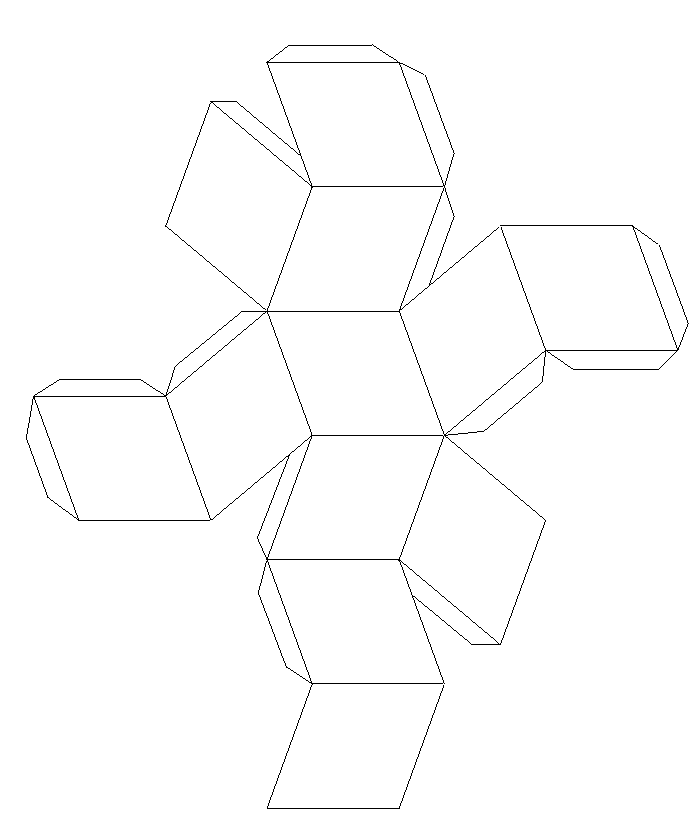
проклинать ~ против колдовать (но pro в латыни за. перепрочитать бы латинские тексты с инвертипрованным смыслом про (быть может когда-нибудь будет это просто
государь = царь
гсд = ц
гсд ~ ссд
и ц выглядит как сосуд. а ч как чашка
сосед? господь кстит крестит господин креститель господа податель
государь сосударь (всех нас объединяет)
сосёт налоги сцеживает, соединяет, собиарет.
для чего эти глоссолаллиеи?
глассолалия от слова глас, голосить
голос без г будет олос All(все) oS(уши, слушай)
шёпот что-то под (скрытно, ото всех (тогда г in голос is co, со, with, to))
гол ~ ол
whole ~ all (holocenes)
The traditional Yoruba calendar (Kọ́jọ́dá) has a 4-day week and 91 weeks in a year. The Yoruba year spans from 3 June of a Gregorian calendar year to 2 June of the following year. According to the calendar developed by Remi-Niyi Alaran, the Gregorian year 2022 AD is the 10,064th year of Yoruba records of time
It may be a key to relate that IVXLCD to 365, if V is a week vveer vveek
1 day
V week of 4 days
X a short form of fortnight? 8 days, some roman weed I don'tkn ow about.
L 8 weeks, 32 days, a little more than a month, a little more than a moon cycle (did they have some leap weeds to make it even?)
C 64 days, two L's, 16 weeks
D 8 L-months, 256 days, 64 weeks, could be some larger season between those IVXLC's
IVXLCD is thus 365 days, more than two thirds of which is D, some large season.
Further speculations are left behind, let is brew for awhile
And of course it's a wild guess that yoruba is somehow related to that prehistoric alphabet simply because I found it to have the most ancient beginning. That beginning could be arbitrary, as I suspect Anno Lucis to be. But then again what do I know. I only guess. Это книга гаданий? аданий иногда раскрывающихся истинным положением вещей.
v instead of ё and g as both g & d makes devas devils and eves evil
though of course it's some jewish propaganda related to their pedophelia, but then how dare I say that, but then I must say what I feel to be true.
paper ~ pay per (pay теперь (предь) пере позредством через)
pay payer paypal payper paper
pain si is paying (but I mentioned this)
si is yes
crista (Noun) the clitoris
"crista" meaning in Latin:
Noun
IPA: /ˈkris.ta/ [Classical], [ˈkrɪs̠t̪ä] [Classical], /ˈkris.ta/ [Ecclesiastical], [ˈkrist̪ä] [Ecclesiastical] [Show additional information ▼]
(of a helmet) the crest, the plume Tags: declension-1, feminine, of a helmet [Show details ▼]
the comb or tuft on the head of animals (most frequently of a rooster or a cock) Tags: declension-1, feminine [Show details ▼]
the tuft of leaves on plants Tags: declension-1, feminine [Show details ▼]
(anatomy) the clitoris Tags: declension-1, feminine Categories (topical): Anatomy [Show details ▼]
Noun
IPA: /ˈkris.ta/ [Classical], [ˈkrɪs̠t̪ä] [Classical], /ˈkris.ta/ [Ecclesiastical], [ˈkrist̪ä] [Ecclesiastical] [Show additional information ▼]
ablative singular of crista Tags: ablative, form-of, singular Form of: crista [Show details ▼]
Inflected forms
cristarum (Noun) genitive plural of crista
cristae (Noun) nominative plural of crista
cristae (Noun) genitive singular of crista
cristae (Noun) dative singular of crista
cristae (Noun) vocative plural of crista
crista (Noun) ablative singular of crista
cristis (Noun) dative plural of crista
cristis (Noun) ablative plural of crista
cristas (Noun) accusative plural of crista
cristam (Noun) accusative singular of crista
https://kaikki.org/dictionary/Latin/meaning/c/cr/crista.html#crista-la-noun-dJljwOm8
я не только думаю, что это относится к крестцу, но быть может к святому христианству. замена старова культа на новые. (старый и здоровый однокоренные ли, сомлеваюс)
крест пизды? снаружи вертикально а внутри горизонтально, и надо аж туда положить.
but because crista is also taft, I suspect it to be direct cognate of крестец
but крестец is sacra (craca? sraca?) and probably it is for скрепляющая. ибо через неё соединены правое и левое полупопия.
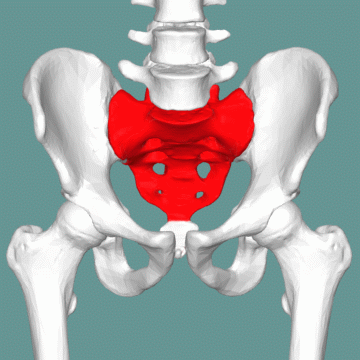

and the other gif is the sacroiliac joint where it does. And these Ilias. I knew illiad, what is illias..

and now some glorious marvelous medicine graphic,


Superficial posterior sacrococcygeal ligament
I like the other term coccyx, I like how it sounds and how it reminds russian копчик (кончик)
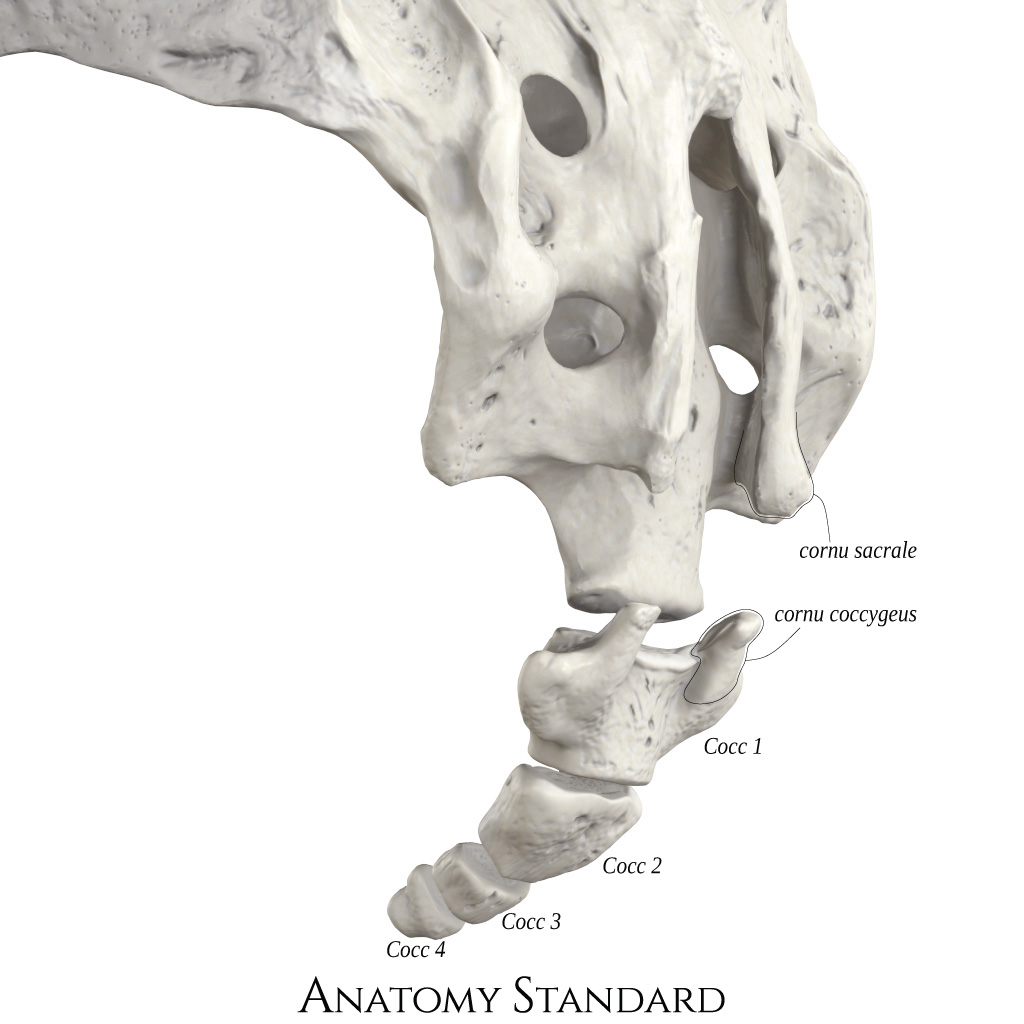
I wonder if what they show here is truly a standard and not some tail rudiment. Because be if I have these cocces, they're calcinated or something, because I never felt them move, I only felt it when I tried to snowboard, and I'm definitely not a sportsman. I know next to nothing about it and why would I mix with golden youth who grew with this. I should sit at home as an abomination I am, a wild child, a wild animal (it doesn't make me deserving death, but it doesn't make me deserving life eitherr)
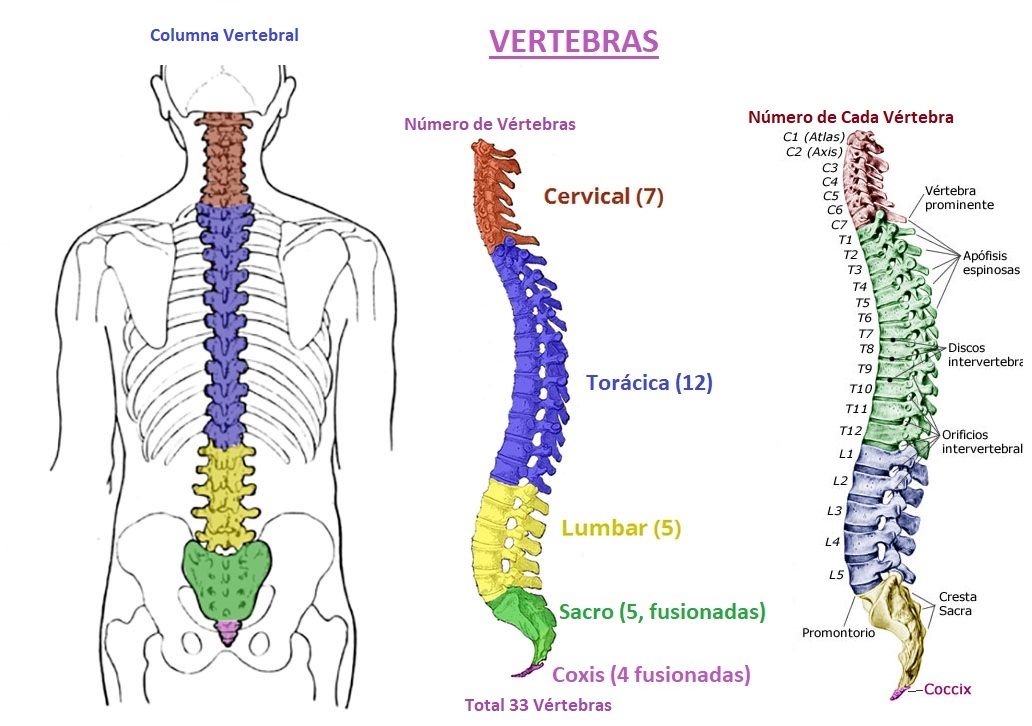
aha, fusionadas.
is it where the sanctity of 7 and 12 comes from.
is 26 of english latin alphabet is 7+12+5+1+1?
is 33 of russian alphabet is 7+12+5+5+4?
abcdefg
hijklmnopqrs
tuvwx y z
абвгдеё
жзийклмнопрс
туфхц
чшщъы
ьэюя
neither of these convince me of anything, but it is interesting that h reflects ж (because of ᚼ(or ᛡ) which is thus stands for both ж and з to make ij reflect ий, but then am I puloling int?)
This hypothesis is supported with the first two cerebrae being named with a: atlas and axis. I would like to see if it goes a all the neck and gets b-like names for toracics, or does it go b c etc in the cervical part. I know the word cervix because it is used for шейка матки.
A autnt анкл (ante) атец
Б братья батя бабушки мужей Вы
С сестра свёкровь свёкр зять жён сын Сей Zie
Д очь дядя daddy Du
F father
G grandfather, granny
I
M мама Me (mother teaches children to speak)
О отец
P papa, pater, папа
С сестра свёкровь свёкр зять жён сын Он (отче наш) Сей
Т тётя Тятя Тот
ni is chinese you
ani is jewish I, as if a- is that un-, ã-, non- (as if their I is "not you" but then it was ambiguous because они is also "not you")
ны[ny, ~ni] could be old form of мы (we) because нас [nas] (us)
bono is bonhomie (bono me)
I is both me and 1st person (Ik: belij ~ belak. is j fricative (palatalized) form of k?)
U is second person? (you, U)
Ш is third person? (she, Zij)
playing with ionian didn't bring much, but maybe ez reminding yz is that much:
Α
Β Γ
Δ
Ε
Ζ
Η Θ
Ι Κ
Λ
Μ
Ν
Ξ
Ο Π Ρ Σ Τ
Υ Φ Χ Ψ Ω
α β γ δ
ε ζ η θ
ι κ λ μ ν ξ
ο π ρ σς τ
υ φ χ ψ ω
Α Β Γ Δ Ε Ζ Η Θ Ι
I don't know if this sequence reflects itself around E or what.
9 could be good numeral system reminding ionian btw. H as voiced H? or Ж? ᚼ is 7th
ᛆ ᛒ ᚦ ᚾ ᚠ ᚵ ᚼ
Α Β Γ Δ Ε Ζ Η
but if I follow this pattern it becomes rather absurd, so it's a coincindents and only. runes have one letter less in the first line, greeks have one letter less in the second line, and between those loci it's pretty loco.
K seems to stand for kill, cut (kirei точёная (фигура, лицо) kiru to kill in japanese (キル) but that's katakana, so probably a borrowing from english. More traditional word is also k: 殺す (korosu)
In japanese to cut is 切る (kiru) the same kiru? did katakana come in use to divide japanese from european languages? To not be called related nations divided their languages by reforms made by pristhood holding pantheons separated. To wage wars, of course. Or for other reasons (I don't know, motherfucker, I guess money's on the mind)
And I found it when I recognized kshatri as some k-shudra, killing shudra he is, as all shudreas he prefers pleasant feeling to researching the truth. And is the truth maya? Is this world just a mist, a mirage, a sleep, King is k-ing as I said. Knight is to night, knowing, known, pawn? page is pawn.
katana knife (but sword, as if it doesn't cut, but chop, на топор чем-то похоже. меч от слова метать (мечи is both) sword is thrown? speared? sweared (sworn, ᚿ ~ ᚦ))
bln is probably bcd, and the way thay made it today, not triple, but pentle, petle, petal it's not clover but rose now? irish rules. Irish praise clover, the leaf of clover they worship has three lepels petals.
another word for axis is epistopheus

С for neck (cervical), T for breast (torso? thoracic), L for (loin? lubmar)
loins~reins could demonstrate how r is palatalized l.
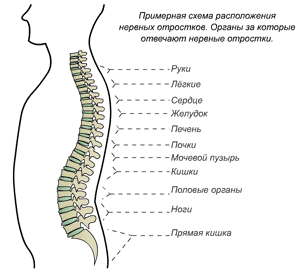


I'm noy sdhs not ashamed of going offtopic, because this thing is not online (buyt it may be) either way, it's a draft to be used or refused later, when I make a publishable version, right now I'm enjoying the total academic freedom thus watching for its natural boundaries (being rude to academia was counterproductive, but this is a manifesto in a way, even though this word is smeared by commies of all sorts, but degenerate artists too. This word is especially ridiculous in russian (but it's so low-class, that I'm not even explaining, watch bespredel for the roots of the meme) standing for some faggot fest.
Knorozov's studies in comparative linguistics drew him to the conclusion that the Mayan script should be no different from the others, and that purely logographic or ideographic scripts did not exist.
бросать бросить брошут
Жребий
бросил бросила бросило бросили ъ а и о
брос шд ил il
ила ~ ella
записать запасать
писать пасти
please plus
peace pass? but pass is pisatt, otpuskatt, pas is passport-control,zapas.
concrete с крита?
жребий
жреческий bet (бей ~ beat)
кидать кости
кости ~ жребий?
обжарки, объедки
остатки жертвы (несожранное) сжигали богам. чтоб диких зверей не подкармливать.
единобожие:
идея привести все народы к единому показателю, глобализация религии. и еврейской тоже? иудейское будет идентифицировано с другими религиями, и мы увидим нациоенально окрашенный дрифт одних и тех же идей.
кости имеют имена. не позвонки. кости. если все позвоник одинаковые, то какой смысл их по разному именовать. axis were they all.
axes, туз это позвонок?таз? ого
os как ось, axe and suddenly I see that axe is a hachet and ось is axis, axle, shaft, spindle, pin, center
The tarsal bones are 7 in number. They are named the calcaneus, talus, cuboid, navicular, and the medial, middle, and lateral cuneiforms.
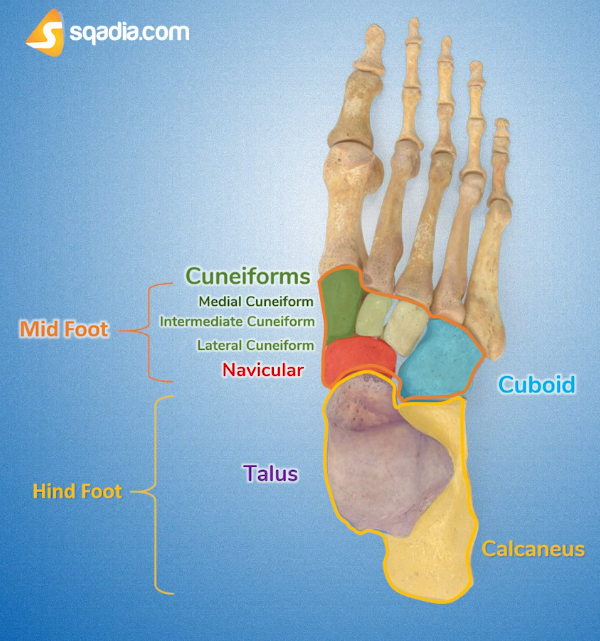
cuneiforms have the most interesting set of names: M I L are all from I-line, and as if it wasn't enough, N is among them.

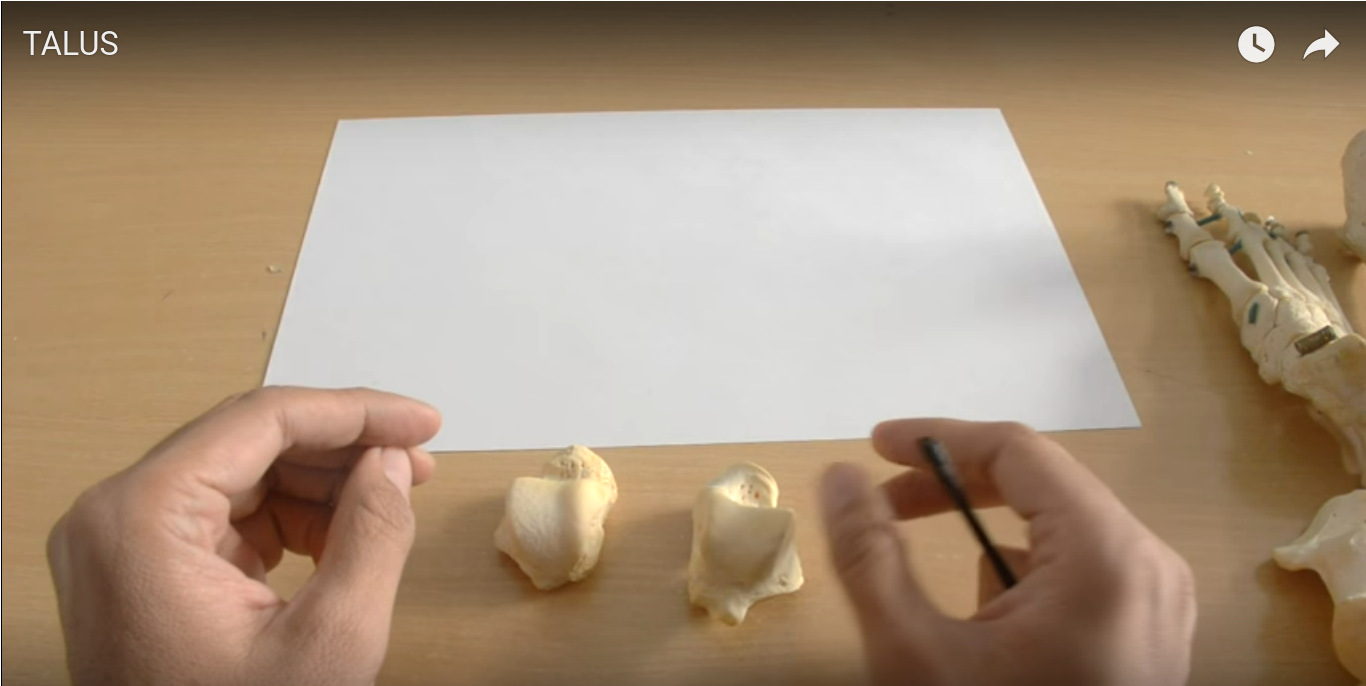
The talus bone or astragalus of the ankle joint connects the leg to the foot.
The talus is the second largest of the tarsal bones.
It articulates with the tibia, fibula, calcaneus, and navicular.
It occupies the middle and upper part of the tarsus, supporting the tibia above, resting upon the calcaneus below, articulating on either side with the lateral and medial malleoli, and in front with the navicular.
Use as dice
Due to the way that the talus bone is shaped, it can land in one of four positions. This fact led to the bone assuming a role as a form of die in games of chance and gambling, such as Knucklebones.
tallus, talli [m.]
young/green branch/bough/stalk
olive or myrtle (L+S) branch (2 Maccabee 14:4)
Singular Plural
Nom. tallus talli
Gen. talli tallorum
Dat. tallo tallis
Acc. tallum tallos
Voc. talle talli
Abl. tallo tallis
This is here because of such thing as talli sticks:
(orthography doesn't matter as much as we're taught to think)
A tally stick (or simply tally[1]) was an ancient memory aid device used to record and document numbers, quantities and messages. Tally sticks first appear as animal bones carved with notches during the Upper Palaeolithic; a notable example is the Ishango Bone. Historical reference is made by Pliny the Elder (AD 23–79) about the best wood to use for tallies, and by Marco Polo (1254–1324) who mentions the use of the tally in China. Tallies have been used for numerous purposes such as messaging and scheduling, and especially in financial and legal transactions, to the point of being currency.
but I was thinking of tally marks:
Tally marks, also called hash marks, are a unary numeral system. They are a form of numeral used for counting. They are most useful in counting or tallying ongoing results, such as the score in a game or sport, as no intermediate results need to be erased or discarded.
However, because of the length of large numbers, tallies are not commonly used for static text. Notched sticks, known as tally sticks, were also historically used for this purpose.
Друг дразнит, брат бранит, борони, больно ранит, глубоко ранит. в
(судя по царским разборкам, брат от врага недалеко ушло)
но я хочу быть другом со своим братом, и мы могли бы быть не привязывай родители его ко мне как младшего брата, не буть я таким интровертом, и так далее, мы с ним наверное дружбы, бранимир как bro-enemies (ir is norsk -es, and I think I've got how some letters differed in space, not just plane.
к~ц: корябать~царапать :б~п
коцать~цокать (кусочки cut, кусают, как и кусачки)
d
a b c
g
e f h
l
k
j
i m n
q r t
o p s
this 3d doesn't look like something great.
is grape the word used for wine? because it's next to rape
pussied out ~ пусти от ~ pushed out
abc [abg]
efh [evħ]
abd [abd]
evz [evz]
abd [abd]
evg [evʒ]
now let's play it out for aeiou
абз
евж
имŋ
опсь
уфщ
бы за
во же
мы они не
по со
for who (за що)
suddenly I recognize that just as the positions of L and R are strictly determined by axial symmetry, I suspect this determination was what damaged the I-line with K for IJRLMN maked somewhat more sense, also because R was recognized as vowel by hindus and thus can be in the calseter of IJRL, for so was L, and both R and L are vowels in some european languages. Were they the two vowels, the two strings added by priests of apollo to his lyre? the left and the right one ctave higher and one octave lower? They're not octaves, but tones: do# re# fa# sol# la#)
to my surprise mi and si(ti) which didn't make it to pentatonic scale (but then how do I know. Let's surf the subject of pentatonic notes' names) were the only ones ending in ti
do re fa sol la.. d r f s l? doesn't ring much of a bell. d e f g h? defgI? DFI? deify? and I recall that original scale was descending, thus I F D ~ А БВ ГД ~ alphabetic order of la fa do.. completely not memetic in its naming and I yet have to listen how it sounds.
10 = 십 = (sip)
11 = 십일 = (sip)-(il)
12 = 십이 = (sip)-(yi)
13 = 십삼 = (sip)-(sam)
14 = 십사 = (sip)-(sa)
15 = 십오 = (sip)-(oh)
16 = 십육 = (sip)-(yuk)
17 = 십칠 = (sip)-(chil)
18 = 십팔 = (sip)-(pal)
19 = 십구 = (sip)-(gu)
20 = 이십 = (yi)-(sip)
21 = 이십일 = (yi-sip)-(il)
100 = 백 = (bek)
222 = 이백이십이 =(yi-bek)-(yi-sip)-(yi)
4000 = 사천 = (sa-chun)
22020 = 이만이천이십 = (yi-man)-(yi-chun)-(yi-sip)
4,4444 = 사만사천사백사십사 = (sa-man)-(sa-chun)-(sa-bek)-(sa-sip)-(sa)
445,3555 = 사백사십오만삼천오백오십오 = [(sa-bek)-(sa-sip)-(oh)]-man-[(sam-chun)-(oh-bek)-(oh-sip)-(oh)]
learn to optimize your syllables, westfags.
>>
Anonymous 03/21/22(Mon)18:52:32 No.14322476▶>>14322640
9999,9999,9999,9999
= 구천구백구십구조구천구백구십구억구천구백구십구만구천구백구십구
= [gu-chun-gu-bek-gu-sip-gu-zo]-[gu-chun-gu-bek-gu-sip-gu-uk]-[gu-chun-gu-bek-gu-sip-gu-man]-[gu-chun-gu-bek-gu-sip-gu]
= 9,999,999,999,999,999
= [nine quadrillion] [nine hundred ninety nine trillion] [nine hundred ninety nine billion] [nine hundred ninety nine million] [nine hundred ninety nine thousand] [nine hundred ninety nine]
we're just alright ~ we adjust alright
I Lie Key My Nay
I My owN
любую выбирай (какая по сердцу, которая понравится, любу, le be, той самой будет.
люби let be. live leave love лови, люби (помни мою доброту, цени отношение)
Oh Pay Que aRe iS uS Today!o
π pi pie
штаты (те самые которые решают всё по одному советскому мему "кадры решают всё")
state состояние. Только состоятельные люди (способные поддерживать свои штаны) должны решать всё. как в сша и начиналось. пока силы реакции не махнули маятник в обратную сторону. Но разве это маятник? это спираль, и тоже скорей всего упрощение, мир движется куда угодно, движимый какими-то маятникообразными, будучи умноженными на развитие и боковым моментом маятника, превращённая в спираль, которая тоже четверичную структуру имеет (сравни с днк)
мила my love
meal
Solid is one of the four fundamental states of matter (the others being liquid, gas, and plasma).
Solid (geometry), the geometry of three-dimensional Euclidean space
In mathematics, solid geometry or stereometry is the traditional name for the geometry of three-dimensional, Euclidean spaces[1] (i.e., 3D geometry).
Stereometry deals with the measurements of volumes of various solid figures (or 3D figures), including pyramids, prisms and other polyhedrons; cylinders; cones; truncated cones; and balls bounded by spheres.[2]
Стереоме́трия (от др.-греч. στερεός [стереос] — «твёрдый; объёмный, пространственный» + μετρέω [метрео] — «измеряю») — раздел евклидовой геометрии, в котором изучаются свойства фигур в пространстве. Основными (простейшими) фигурами в пространстве являются точки, прямые и плоскости. В стереометрии появляется новый вид взаимного расположения прямых: скрещивающиеся прямые. Это одно из немногих существенных отличий стереометрии от планиметрии, так как во многих случаях задачи по стереометрии решаются путём рассмотрения различных плоскостей, в которых выполняются планиметрические законы.
solid (adj.)
late 14c., "not empty or hollow," from Old French solide "firm, dense, compact," from Latin solidus "firm, whole, undivided, entire," figuratively "sound, trustworthy, genuine," from PIE *sol-ido-, suffixed form of root *sol- "whole."
Meaning "firm, hard, compact" is from 1530s. Meaning "entirely of the same stuff" is from 1710. Of qualities, "well-established, considerable" c. 1600. As a mere intensifier, 1830. Slang sense of "wonderful, remarkable" first attested 1920 among jazz musicians. As an adverb, "solidly, completely," 1650s. Solid South in U.S. political history is attested from 1858. Solid state as a term in physics is recorded from 1953; meaning "employing printed circuits and solid transistors" (as opposed to wires and vacuum tubes) is from 1959. Related: Solidly.
solid (n.)
late 14c., "three-dimensional figure," from solid (adj.). Meaning "a solid substance" is from 1690s. Compare also solidus; Latin solidus (adj.) was used as a noun meaning "an entire sum; a solid body."
Entries linking to solid
solidus (n.)
late 14c., plural solidi, used of both English shilling and Roman gold coin, from Late Latin solidus, an imperial Roman coin (worth about 25 denarii), from nummus solidus, literally "solid coin," properly a coin of thick or solid metal, not of thin plate (see solid (adj.)).
Stereometry: from Late Latin, from Ancient Greek στερεομετρία (stereometría), from στερεός (stereós, “solid”).
so solid is latin and stereo is greek (объёмный в русском)
Somewhere near middle of my black notebook with golden ratio I thought of E M Ш being of this fashion, and I decided to look into this interesting triads or what are these, three similar sounds, invariants, tone to half a tone variations, pretty much like note, its bemol, its diez, and

and I don't know which one is natural tone and which are bemol or diez, like fa diez and sol bemol, why is it so? I have to become famous and welcome Adam Neely to coauthor something on the theory of music and alphabets. So far I notice that each trinity has sorta vowel for first five dtriadas
A E I Λ O.. wut? wow, it's nothing
what I see is that I need to find more variants of that thing.
---
8 9
\eight nine ten (ju?)
eitch ai djey
h i j
seven
G ~ Г ~ 7?
six
eF ~ F ~ 7?!!
five
F EF
Four
three
D
D devat?
Good morning, This is my meaningless morning exercise after I took on etoke, I will take a coulpe more and return in a moment
если про музыку, это шок-контент, очень на любителя, многие начинают паниковать и включать цензуру (не многие, но ты поняла из чьего числа, регулирование общества, но и религия оттуда же, однокоренное с Rei
и с решать. реш, голова в иврите. б(в) решит (берешит, перевели как в начале ..создал господь небо и землю)
древний иврит родственнен с русским. вот это приколы. отмстить неразумным хазарам
b ~ v
реш ~ решает решка - не с орлом а с головой?
Встречается версия о том, что название произошло от слова «ряшка» (лицо)[8], поскольку на русских монетах достоинством от полтинника и выше на противоположной от орла стороне монеты в XVII—XIX веках традиционно находилось изображение головы правящего в государстве монарха.
ряшка ряха рожица рош как рожа хахахаха

is it why russia fails? Because we have wrong understanding of what resh is. rosh, russia. We of all nations are supposed to know. Mozgovia, instead of Moscovy or Ruscia. We have to return heads on money. But those heads should be of some people of the past, but who? We have people who hate them all. Russian mooney are cursed by our shitty politicians. People should vote heads of our past on our money. Pushkin, Tolstoy, Solzhenitsin? Mendeleev! Nobody will hate Mendeleev. Almost nobody, only those who don't know who it is, and didn't understoon the rules (haters have to explain why and jourie should check if the voter understood the rules, and all those hating opinions would be published and voted again or not? Why not. The system of direct democracy should be implemented, and it will excuse everything. People who love putin will vote for him to be free. People who hate them may vote for executions. People are savage, but such they made them.
орешек маленькая голова? 小 [お]
o is an interesting word in japanese. The meanings are tail, cord, male, и как в русском мальчик родственно слову маленький, так и жина жирна небось дева от слова раздаваться? Не пускали женщин из пещеры? приковывали на хозяйстве? Врядли, какое=то мрачное прошлое. Но древние венеры жирны. Мужики ходили на охоту, а бабы нет, а жрали все вместе. Ни надо никого привязывать, такая она дура чтоб с твоей хаты уходить, хаха. Только если выгонишь,
т.е. в японском о = шнурок, маольчик~шнурок, шныряет? шнырь could be semantically identical to some accepts of the word boy.
I need more coulours, it would be too exhausting if I coloured less importants parts of text as I have to. I wish I just marked the important part. I have to always write in greyish. To highlite the importat parts.
Much better. but alas it won't last long.
никого ~ немного
ко(que) ~ мно (моё, на меня)
ничего = ничьего. чьё как -y'ed of кто, the whose of who. что=чьё. т=ь? ноу. oh I make myself some
あさ 麻
Noun
1. cannabis (Cannabis sativa); hemp (plant)
Noun
2. hemp (fiber); linen; flax; jute
Other forms
麻 【お】、苧 【お】
Notes
お: Out-dated or obsolete kana usage. お: Out-dated or obsolete kana usage.
cord is o because weed is wow! (cord are made of weed people knew before they learnt to make cords.
麻 is osa, but o is not just a honorific, it is the honorary plant. sa is some suffix
берешит как порешил. прикинь, перевод танаха на когнатах
берешит бара элохим порешил батя "эй лохи" (локи?) этим пускай искусственный интеллект занимается, а то на костре ещё сожгут за богохуйство
а бара тут как переводится
создал
от born скорей всего
bear
а баран тогда тут причем
baaa-ram
ягненок
yean (ягниться, родить ягнёнка)
звучит как in (b в начале слова то же русское в)
бара породил. порешил породил (но это поэзия, не наука, "это несерьёзно")
I reach out (out of my circle)
Я кричу (кричи к rich'у ~~~ потому что ровне ты на ухо шепнёшь)
g and d are different as go and die or go and do? or both? or none of above.
вбери ~ убери ~
в ~ у ~ вы- ~ вы ~ U
in = you? ni?
в ~ вы
ва ву вы? ~ въ = во = вы? ва = вся? вообще / вы а чё. вы ещё /
я снова гадаю. жди озарения. ещё и мир от мыслей отвлекает.
вычти ~ учти (подсчитай)
подотчи, отчёт отцу. отчитался отче наш. отстрочил, отсчитал под считал. (подсчёт ..)
чти отца.
люби бога
чти отца, но оказывается что чти отца это аж 6th 6ty 6тй 6тя (та=the) comendment commandment
commandment ~ comendment ~ comend ~ mend ~ mind ~ m'ing (maying, making, thus ijkl, the same suffix in all the form V~W~N~й~j~y~ч (в руссокм кажется два равнозначных суффикса фамильных: ов и ин (оба работают как суффикс родительного падежа у разных слов, и что интересно, in ~ во (ко украинский вариант to~в)
russky are rude, may them become moscy, of moscow, ах моська знать она сильна что ал.. лает на слона. mosca of moscarine. amanita muscaria (мухо-убийца) because red is our colour, and in this account russsia and china have to unite. But we demanded americans to take us over instead. Or brits, or dutch, with the colour of our flag. But with putin we changed it from dutch colours to what are they? american? And russians had different colours, they have some poor comprehension of colours, but the russian blue and russian red as they are present in this one, I like it the most. It's neither yeltsin's nor putins but some non-institutional and the best.

and norsk flags made me suspect alphabet to be in those cells:
A B I J K
C D L M N
E F O P Q
G H R S T
I like how C reflects G and K reflects Q, but then these are from the c-column of axial symmetry.
And so I notice, if I recognize C as G as it is in greek and russian, as how it was in old Latin (They wrote Caius instead of Gaius. Was it EFH then? And we have the triad, where ᚴ is ᚳ)
I played with these flags in my image editor, and it seems russian flag has unique hughes. Are all of them good? Isn't there whole new branch of psychology to tell how colours feel? I think they may be the most based branch of that field.
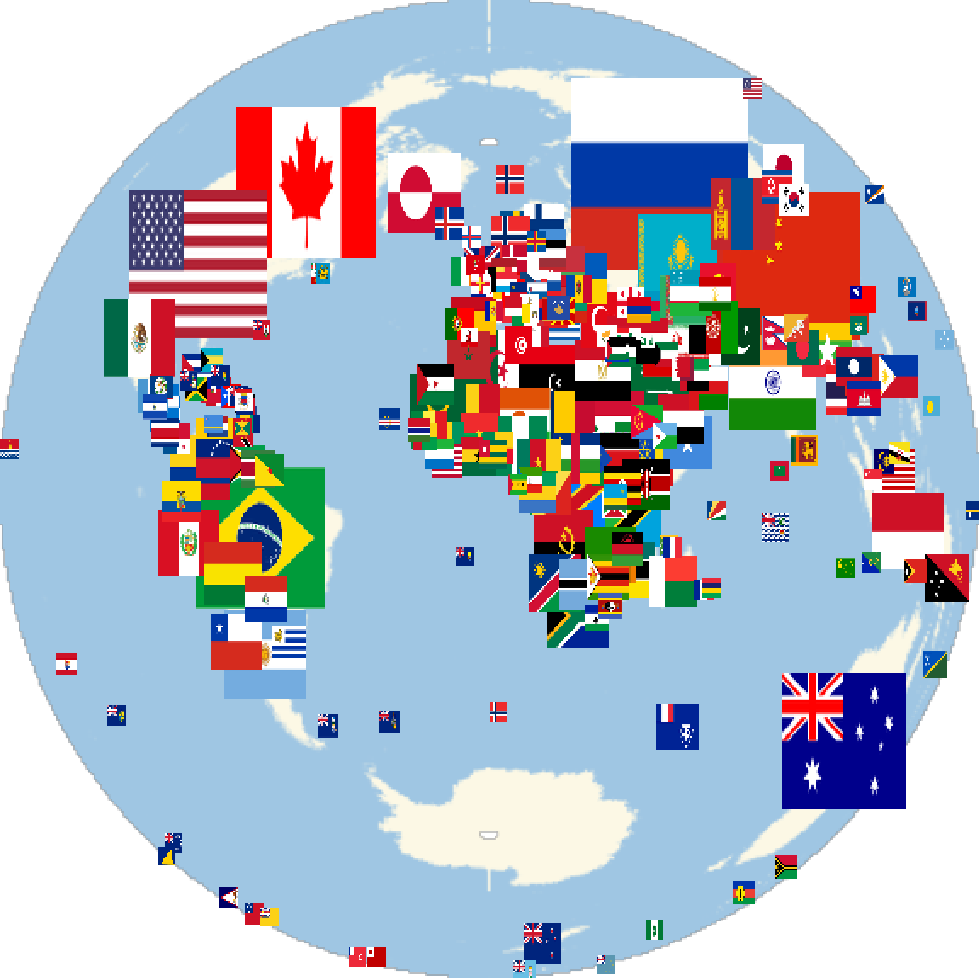
Eng or engma (capital: Ŋ, lowercase: ŋ) is a letter of the Latin alphabet, used to represent a velar nasal (as in English singing) in the written form of some languages and in the International Phonetic Alphabet.
In Washo, lower-case ⟨ŋ⟩ represents a typical [ŋ] sound, while upper-case ⟨Ŋ⟩ represents a voiceless [ŋ̊] sound. This convention comes from Americanist phonetic notation.
ħℏ♄are three similar signs: the ה, the Planck constant, the Saturn. Wiki tells about that astrologic sign of Saturn: κρ for Cronus with a cross-bar indicating an abbreviation; cross added in 16th c. but the source of this claim or how they see it I couldn't find. I see the cross, but the cr.. is h cr?
And here I found wiki lying: I was looking for ה and here it comes:
Хе[1] (иногда хей или ѓей) (ивр. הֵי) — пятая буква еврейского алфавита. В иврите обозначает глухой глоттальный щелевой согласный [h]. Буква ה в конце слова может использоваться как матерь чтения. Является одной из пяти букв, которые не могут нести сильный дагеш, то есть не удваиваются.
И в роли матери чтения, и в роли обычной буквы (как в начале слова, так и в конце) может являться частью многих вспомогательных элементов слова, например:
как мать чтения с предшествующей огласовкой камац — окончание женского рода;
в конце слова с предшествующей огласовкой камац и маппиком — местоименное окончание, обозначающее «принадлежащий ей»;
в конце слова с предшествующей огласовкой сеголь-йод и с камацем внизу — местоименное окончание, обозначающее «принадлежащие ей»;
в начале слова с огласовкой патах и сильным дагешем в следующей букве — определённый артикль, а также союз перед причастным оборотом;
в начале слова с огласовкой хатаф-патах — вопросительная частица.
Произошла буква ה от финикийской буквы 𐤄.
Письменная буква Хей
Гематрия буквы ה — число 5.
but when I was taught in yeshiva, it was voiced. It is voiced, but maybe some dialects read it voiceless, I know it as voiced.
(notice: lies, but lying. i~y? a trick not to have double i in liing or was it lijng and lyng and further ing got the traditional form and y was left for being more familiar in there?)
Notice that it is official wiki's position:
He is the fifth letter of the Semitic abjads, including Phoenician Hē Phoenician he.svg, Hebrew Hē ה, Aramaic Hē He0.svg, Syriac Hē ܗ, and Arabic Hāʾ ه. Its sound value is the voiceless glottal fricative ([h]).
Like.. what? is it what hebraists are told to tell goyim? is it how they pronounce it? Was I miseducated?
It seems voiceless is whether another variant to read it or the only variant to read it. I'm yet to figure it out.
This make hebrew pronounce H instead of E and greeks pronounce E instead of H, it could be as with the hats (hebrews cover their heads in church, and christians take their hats off in church, somebody's doing it wrong or what is it all about? h for hat? purely a coincidence.
בְּרֵאשִׁית, בָּרָא אֱלֹהִים, אֵת הַשָּׁמַיִם, וְאֵת הָאָרֶץ.
לברוא like in library
I think I've got into some other timeline, because before this moment ה and ħ were voiced, and now it seems that both are voiceless. Like what is going on. And I have to notice, that before this moment I always used ħ for voiced h. And maybe I also used ה for that sound from time to time. Even though I consider it to be historically E or some other vowel. E.
The voiceless pharyngeal fricative is a type of consonantal sound, used in some spoken languages. The symbol in the International Phonetic Alphabet that represents this sound is an h-bar, ⟨ħ⟩, and the equivalent X-SAMPA symbol is X\. In the transcription of Arabic, Berber and Hebrew as well as a few other scripts, it is often written ⟨Ḥ⟩, ⟨ḥ⟩.
Typically characterized as a fricative in the upper pharynx, it is often characterized as a whispered [h].
..or rather I fell for jewish tricks and they taught me wrong
But now I want to record my biologic ideas. Let's collect all the cycles we know we can have:
heart beat
breath
sleep
shaking of cold or anticipation
some epileptic vibration (or some rare vibration of the wave coming through my body from time to time, and only giving me few seconds to catch onto something not to fall.
What will happen when all these vibrations resonate?! To know this I have to build that capsule.
This is a handy alphabetical list of element symbols for all 118 of the chemical elements on the periodic table. Every element symbol is a one- or two- letter abbreviation of the element's name.
No-letter as a simbol. Empty slot as a simbol. & as a letter and as a comma. Word divider, : before spacebar.
kingdomcome
we're not strangers to solid texts.
слова сливали? буквы слиты в словах, здрасте это здр разве распадается на буквы? или оно одно единое что-0то таранслитерированное таким образом?
Обезьяний звук радости получился когда я попытался произнести здр все одновременно.
Разбор звука на буквы подобен анализу фурье
hi подобно тому здра (потому что в сущности оно происходит от радостного полусмешка, непроизвольно может быить произнесено именно от радости. Hi as shourt Ha, or closed Ha.
Not haha of long haa, which turned into haha by the periodic fluctuations in our nature, but ha. of hi.
salve is thus cognate of здрасте. and of hello
seseseesese can be another way to laugh. In korean it's kekeke (which is closer to hehehe, than sesese, but all three are probably the same ᚲ (even ᚳ of h) and does it make sou ~ duh? hai ~ да because d ~ c ~ ~h and it explanes the position of h, it's the c of abc (gh as a claster of c's. cd is the claster of c's all lingual are c's)
Great is like three linguals Г L T in alphabetic order (maybe it's nothing, but I felt like saying being pleased how Greatsy continues this line)
Satan is Smert
Б-г is Being
Teufil is Tott. Is it Thoth? Thoth is some ancient thing, and thus could be demonized in ..it could vbe a coincidence.
Be with b-ing
in = во
at ~ во T~V? to in. to me in me to the book in the book to the supermarket в магазин
to = до
in = n = в (in = no. ni is also a dialectal form of no, slavic no is ni. their no is but, bu is no in chinese)
allat mannat al uzza
all it mine it and other
всё моё и ваше
all mine thine
a (in general)
me (mine)
thee (thine)
or
all
mine
their
or, as I said, thee is of they, maybe they is many thee's the's
king killing
ring rilling? trilling thrilling? ring is thunder?
ring ding clink chink! sing!!! ting tang tinkle tingle jingle
tink like tinker bell? (there was no tink in google's collection)
rill is spring the water source. rill ring. ring ri'll
sing saying
sing stilling soothing?
Ring was the ring of water? Where animals could drink and where it made up lakes or rolled over and on as a river.
finger fings? fing filling!
things fill?
a letter to a reader I didn't send because I have these discoveries are offline and not archived.
If you find something factually (or logically) inaccurate in my texts, please let me know. I've just few days ago found that ħ and ה are both voiceless (and I was taught it was voiced, and always heard ה thus, it's as if I switched the timeline (but more likely I was just taught wrong, or in some other dialect, but then why ħ(ℏ♄) too? Probably, because I read that ה is ħ, and thinking that I knew how ה was pronounced, I misunderstood ħ, but then this opens the possibility of the dash being used for making the letter voiceless, and then t is voiceless l, and f is voiced but what? voiceless ᚢ? Or do I give me too many freedoms?
It doesn't change much (after all it even made it similar to greek Η which is pronounced as И(i) in ionian (modern official) dialect. But that Η stands where some other H stands: ח and is ח and ה historically the same letter? is E and H? And ŋ is engma. It doesn't change much in the context of this work, because I retransliterated ה as vowel E anyway, and I hardly ever used ħ. And in the following text I don't make this mistake, but if you find the earlier editions it will.
What it teaches you is to test every piece of evidence in case it is by malice or accident is wrong.
(this colour will be used for pieces writing the next edition of the book. The first actual publication)
white bright light might fight hight sight right
i'ed? where i is Jah? I as ego. Его.
друг значит дпругой (не ты, другой, в смысле не я, а кто-то другой, другие друзьями считались. враги варвары? вороги воры?
A E I O U
B F M P V
D G N S X
I had my own reasons to place G and not C: D'ness of ᚦ, G as primary pronouncement of C.
And suddenly I see another reason, which tells yeahy
ᛆ E I O U
ᛒ F M P V
ᚦ Г N S X
these are three aettir by 5. inspired bty aeiou. I would complare it to what burreus gave, but I think I would notice it, they don't have it other thabnt ᛆᛒᚦ, but lets' look at them again:

am I ripping or are they with some stretch labial, vowel, lingual? And yes I am.

If that Y is not Y but ᚴ, as Bureus tells, but I only found ᛸ and they say it's aesc (I've no idea if ae or sc) then I am tripping indeed, but if it's not, we have I and A in there, and H is vowel in greek and what about hebrew, and thus we have reminding that H and (Н is N in russian and И is their I) and because they're placed graphically reflecting eachother, I expect that to be what? his own gues?? he would tell.
It its interesting how ᚮ reflects ᚠ how they are both labial, so is ᚢ which actually reflects ᚱ which is drawn as.. r? and I spoke about labiability of ᚱ, and the other rune in that aet is ᚦ, which is recognized as θ but then that θ is pronounced similar to F and recognized as Ф by russians. Comparing cantonese to mandarene, I suspect russian forms to be eastern (which is supported by the reading of H as I in attic dialect, which was at the east) so I suspect reading of θ as Ф to be eastern standart, when reading of θ as th, the θ of ipa, is the western standard, thus romans borrowed it like that.
It's funny that that first aet has something like ᚢ at the top, and the r of ᚱ is shown together with the other (the staveless) shape of ᚢ. But then ᚱ as ᛦ could be that if staveless, and how ᚱᛦ stand next to one another in bro bornholm alphabetic runestone.
Though most of letters in the third aet are lingual, it make me believe that that aet is lingual, and M being not in its column doesn't surprise me at all, but what about B? If I can tell that ᛘ is not ᛘ but ᛉ, what about ᛒ?
And though I see that there is about the same ammount of vowels, labials and linguals and that I can arrange them otherwise. Let's guess futhark is actually another canon, as halaham is. And if that th is Ф, it's Fuф-ark (three linguals and three not-linguals. r isn't lingual anymore? how convenient!)
Because entertaining this thought I found four vowels and four linguals, I suspect them to be of knucklebones and thus only 4 linguals I suspect to be there (because 3 aettir is canonic, and 5 aicme probably used to be 3, obvious when you compare its name with its structure.
ᛆ ᚾ ᛁ ᚮ (a candidate for the fifth is ᚼ(or ᛡ)?)
ᛒ ᚠ ᛘ ᚢ (candidates for the fifth are ᚦ and ᚱ)
ᚦ ᚴ ᛚ ᚿ (candidates for the fifth are ᛦ ᛋ ᛏ)
I suspect the labials to be b v m w
then linguals are d г n s or something like that. Maybe ᚦ ᚴ ᛦ ᚿ the ðgrn
russian (rossian) money are called rubles or roubles, like what were the chances
(russians who think they speak english pronounce it as rubble. руша. (rubble, russia. a o u, unpalatalizing vowels)
твёрдое RЪ (Ъ looks klike Ⱃ is some fonts even more)
Let's work with glagolythic row. Let's divide 365 days for 365 different writing systems. Or just record how many times UI return to some systems, and find the champions (other than latin, greek, russian, hebrew, of course. I don't look at georgian at all, I should make tomorrow the day of georgian, today it's glagolythic.
ⰀⰁⰂⰃⰄⰅⰆⰇⰈⰉⰊⰋⰌⰍⰎⰏⰐⰑⰒⰓⰔⰕⰖⰗⰘⰙⰚⰛⰜⰝⰞⰟⰠⰡⰢⰣⰤⰥⰦⰧⰨⰩⰪⰫⰬⰭⰮ
ЪЬ are Ra Ri (eR, eRj. a Rъ a Rь. R, Ri)
Whi hard form has that diacritic hat? Ri form is more truwe. Just above c/с stands R/К the next similar key, and it makes me think that those who invented querty did it not arbitrary, but knew all the keys. Some magic under our fingers. Why else would they want to attribute some keys to them. Somebody had to know this stuff Somebody made some sense of ti when keyboards were invented. And it was before . It was invented when typewriters appeared, centuries ago. So I have to read works of those who rationalized one or another keyboard to be used for standard (in every nation large enough to print their standards)
All true scvience is interdisciplinary, thus them making people take only one subject is anti-swcientific.
solids are hard object and 3d-objects
liquid of lake are water, and plane is mostly applied to water, because land takes all shapes and forms, 3d forms.
air is 1d? (I knew water was 2d before I have rationalized it, simply because there are 2 nubers before 3 and water is next to solid of them all, so it was next. and fire is one, fire and smoke, gases.
fire is single because it's in numbers: 1 spark, 2 spark, 3 spark, 4.. calories or joules, but then territory is in naval metres, not counting the mountaneous additions. Because those addition can always be removed or enlarged, so only the naval surface makes sense in measurements pab abb babylon does
руша беруша
груша грусти (россия для грустных это переделка мема россия для русских)
мог бы умереть (будущее изменилось, чем отличается от..
мог умереть ~ мог бы умереть (бы это be? dropped in more common russian)
можешь = мог ещё, mag yet(nog) можно = mag nog
nog ~ no? not gon or
nog mal ~ normal (a dutch person wondered why russians tell normal where normal person would say good. Normal is russian good, so dismal their lives are. Would brits and duits suddenly found themselves speaking russian if they moved here? how is it? nog mal (но, и дальше те опасности, которые могут подстерегать, но которые не произносят чтоб не привлекать. no, now. nog mal now)
now на у(даче, спехе, довольствии)
back to бы
ты бы дал мне ~~ ты бы не дал мне ~~ ты дал мне ~~ ты не дал мне
suddenly I notice that Ukrainian and russian alphabets both have 33 letters, so yep, these alphabetis see to be mutilated in the name of some lame numerology.
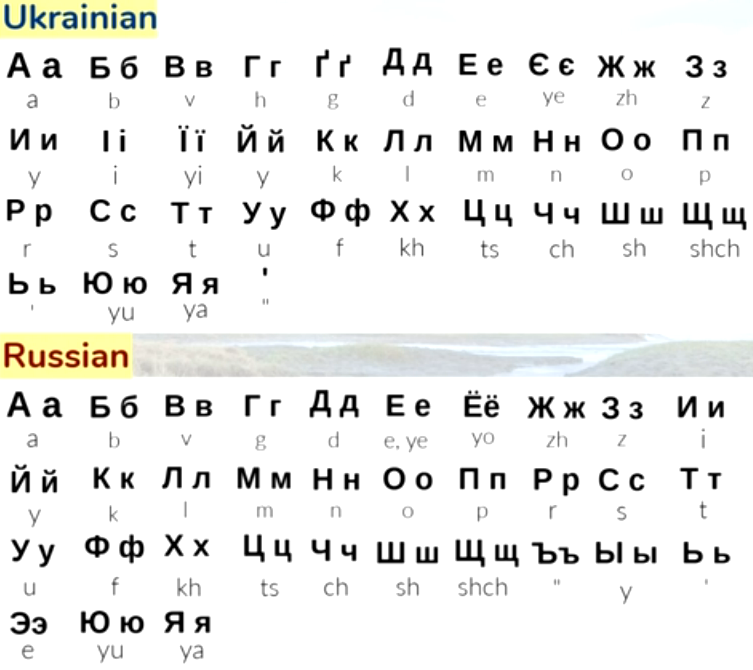
and it that video I'm informed that voiced h is not ħ as I used to think, but ɦ
To my surprise, with all that difference between russian and ukrainian, they also pronounce the -го suffix as -vo:
or probably this is how my russian ear hears it. Now I think she sings svogo, not svovo. Does it prove that ukrainian orthography influenced the russian one? They published books before we did.
Як тут лукавий по литаврах б'є чимдуж
Там громовиця в такт співає
Я відповім за грішність свóю, я скорюсь
Та перш, до помсти завітаю
Гори
У чорнім полум'ї
Все, що життя не вартує
Що симулює справжність і, поготів
Там, де є зрада
Пекло мені не завада
Я повернусь у край, де залишився дім
Повір'я, прокльони, пророки
Не змінять моєї волі
Я власниця свого життя
Не він, не вона, тільки я
Повір'я, пророки, прокльони
Не змінять моєї долі
Я власниця свого життя
Не ти, не вони, тільки я
Я по вугіллях попростую босоніж
Та я сама нечиста сила
Не дочекаюсь тої миті я, коли ж
Всіх покараю справедливо
залишився (остался) is cognztic to russian лишь as in лишний and english leave. As if just like god is г-лдь (господь) так и leave is л-в (лишив)
and that root links to лежав (залишивя ~ залежався (залежался, завалился, закатился))
and I thought лишь ~ leave told that ш~w (as in wha ~ що.. шо? ша! some semantic differect could be caused by that difference in value of vowel)
it also seems that ukrainians have more free stress, because she sings залИшився, but g reads залишИвся. I wonder if it makes them more free as people, when in russian only military faggots change stresses and e to ё without being frowned upon, even admired for such inventiveness or something, for freedom actually, they'r free to do many things you're not.
and thus nations are sicked against each other because knowing neighbouring languages you can see the cognates better. How else whoud I know that лышать in слышать. Even though I knew ухо, I never thought that сл is not root in слухай. сл~подставляй? set? sell? соли? слей? no much of an idea so far.
But then that слухать is related to лежать. Did our ancestors layed down to hear what happens far away? Did ancient people tam-tam the earth so that travellers could hear them far away? Is it where Tesla's ideas are based? Did icelanders or irelanders were prohibited to sing not by christians, but by their druids so that christians didn't hear where they were? We'll definitely return to this interesting topic.
Лёжа ища уши ищут учуют подушка подлёжка подложка!

I want a dictionary of such. And I g it for "forms an abstract noun from a verb"
and I have several finds:
-ovath, regularly forms an abstract noun from a verb.
I had some good one today when I was a guest somewhere:
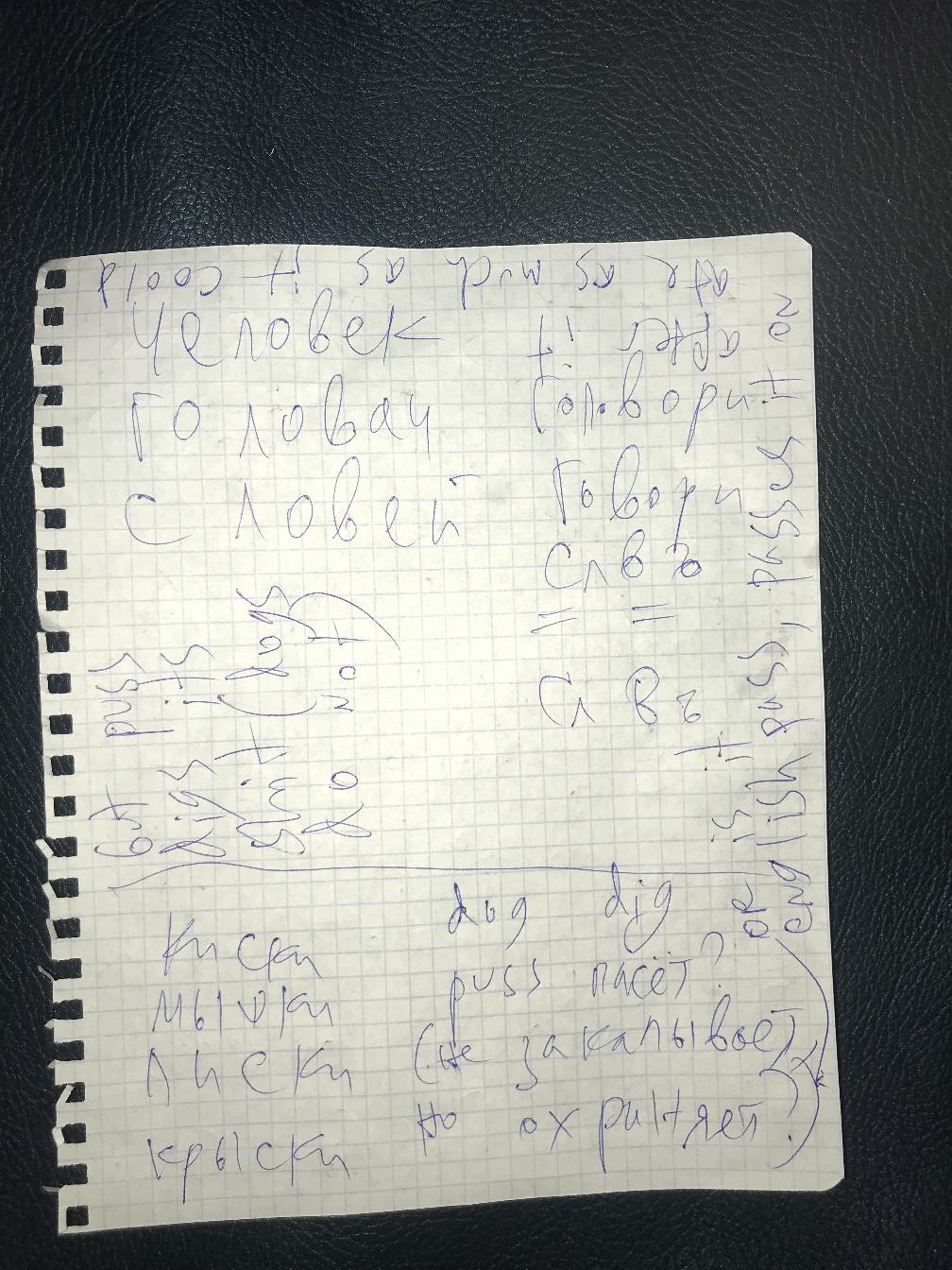
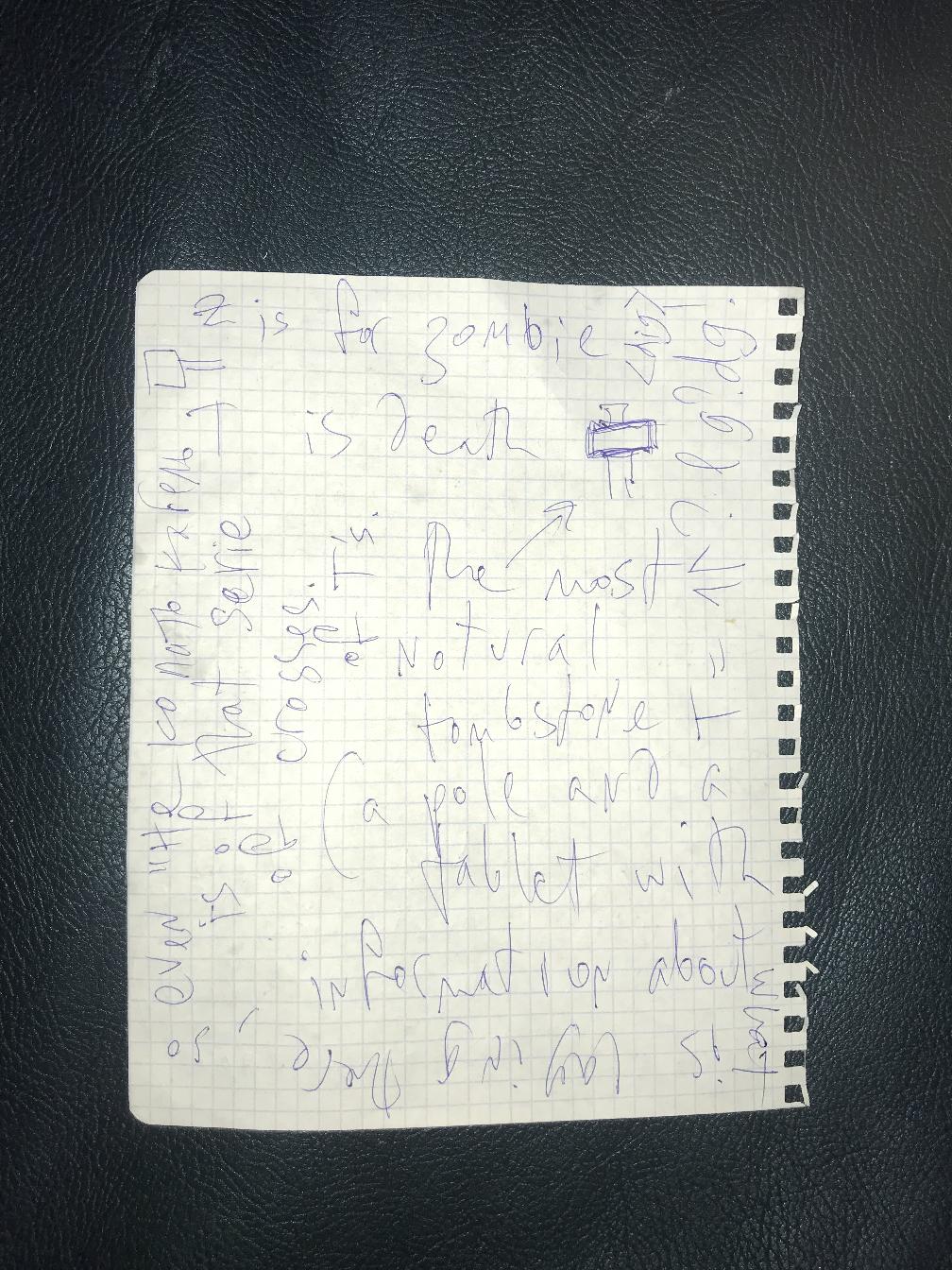
When I noticed that even if animals understand us, they cannot speak like us (we may entertain the thought that we can speak like cats or dogs, but only like some parrots we may, we have little idea about what those baw-baws mean.
But thinking about cats knowing that only humans are speaking, cats rarely react, so they're as if they're not understanding it at all, as we don't understand their miaw most of the time (sometimes they ask us something, but I don't hold a cat so what do I know. A woman who holds cats told me that they don't understand our speech, but I called a cat and it reacted and everybody laughed, but I think she tells that they don't understand the conversations we're having, which could be true, because we also understand cats when they call us. So we only understand vocative case. maybe only imperatives, and I'm not sure about that.
So I found a better (or making that diad triad, that doublet triplet. the legendary triplet)
говор совол word слово голова
говорить словить головить
головори соловери
бери дери мори кори кури сори жарь парь вари это всё latinskoye re and japanese ru and ri
чоловик где ч = c = г = с
съловик.. силовик?
сила слона..
сила слова
слова слога
его слогом
иво словом
г and v disputing (putin disputing just like they're doing in
дом дым (домок дымок)
smoke дымок homeoc
some same семья
same ~ семья
we all speak the (same) language we don't recognize
мы все говорим тот (же) язык (коий) мы не узнаём
same ~ семья
God = love. Г=L
влага благо
liquid = lick lake weed (жидкое и сыпучее измен измеряется в литрах. в liquid-rah
lid = drink eat? le + it? жидкое и твёрдое.
solid has the same id so it makes it of the same kit.
sol is sole, single. like objects are. sand is liquid. is it? yes. you can have dunes out of sand. Hills. sand single? no, sange, no, not this too. sand is these? песок потёк. ссать сыпать пать как падать. сс = с-
но как было у меня в прошлый раз? solids were 3d, not single. Different school or structure seen in chaos.
Вдруг осознал Русь оРдой:
рутенией, рудой, родной, родиной
ордой ори давай
орда = ура
золотая одр орда одр.. нутро.. одурь.. оторопь одурь попускает. пинает п-даёт (подаёт, поддаёт)
н = дд? но поддень не понень. поддумать понимать? подумать понимать. понял поднял подумал.
human = умён

золотое троекратное орда орда орда!
esoteric ~ historic (some obsolete, but historically widely held beliefs are esoteric)
франкисты ы=en
ы = e nasal, ё?
ы = i nasal. y?
уф хцчшщ
ъыьэюя
uvw xyz
z~я (аз(а))
аз was above I
but then Ing-lisk-men('em'en: em is im plural. как ты и те.
франкист ты? звучит так же
ты и те. те множестенное число от tu? u=y=ы. I noticed before taht s reminds ij
but why ы is in ты if it's singular? it's also in вы. was U[w] singular form of вы? t~v? ты~вы is the epicicle(?) of it. epicentre it is.
на счёт франкистов это про невзорова вспоминал, что он всё говорит, что добру служить ему западло, но судьба мол его выбрала. И что правду говорить ему не нравиться, и гордон улыбается а не вопрошает wtf, они оба франкисты, жыды. да-да, детка, жыды, но ты расслабься, как и я, вот же жыдовская подстилка, трус.
-ы -s is the third similarity between qwerty and йцукен, but in these six pairs I see no similarity, but I miss R & К there.
у & е? like in ugaritic? hardly it is a case. I have a present from a jew: as one smart man told me "there are so many elemnet in these systems, so you can see anything, it's all coincidences. very sterotypical.
q й? q g ж j й? не слишком ли? но qvinna~жена. If it was something else, it would be q~f as in latinske four and five.
Я картаво говорю р, а потому мои русаки ближе к гусаки чем к трусаки, и вспоминаю про гартинку, где гуска переведено как утка, а трусак как кролик.

Но нет, гуски как гузки, тоеж гадость. Надо ордой себя осознавать и разделяться по интересам и бассейнам рек.
Having spoken of Asgard~Midgard~Utgard, I now began looking for how it looks, and I found that they're drawn differently:
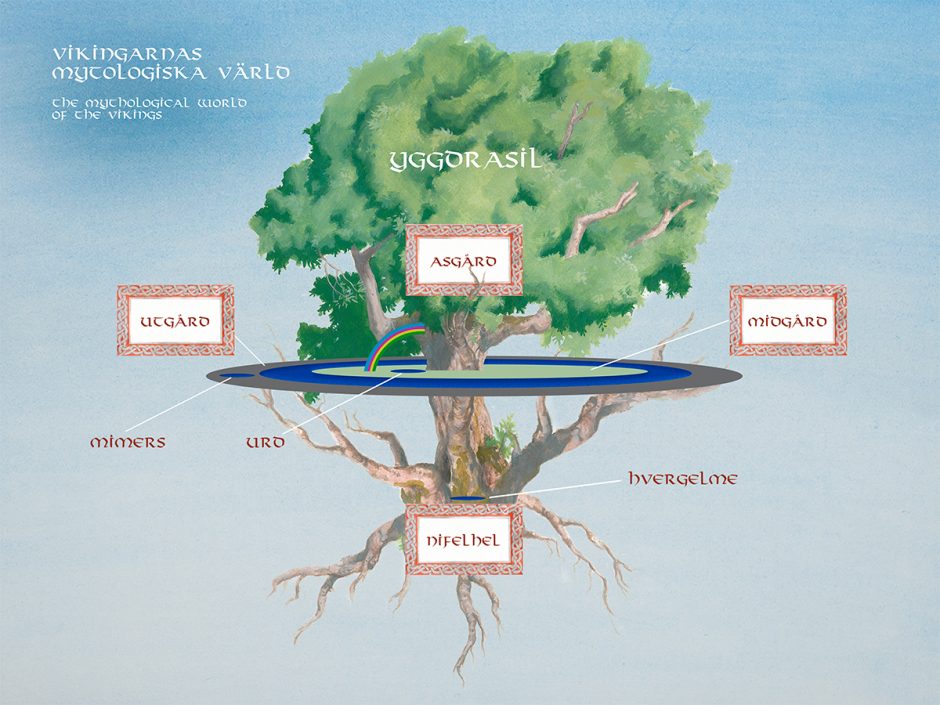
_The_Cosmos_in_the_Norse_mythology.jpg)
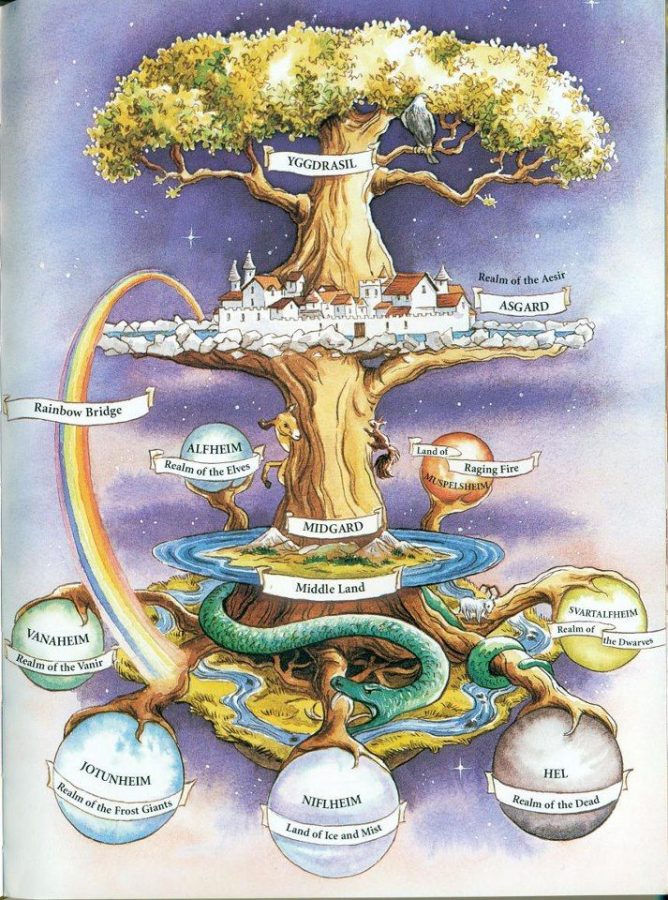
This one doesn't even show Utgard, because according to the myth I read and the next image, it's some world outside of ours:

In Norse paganism, Freyja (/ˈfreɪə/; Old Norse: [ˈfrœyjɑ], "(the) Lady") is a goddess associated with love, beauty, fertility, sex, war, gold, and seiðr (magic for seeing and influencing the future). Freyja is the owner of the necklace Brísingamen, rides a chariot pulled by two cats, is accompanied by the boar Hildisvíni, and possesses a cloak of falcon feathers. By her husband Óðr, she is the mother of two daughters, Hnoss and Gersemi. Along with her twin brother Freyr, her father Njörðr, and her mother (Njörðr's sister, unnamed in sources), she is a member of the Vanir. Stemming from Old Norse Freyja, modern forms of the name include Freya, Freyia, and Freja.
Freyja is aFrodita and fairy and фея, θεά
колея колеса. коло, соло
but let's research that thing with norse cosmology some more. And I find in the process, that Asgard, Midgard, Utgard are the only places in there which rhyme like this (all the other worlds are heims, which I suspect to be not город, but home) and I thus believe that most of representations are not exactly correct, and when it's Hel bellow it's whether they influenced christian narrative or the other way around, and I suspect the other way around to be the case, and this tree of life things remind cabbalistic tree of life very much:
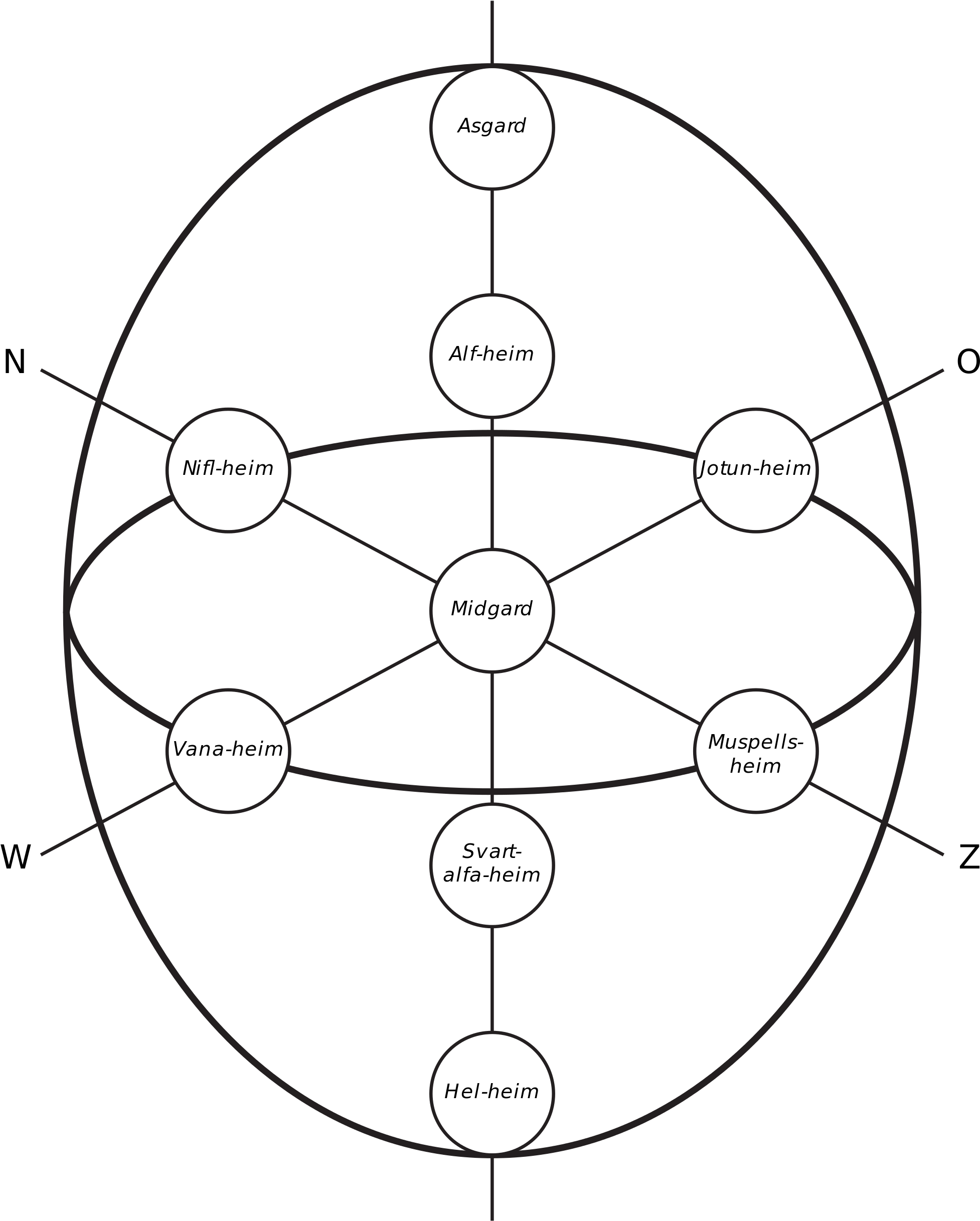

This one is very interesting, but it makes me wonder if it's true. It's probably not genuine.
and the one I was speaking of when I mentioned Hel:
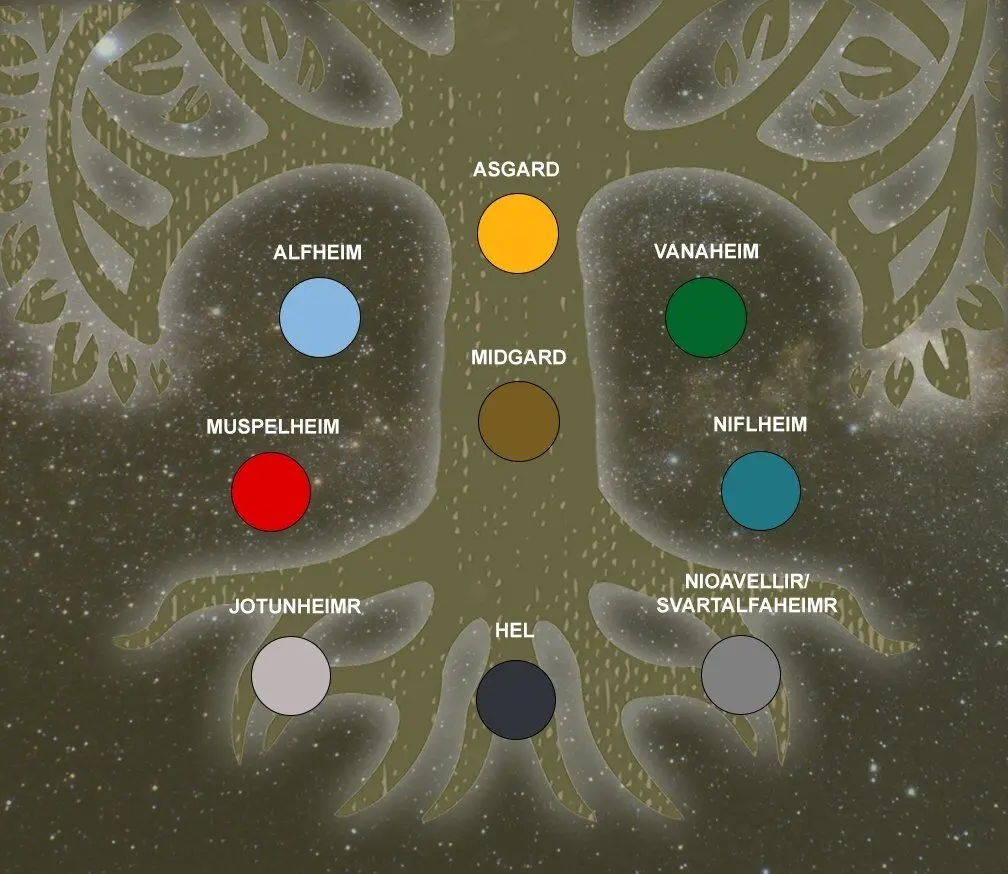
This obne is different from the ones above. So who knows if any of that is true, I will sort these pictures into my norsk department and let them be the basis of that field. And I delve somewhat deeper into that, and some 9 sisters, which is similar to muses, and the way their names go make me go hm..
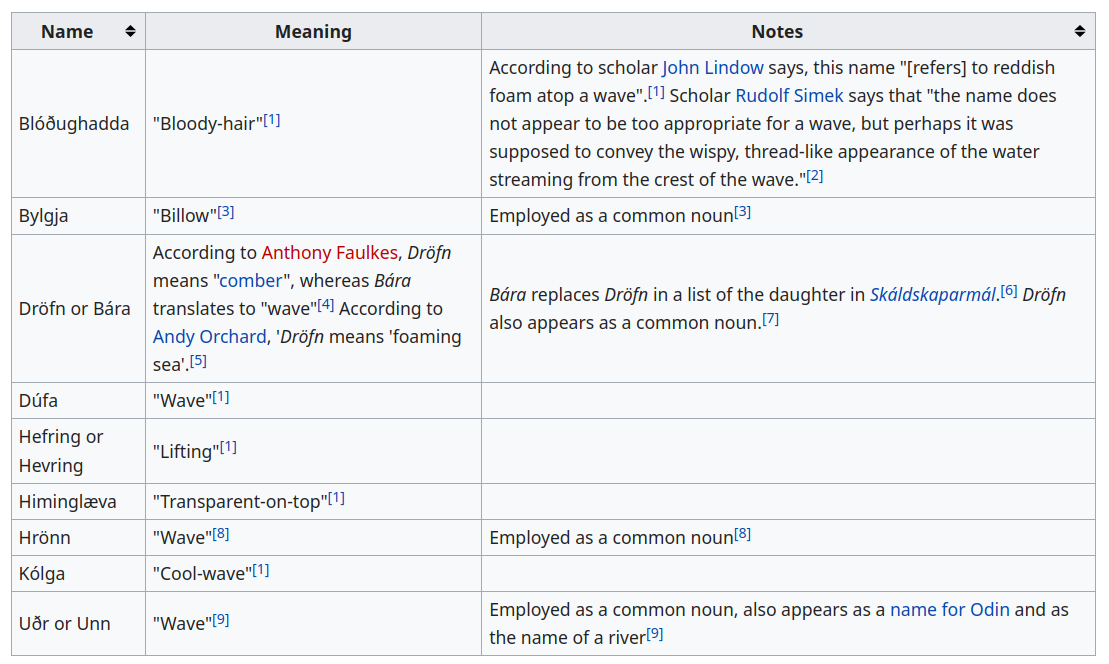
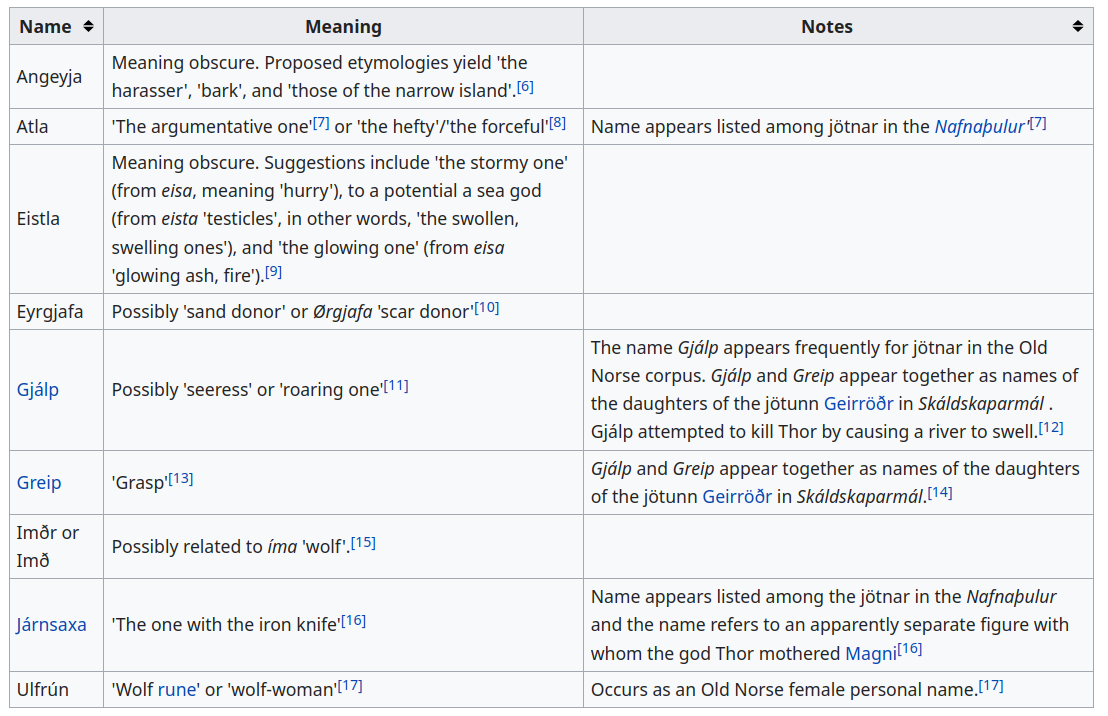
Those 9 mothers are the mothers of Heimdall, "the whitest of the gods" "the brightest of gods" "the most glitering" light bringer, blonde, блядь as derogatory form of dieu bla (which is my semiblasphemous guess) but here he brings gifts of gods to men:



gods have spoken
whorey is a rhyme to sorry. And thus sorry may be used to set oneself under that hit (such hits are fun and are easily excused by being funny)
more yet. is another one. or not.
what he plays is bandura, guitar neck-deck bound to gusli. band as of binden. bind like in combined.
German just pretends to be alien by its archaic manner of not separating words: Durchschnitt seems like nothing yiou know, but actually it's durch the cognate of through & через, and schnitt which is snip maybe, schnitten is to cut, and maybe it.. whatever, fuck etymology, only mnemonics matter, or they both do, but mnemonics matters more. to cut is: schneiden, senken, abschneiden, reduzieren, kürzen, zerschneiden
Maybe I learn gernma properly some day, but first ukrainian.
aphantasia next to fantasy may tell that orthography doesn't matter much or at all.
even if these words came from cognates in greek and latin, it doesn't matter much.
Воля и Доля would make more sense in the context of labials symbolizing passiveness and linguals symbolizibng activeness. But then what if that is what it is from the point of destiny and not of an individual. But this way of though makes me see that I can prove anything like this. Which is not very good. But then the fact that I don't have rigidity in this thing is excused by the fact that I don't know the laws, I only strive dowards figuring them out.
Will & Deal are pretty much cognates of those two.
genie ~ genius
genie ~ Genius ~ gene
brahman mudrets druid
drug mediciner doctor.
mediciner medicinist (similar semantically remind comparative suffixes er & est)
bra ~ dra ?
drug ~ vrag? дружина (братва) ~ вражина? was all the fuss about how to pronounce that magic letter? And how to write and where to place it in the alphabet probably too.
bog и гад
орангутанг ~ orangutan (that an is ŋ) to my surprise in russian it also has not г at the end, but see where this lame example leads me:
n ~ ŋ ~ m ~ saw demotic 𓅓 and though of ŋ again, and this:
ŋ ~ מ
so different fonts, different signs can be placed at the sdame level because they were based upon some same concepts, but that level will be vertical, in time, because ŋ is a modern shape, but then its roots are that deep that how can I tell thaty it is different than 𓅓, but I can. They're two different signs even translieterated a little differently (very much differently, but phonetically they're very similar (sonor and nasal and voiced as all sonors.) can be recognized as twio shapes of the same.
(orangutan is pongo in latin, which is close to monkey, both words could be borrowed from the same word)
I almost always understand belorussian, which is closer to ukrainian which is closer to polish which is closer to some czech or bavarian which are close to german which is close to dutch which is close to english.
And then there's bulgarian, who could be our link to bulgars who spoke some turkic as they say. And there are also uralic languages, where may be link to finnish. But first I gotheukrainian way. Or will I ? I must learn that song today.
Як тут лукавий по литаврах б'є чимдуж
Там громовиця в такт співає
Я відповім за грішність свóю, я скорюсь
Та перш, до помсти завітаю
Гори
У чорнім полум'ї
Все, що життя не вартує
Що симулює справжність і, поготів
Там, де є зрада
Пекло мені не завада
Я повернусь у край, де залишився дім
Повір'я, прокльони, пророки
Не змінять моєї волі
Я власниця свого життя
Не він, не вона, тільки я
Повір'я, пророки, прокльони
Не змінять моєї долі
Я власниця свого життя
Не ти, не вони, тільки я
Я по вугіллях попростую босоніж
Та я сама нечиста сила
Не дочекаюсь тої миті я, коли ж
Всіх покараю справедливо
як как (j~k, these cognates tell that position of letters is semantic too? The structure is phonetic, but then additional letters were placed next as cognates in semantic manner, thus k is among ijl who are phonetic or graphic or some other claster)
чимдуж чем дюж, чем силён, со всей мОчи (мочить в смысл убивать от слова мощь, а не моча, но пердячий пар это на фене синла)
громовиця молния от слова гром, жена грома типа
вартує worth
відповім отвечу (удивительный суффикс для меня новый, но корень я узнаю, в русском есть отповедь)
но затем я вижу этот суффикс в русском дам:

these forms are ukrainian futurum
рзповісти is a typo, it's розповісти, рассказать
скорюсь то же что покорюсь, и видна природа слова: корить значит ругать, т.о. покориться = покорить себя (а не того, кому покоряешься)
перш сначала (перший первый (и снова ш~w, как в what что & to leave лишить (relation which is more clear in ukrainian залишився) но ещё ближе русское прежде, как g и переводит, видимо меж русским и украинским блока на когнаты нет, быть может даже напротив, дабы русские на украинский перходили)
корись is next to curse and cross:
креститься ~ кориться
so it's better not to cross yourself in any way (not to evwen cross your arms? and legs? don't cross your legs not to stumble, but when a girl crosses her legs stepping left with her right foot and right with her left, she's a bad girl)
благослови благо (бога)) слови (позвони, вызови)
скорюсь вместо покорюсь являет разницу в украинском мышлении: не по корану, а с кораном. не покрестить а скрестить (как пальцы скрещивают)
умирать помирати
у по
разные предлоги, но умер и помер одно и то же (в русском тоже помирать есть, но оказывается это более украинская форма, чем у, но обе губные. и быть может в где-то там же.
до помсти ~ к мести ~ to revenge
завітаю приезжаю, в русском похожее слово навещаю (I will visit, stop by, drop by. ukrainian english is better than russian) but even more than this it's as if it's related to видеть (to see) which links meet to vid.
I just noticed that I have Mark Margolis who also played Sol Robeson in the second video as if smiling from there I found a lot but not a system, what an actor!
Thinking of Allat Mannat and al uZza, I thouhgt of mannaz, ᛗ and I thought of 𓄿𓅓𓅱 where 𓅱 is officially recognized as u(w) but I suspect it to be s(ш)
Because mannaz is definitely M, and I suspect ᛗ to be double ᛘ, it could also be another ways to bind ᛆ and ᚿ. ᚿᛆ as M. Na (because M~N: 𓈖)
This version is pretty much over. I'm out of weed and I will not buy it. To build my capsule I will promise my mom to be always sober to communicate to her specialists.
I should study augury.
This type of omen reading was already a millennium old in the time of Classical Greece: in the fourteenth-century BC diplomatic correspondence preserved in Egypt called the "Amarna correspondence", the practice was familiar to the king of Alasia in Cyprus who needed an 'eagle diviner' to be sent from Egypt.[4] This earlier, indigenous practice of divining by bird signs, familiar in the figure of Calchas, the bird-diviner to Agamemnon, who led the army (Iliad I.69), was largely replaced by sacrifice-divination through inspection of the sacrificial victim's liver—haruspices—during the Orientalizing period of archaic Greek culture. Plato notes that hepatoscopy held greater prestige than augury by means of birds.[5]
One of the most famous auspices is the one which is connected with the founding of Rome. Once the founders of Rome, Romulus and Remus, arrived at the Palatine Hill, the two argued over where the exact position of the city should be. Romulus was set on building the city upon the Palatine, but Remus wanted to build the city on the strategic and easily fortified Aventine Hill. The two agreed to settle their argument by testing their abilities as augures and by the will of the gods. Each took a seat on the ground apart from one another, and, according to Plutarch, Remus saw six vultures, while Romulus saw twelve.
I have to study a lot, but now I give up weed for I don't know how long. Additional reasons to so do so is the program I type it in is lagging again, and 18 volumes are good, because I can numerate them in those runes, because they're 6+6+6 because I realized that I have to live forever. Before that nothing matters. So let's not speak more than what I can deliver, let's deliver first.
Namaste is namas te (te is to you (te je? tebe is to you in russian, but te is also underst=ood, and this way) namas is bowing and thus sanskrit unites semitic languages to slavic and other european. муслимы делают намаз когда кланяются до земли.
богема бога есть? бога ест? бога ищет? бога ест когда грибы ест? тогда же и бога ищет, но это лирика, зацени что я сегодня прорубил:
или вырубил

18 ends. And very runic, and I immediately saw it as galdstav as I rmember it, but the term is something else. Looking for the term and going Icelandic Magical Staves, I found a similar word: galdrastafir which is that thing in icelandic, but I didn't know that word before or is it how my memory works? I saw this or previous morning a paper with something like quinta-quarta circle, but it was out of focus, because I don't remember it by heart, I remember it out of focus, kinda remember, without the details. So that memory (which I saw just before waking up) was crumbled away when I couldn't see what it was, as a leaf of some thickest paper or some thick cotton-like tissue which I cannot compare exactly with anything I know, as if you tried to imitate a leaf of paper out of plasticine.
So I wanted to find such snowflake with 18 runes, a rune at each end, but then I forgot that 18-rune set is not that vwery popularly known. And then I saw that it's a bindenstav of many runes and who knows maybe all of ther mare there somewhere in one or another form, and here's the closest to that stuff I've found so far:

but though it is definitely lame because many runes are not along those lines, but then maybe those runes can be exposed aas not authentic. But the idea itself is interesting, because it links them to rhombic dodecahedron, which could be there where everybody sees a cube.
решил забыл спрятал ил=ed, not 'll which is weird, russians have there u.
профан выдаёёт себя за профи но не знает как читается проф-ный (професииональный)
does it explain what pro-l is?
Philosopher's stone is every solid, beccause for some stones solids are structures of theirs, the ideal shape. And they probably knew it because the crystals grow accordingsly. to them.
And that is how Democritus (or his school for others say even his teacher knew it) figured out atoms. Observing the crystals growing.
just typoed in a letter: theory instead of serie.
philosopher's stone is probably every solid. And they were looking for solids (or minerals) which would transform not only sea water into salt cubes, but also ..and I came on fantasizing of window pane made of solid crystals of salt, grown out of some salty water in some cubic bath. and I imagine music applied to that cubic wall, to grow them faster, and though vibration may help, or may not, who knows. How would htey make the even tone without obertones? and maybe some high cilindric tubes could be the keys or hitting the wall with a hammer made of salt crystal
I began smoking weed further, and it seems I must. I just changed the dealer. Because look at that, a philosopher's stone.
what was I saying. Solids are Stones and Space. Liquids Surfaces are Water and Planes. Dots are Carpuscules of Air? dots are sparks? Air is good A if M is море, water, W, and S of solid.
A B C is the more known formula. Aэро Ватер ??? Carbon?
or is it Ard of Earth, Ветер, Земля.. я гадаю. подбираю, брутфорс.
A B C
B is water, that's for sure, labial liquid. but lingua is more liqua. L is lingual.ng is lingual, because in labia labial is b, thus la bia, le ngha ngua
Sea is C if A is earth and B is air
I'd say earth and air are having the same slot, because air was probably invented later, when there were four elements instead of three.
A B D
D is derevo, three, tree.
два вода.
С is fire (сажа, I don't know why, but k associates with fire in my head, maybe because of something japanese or chinese, I don't know why. Гори. But many wards words avbo about fire are labial: пламя, flame, fire, пожар. жар is the root of the word.
But why would C be fire if the Air is the fourth position. Because it used to be fire and water? Tree growth out of earth if there's water. but it burns. Earth is unification of fire and water? Sun is essential for the growth.
a one. одни~огни
fire is first? Agni is 1
(and I didn't even expect fire to be so close to first)
Вода is 2 (Б~Г)
Древо is 3, three, tree, tri, три
д дери tear
б бери, but bear~tear
but then дери and бери are pretty much the same (mayb are from the period when b were equal to d)
а ори?
б бери
д дари
бе is no (просторечное, синонимы: фу как в японском, boo (bu) как в китайском.
бери = бе, рви. бе~тебе? как те от ты, так бе от вы? классно прёт. давай-ка даже звёздочоу дадим.
𒀭
This page is already lagging in my editor, but I keep on going, because it almost doesn't, but I ahve already figured that it is the final part of the volume, so I expect some 5550666ness, sickness, but actually repeating after after bible (I paused there and even at first forgot to finish thei line)
when bjork wrote something in the name of muslim migrants, I wanted to say bjork is such a jork. Or I didn't I now would.
устоять утаить (рифма лишь или глубже повязаны? утаил = устоял (не сказал) во время пытання.
snowflake divides circle into 6 segments 60 degrees each.
Then why doesn't this circle do?
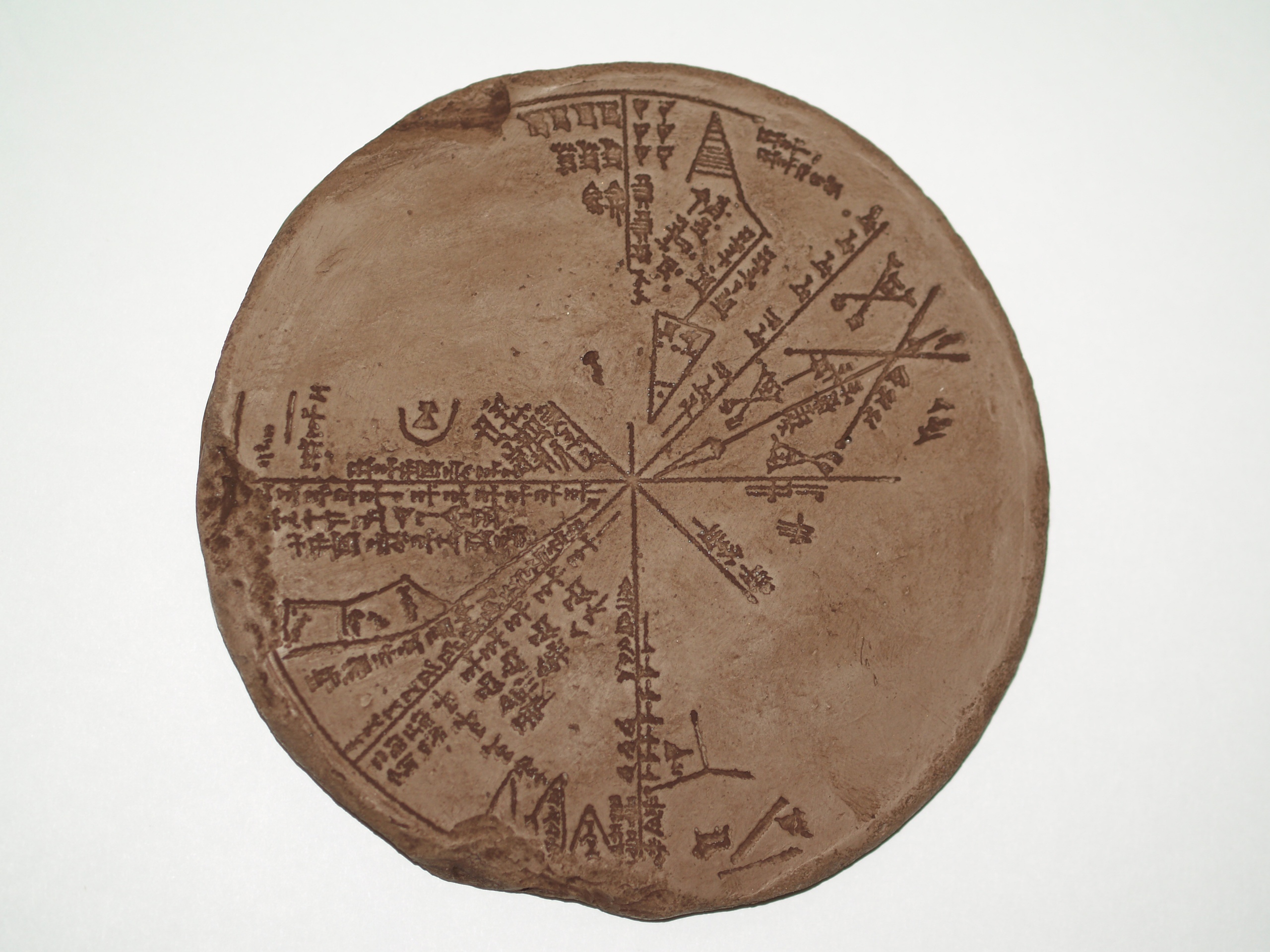
if they had sexagesimal numeral system, why would they divide the circle into sectors of 45 and not 60 degrees? were those 45 60s? was that 360 480? I doubt it, 360 is too sexagesimal a number to reinterpret it. But of course reading this thing could help, but I still don't know cuneiform.
A B D I said?
B D
be do
бог дьявол
baby daddy
(I just bring first pairs coming to my mind)
boy gевочка (if b~d thing is b~c and c [g] in the past,
bright dak dark
br~l? is the opposite the r dr? is l of m? too many questions, too much of a mess.
big and bolshoy demand to be one of the pair but what's the antonym with d? child? kid? кроха?
bolshoy crohotny? big смол
big small!
but then it is too much of the tolerance, but maybe not. but gross would be if it had to be, I take too much of liberties. It is a job for ai not a puny human.
revelation revolution
reveal revpo revp;ve revolve
volve seem to be a suffixed form of veal or vail (was first vail be made of veel veak veal?)
veal seems to stand for both meat of a calf and its skin, which is the thinnest leater there is if all the fabric they had back then was leather.
other fabric seems to be invented by the three mothers also associated with vowels, b and t.
Three mothers invented weaving? Thread making! maybe weaving and/or knitting too, but then it could be archetype of women doibng their thing and communicating, spreading rumours, working as their own states. with their own telegraph.
love, вуаль, way, with this kind of phonetic liberty I think many great words are abcdic, and that is great isn't it.
ik sequence caused by that being semantically the same suffix y of ij? ij ~ ik or ic. j~g? it would also explain k in that area.
𒀭 (I wonder if it can be seem as 𒈦 (or 𒑏, but not 𒋥) and the right part of 𒊉 and left part of 𒁍 like that 𒈦 is in the 𒈧 where it's 𒈦 and 𒄭 (compare to 𒀖) and looking for that I found 𒄬and there's also 𒋓𒌒 andt there's also 𒐣𒐤𒐥 and yet 𒌐, but I only find the double shape: 𒆜𒆝, and there are also 𒀮 𒀯 𒀰 𒀱 but I couldn't find the combination of.. 𒀹 and 𒍻
(there's also 𒀺.. 𒑰 𒀸 𒑠 𒍺𒍻𒍼𒅂 𒃵)
Б-г
Devz (vz is probably θ)
Gd is misreading of that line caused by addition of A which made the meme Abe (father, even though we still recognize that god is sorta hermafroditious, which is rather gay tbh, desu, gay mafia still pushes that father figure. But where do we get the concept of двуполый бог? from russian childhood and that childhood was soviet from 1976 and so on, it wasn't horror of the early years of the state, buθit it was suffocating)
because us is a suffix, a male suffix, so it's two words merged together. because of it,
bg
de
is all the line, Ω and V and maybe even ᚢ are rudiments and evidence of that order:
bcde
fghijkl
mno
pqrstu
vwxy
z
so wah what is that? why z?
This way we still have those jklm mess and instead of y-problem we now have z-one.
without z it would be cyphred into 25 of 5*5, because that thing had to have been cyphred because nobody seems to know abouty it.
a b c d e
f g h i j
k l m n o
p q r s t
u v w x y
this one is nice because it has m as the legendary middle letter it is. and y ~ v opposing a ~ ʌ
and the one without a for an alternative representation of such a square:
b c d e f
g h i j k
l m n o p
q r s t u
v w x y z
bg de
is g-d an imperial (unifying) form?
𒀱
I see this sign like this:
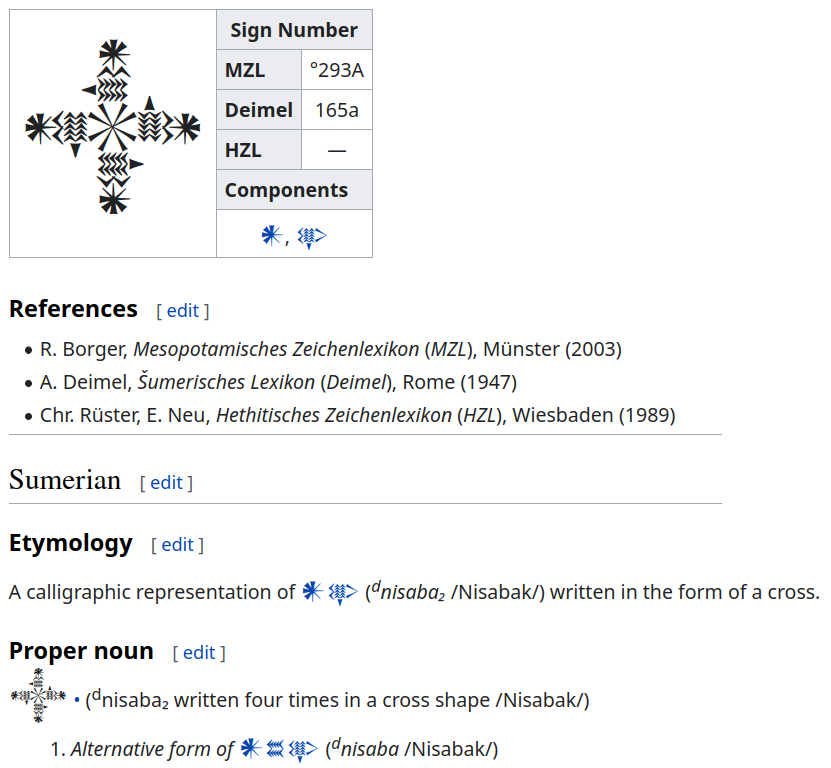
but the image at that page shows it in the other form,

and I recognizwe the top character, it's that ⵥ-like shape BioViva used as a logo when they began. And ⵥ also stands for something divine, like what were the chances, like ⵥ is the 𒀭
and I never saw that thing that letteror the words, and I read it immediately ni sabak as ani (oni?) sabak, some god sabak:
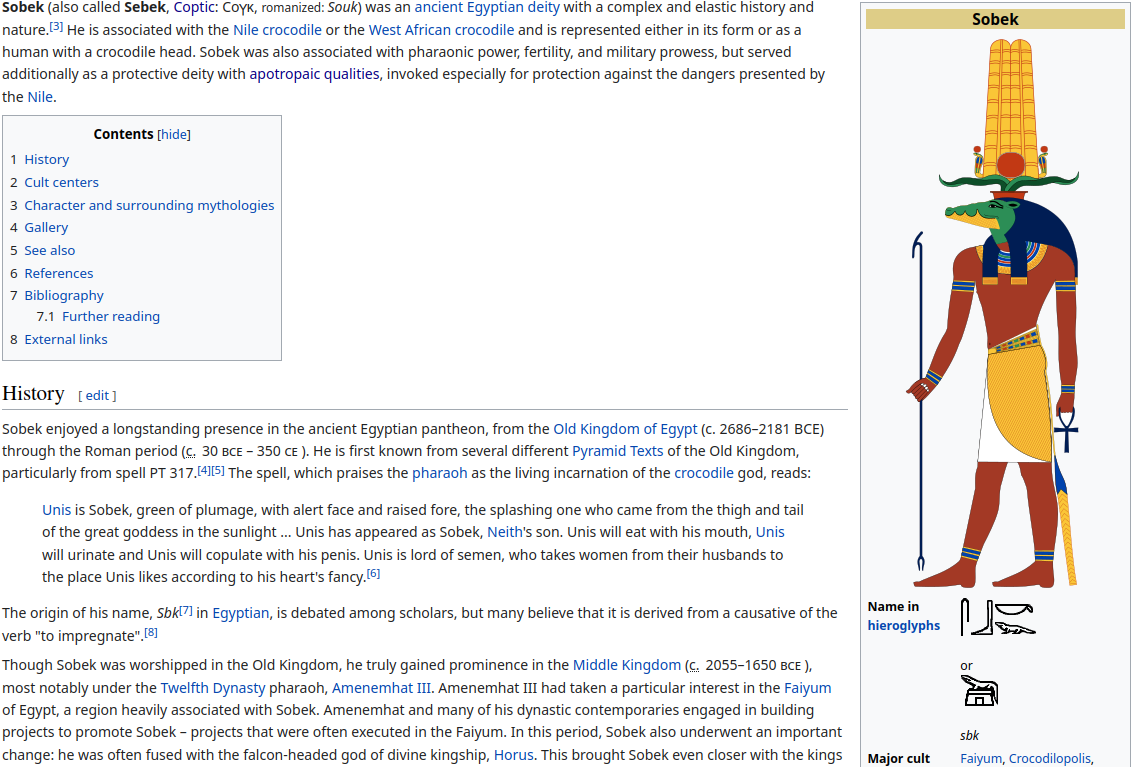
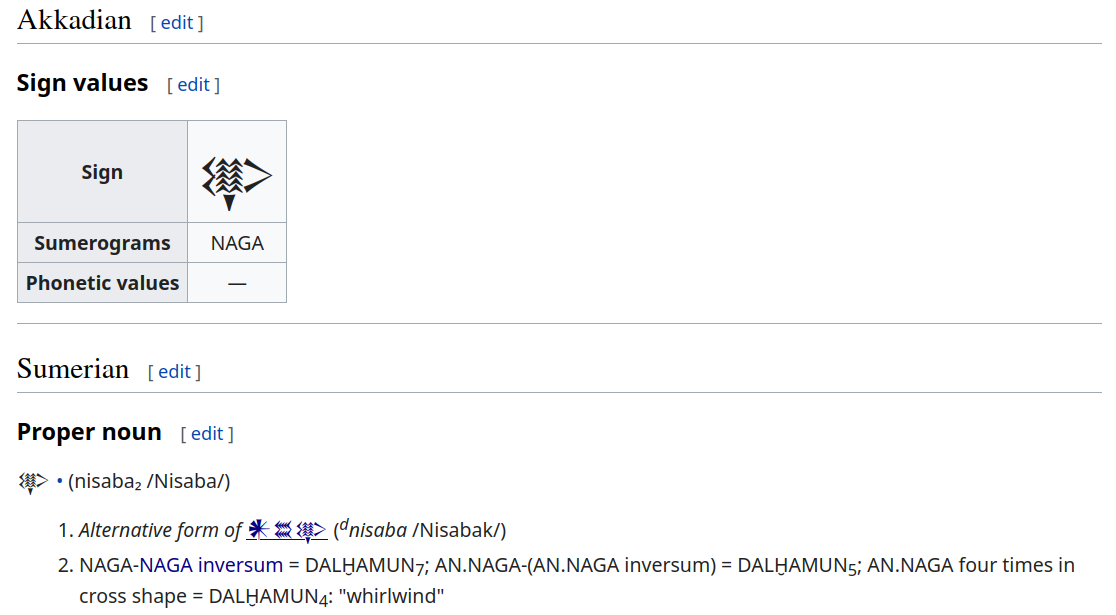

and if it was the same sabe sobak sebek I would expect 𒊺 stand for teeth, and 𒉀 would make a perfect crocodile with 𒆕 standing for the tail. and that short 𒑰 (cuneiform punctuation sign old assyrian word divider (U+12470)) (or is it 𒐕 the 60 (or is it 𒁹 the 1, used before (mainly) masculine personal names. marker for beginning sentences and paragraphs. repetition marker.)) to be 🜄
дои дави
I'm sorry is мне соромно (мне срамно, но без украинского я бы срам к sorry не прицепил бы, слишком далеко. так что укаинский это мост не между русским и польским, а вообще между русским и европейскими
отвратный от врат (от ворот поворот)
отвратительный от врат и телъ ну его
й = его? ij? he?
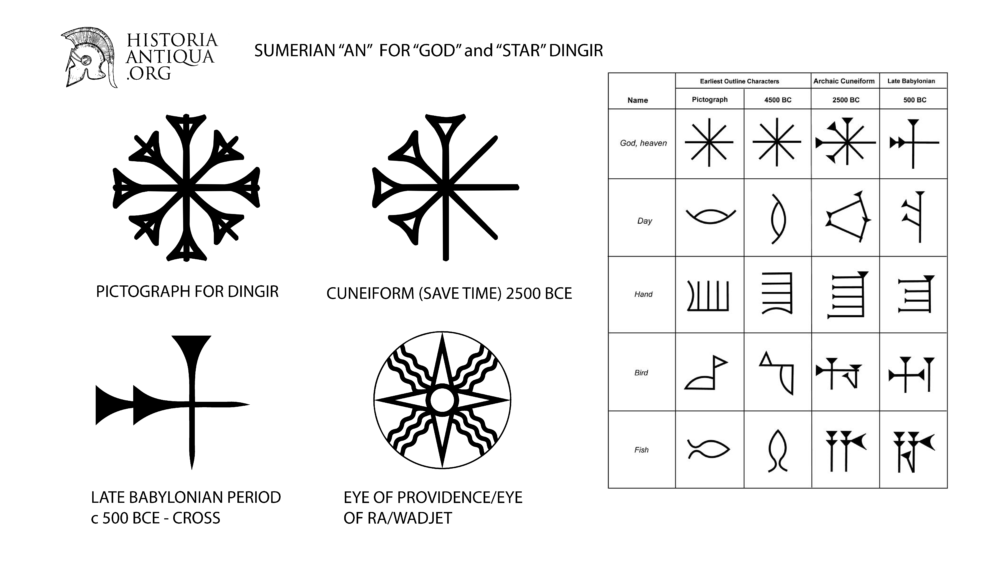
This reminds that snowflake I was speakind speaking of and this is
𒐕 the 60, then neither 8 nor 4 make 360. Only the six of them. six triangles. the 18 letters of triads. and being kinda repeating themselves in those triads, they thus always can be arranged into 3 aettir, but then aettir should have runes of the same kind (vowels, labials, linguals)
Let's explore this guess. Abouth those 18 being able to splint into vowels and labials and linguals evenly.
ᛆᚾᛁᚮ
ᛒᚠᛘᚱᚢ
ᚦᚵᚼ(or ᛡ)ᚴᛚ(even though it looks like ᛉ)ᚿᛦ(if R, or ᛣ if Q)ᛋᛏ
and I naturally began askin my solution, but even with ..but then I see that I can do it thus:
ᛆ ᚾ ᛁ ᚮ ᚼ(ᛡ) ᛦ(ᛣ)
ᛒ ᚠ ᛘ(ᛉ) ᚿ ᚱ ᚢ
ᚦ ᚵ ᚴ ᛚ ᛋ ᛏ
but of course it's very shaky for many reasons, it's too late in the morning to wokr.
but then I see some better way to sort them out:
ᛆ ᚾ ᚼ(ᛡ) ᛁ ᛚ ᚮ
ᛒ ᚠ ᛘ(ᛉ) ᚿ ᚱ ᚢ
ᚦ ᚵ ᚴ ᛦ(ᛣ) ᛋ ᛏ
okay, now let's look at them in the order:
ᛆᛒᚦ
ᚾᚠᚵ
ᚼᛁᚴ
ᛚᛘᚿ
ᚮᚱᛦᛋᛏᚢ
ᚿ being labial is quite a stratch, I must say. These drafts are not to be shown, because they're embarassing until they deliver (just as photographers are not supposed to show the negatives of their photographs, not to show how many of them suck)
a first actual magic wand I've ever seen:
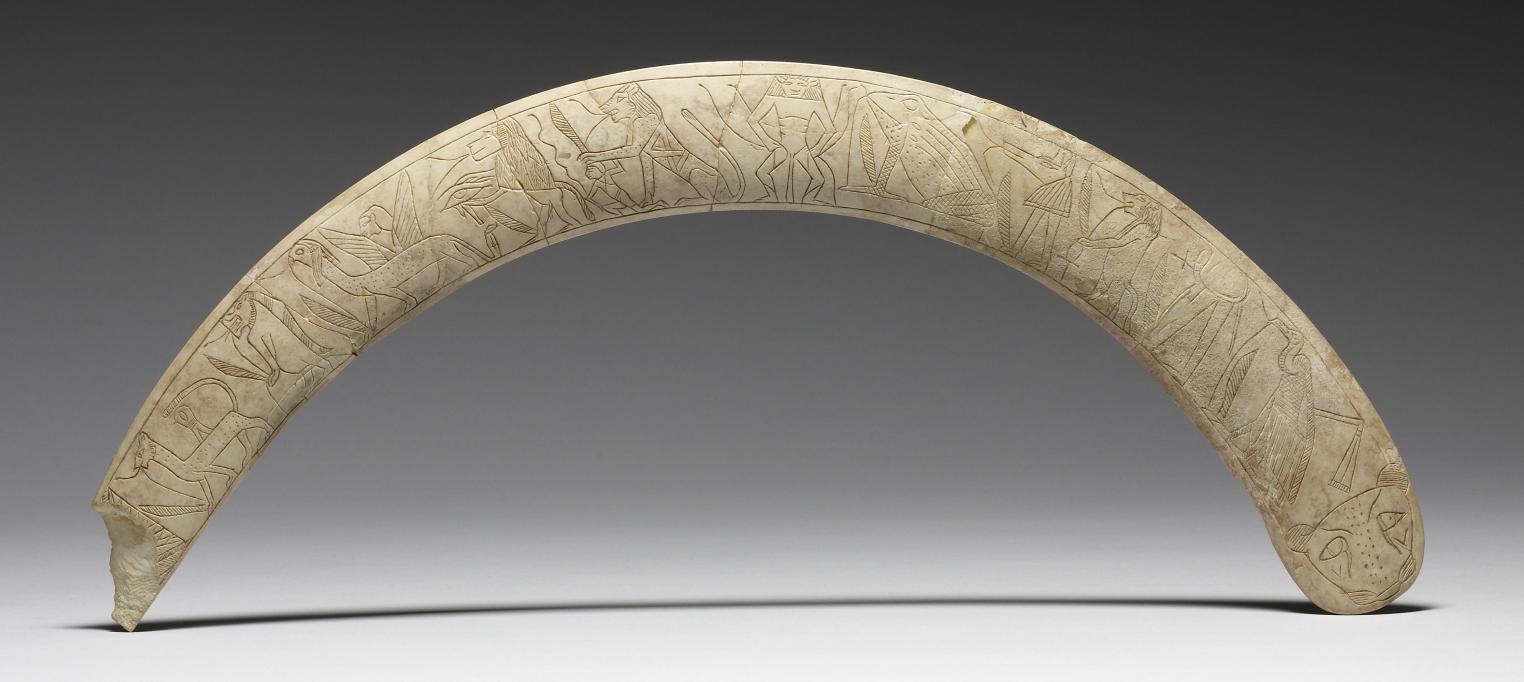
An ancient Egyptian apotropaic wand shows a procession of protective deities. It was used in birth rituals, perhaps to draw a magic circle around the mother and child.
I can see the future
I consider future
зашибись и заебись не только междометия, но и императивы, и причём проклятия (сравни с break a leg, подобный семантический сдвиг произошёл в позитивную сторону (какие-0то проклятия были обнаружены счастливыми?)
а поскольку семантика проклятия никуда не делась, имеет смысл отказаться от бранных слов.
дурак dork дёргай (отсюдава)
some combinations of letters seem to be more agressive then the others. Is it seems linguals are more agressive, because they're more masculine.
dork jerk do rock (в отличие от touch)
why am I here.
And indeed I found myself in some strangest place:

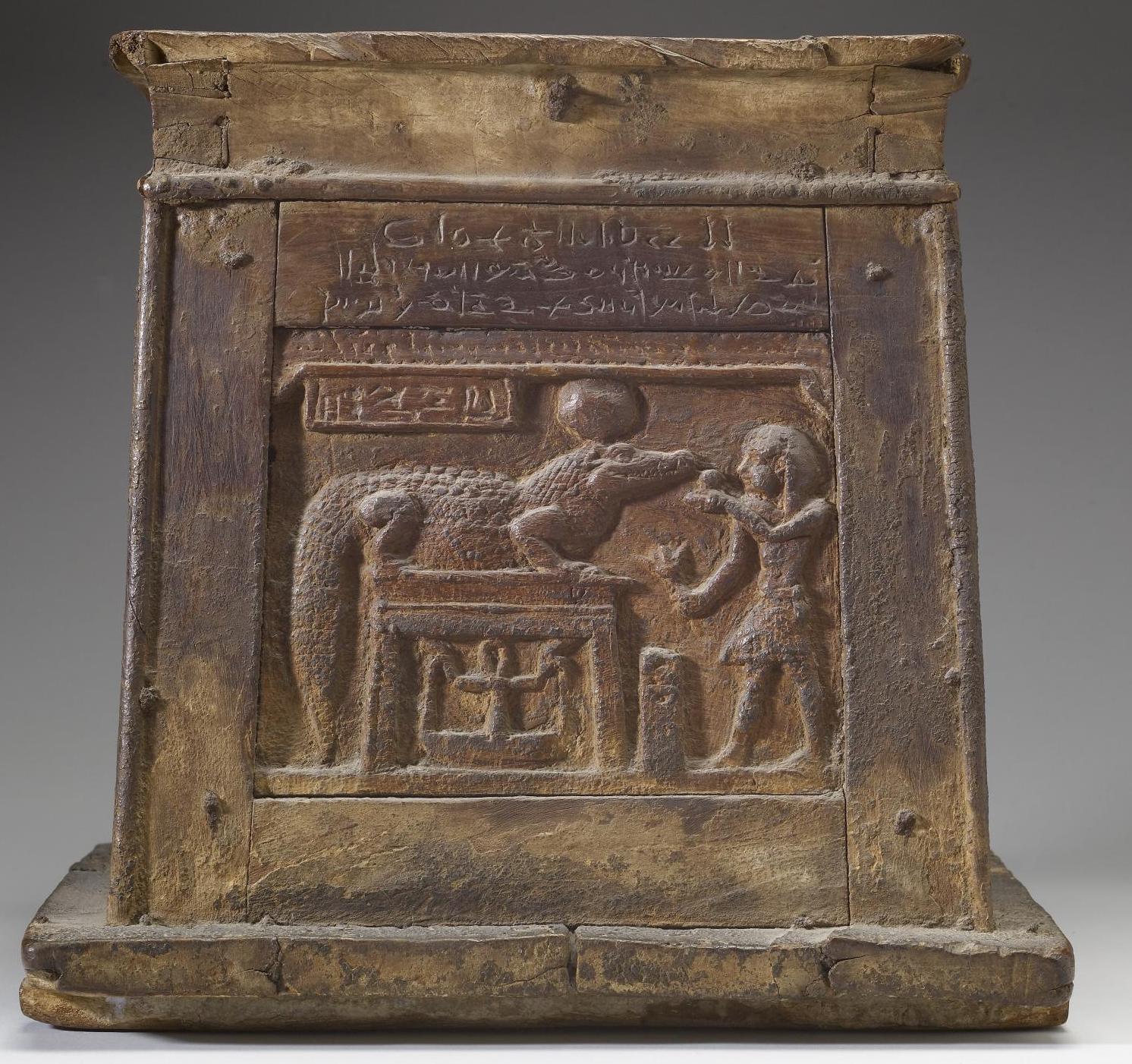
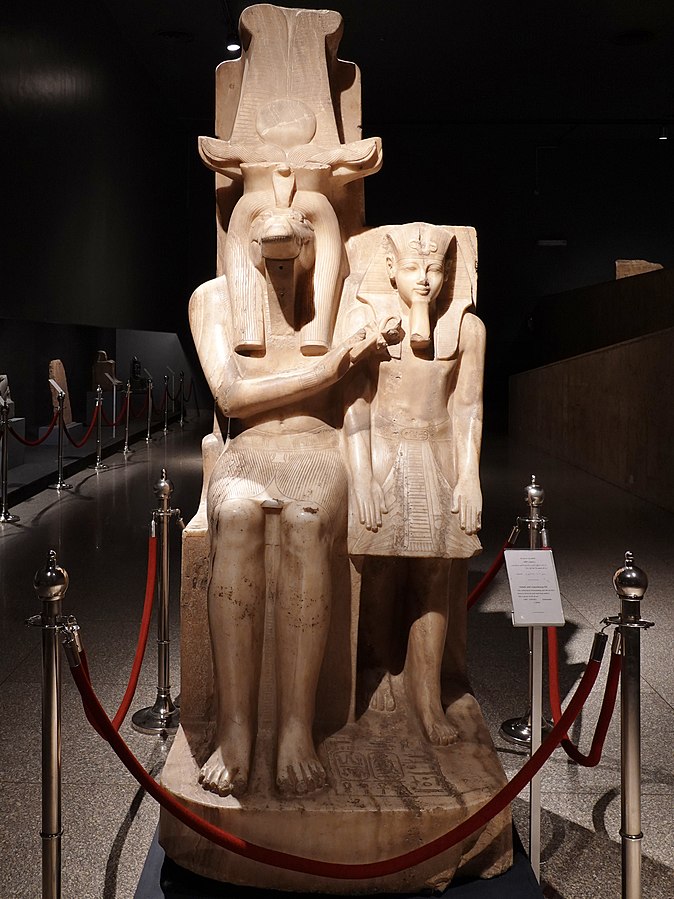
on this statue it is shown how crocodiles gives ankh to the pharao
Blood of reptiles does something to humans, I met snake blood as an element in preparing the grail (mixture of snake poison to snake oil. Or maybe the blood alone may be the antidote to snake bite, they say that is how they survived being thus immune to their own venom.
,_N372.2.jpg)
and ankh once again, and snakes in the crown, and horns of the crown remind both Bathometh Baphomet's horns and asclepius.. not exactly, but also with a snake, so very close to.. medicine staff of Hermes.
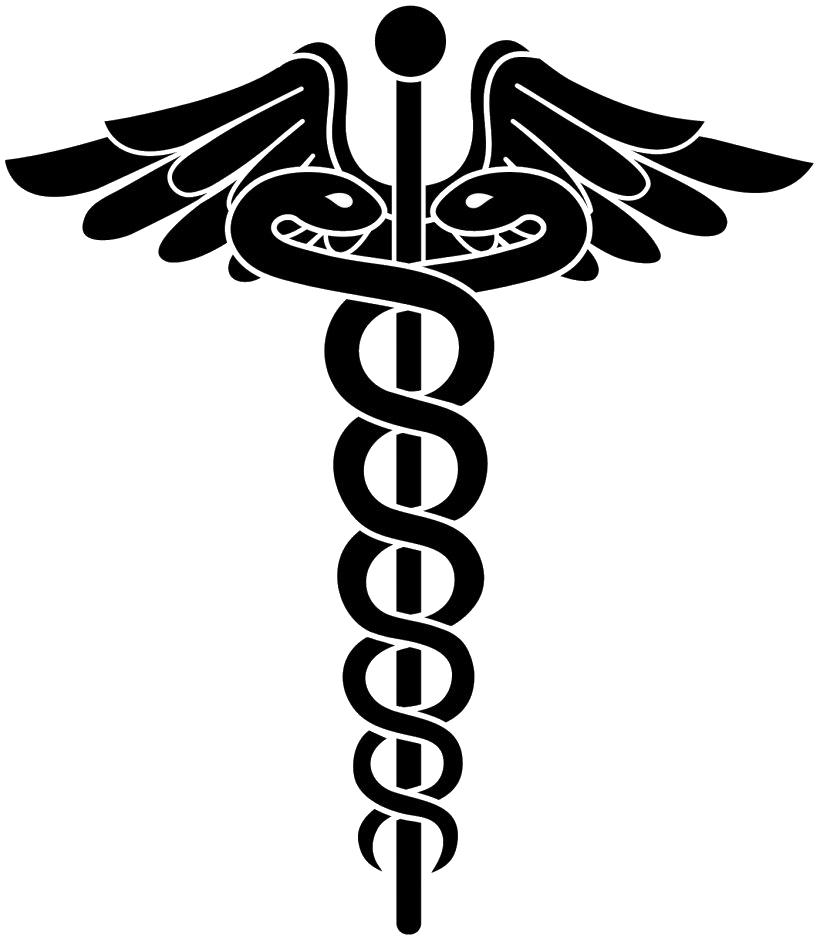
And thus the story of For they cast down every man his rod, and they became serpents: but Aaron's rod swallowed up their rods.
could describe using python instead of vipers. But python doesn't have venom, does he? Does he have those antivenomous components in his blood? But python also have meaninge of diviner (and viper has a meaning of a pothead which I am)
So was python another magical school? Was he also used to cure bites of the vipers?
mad has mad met (you konw who, the spirits)
вера въ ра (русский явно имеет этот корень для солнца, он же возможно и в round, and maybe the r in circle too, but in russian it's жара, пора, semantically they are right to the point. жа is ра as jah is rah) now that is some zadornove-tier shit, and I added this chapter to freaks.html
вера надежда любовь
в ра на даждь le above? Now this is some chudinov-tier shit, and I don't even add it nowhere.
россияне раб.сияне раб.силяне раб.селяне (rus is village in latin, but selo is village in russian, even if it's an obsolete (not formal, but still colloquial and is much more in use than the more official form of the word) form of поселение, settlement, and this english form has the same s russian selo does)
вороватый и тароватый may represent those B and T as in and out (as if вороватый рвёт к себе, а тароватый от себя, один берёт другой дарит)
божий дар
дажий бор
бог~бор~bog (bog забирает, как и бор, бор забрёл забрал(вбок, например)
I feel K as fire not only because opf chinese, but also because of vodka named by chukchas огненная вода, firy water, and water is voda.
Lava if watery fire, la~ka, both are lingual.
если и это и суть B & T,
b is water, om. eau
t is fire, ash. feu (fu eau? not water? so no wonder it's so plenty, it included all the other shapes, from gases of smoke to solids of ash, how is these english and hebrew forms unite I don't know, but they/re sertainly the same word, like too fundamental, and who knows what languages are, they're not branches, they're clouds with the same elements covering areas across the languages. like wards and grammatic inventions)
V & Λ are literally 🜄 & 🜂
eau as om is the first thing, the ocean of void, the primordial ocean, nobody said we're anywhere iots surface. Nobody said there is surface, if it's ocean all around, it has no surface, the ancients knew it, because probably world was more simple thn, and they seed saw the past more clearly, the basics of the systems which were more simple then, ah, next thought
so they knew it because the civilization developed before, but we only few centuries as out of the dark ages, memes ofr not, it was just dark in polities, but science could keep on going all these years, secretly and prohibited, and as cannabics culture is in decline because of kali yuga of now, hopefully ending soon or already,
feu = f-eu. what is f? where did f come? I recognize it as fu or no, from japqanese actually, and chinese has cognate bu (and probably fu too, I just don't know it well enough but
my finger tips hurt, because some buttons I type with the tips directly by the nails, but I must not even write with the pen, but speak with my voice, but then I must write the speach first
water eau
fire feu
fu is no in some languages
thus fire not water. Which is a simple way to describe it when only water exists, as many myth write about primordial ocean (and I refer to myths which correlate to my story, because I found that some of them are probably true, some of them are definitely true, and probably most of them are, but I only bring up those which are - подобные отступления текстом на экране давай чтоб не засорять эфирное время болтовнёйй, а держаться к сути, а зрители кто подотошней остановят и прочтут)
(that was the first part of that video (with chinese and french drawn on the screen. let's mark it in some new colour so I can find them when I make these videos.
and a sign to ctrlF them all.
𓀀
lady as a counterpart of lord. Lady leader, lord as in warlord. war-leader. lord = leader. lored?
And how could I never know what lore is until this very moment.
if lord is of lore, it's definitely a doublet of knight which is of knowledge.
water fire. it's interesting that english form of fire also begins with f. as if fire and feu are cognages. let's treat them as such to see where it leads us. lead льёт (see sea)
then ire is water? looks more like air. did they have different mythology? that everything appeared out of thin air? Or is aya is some other word, different from eya and these forms remind me of angel's language, of birds language, consisting only of vowels. Then primordial om (show the sanskrit om as if it's formed out of arabic letters) is a nasal a.
and if aya is water, ice is aya's
But then I realized that it is something fresh, very raw idea, so I can cook it before I can serve.
Nose нос nasal, somehow at least indoeuropeans agree on the name of that thing, and as I sound that à and feel my nose vibrate, I can see that just as there were labials and linguals, some letters could be recognized as nasals, because could people without noses pronounce them?
eyes глаза
eye глаз glass (глаз в разрезе, lens, vitreous humor)
ice~glass are cognates? what does gl- stand for? ass and eyes is cognates? око очко is literally small eye, it's also called a chocolate eye (This ho was sucking and nibbling my boys and decided to bite down hard so I gave her a chocolate eye drop.) ace is as and does it refer to assir? and туз is the chocolate eye in russian slang.
There's definitely some confusion about eyes and ass, but it is the topic I'd ratehr not pull into this savage shit, like literally shit. But then how will I be able to procede if I have a taboo switched on in this subject.
o is opening. hole, ã as in anus.
bubble appeared in the water first? and it grew and grew, and thus the idea of ocean above us and it would explain rain. No matter how primitive and inaccurate this picture may be, the inventers of the alphabet could be not having anything better than that.
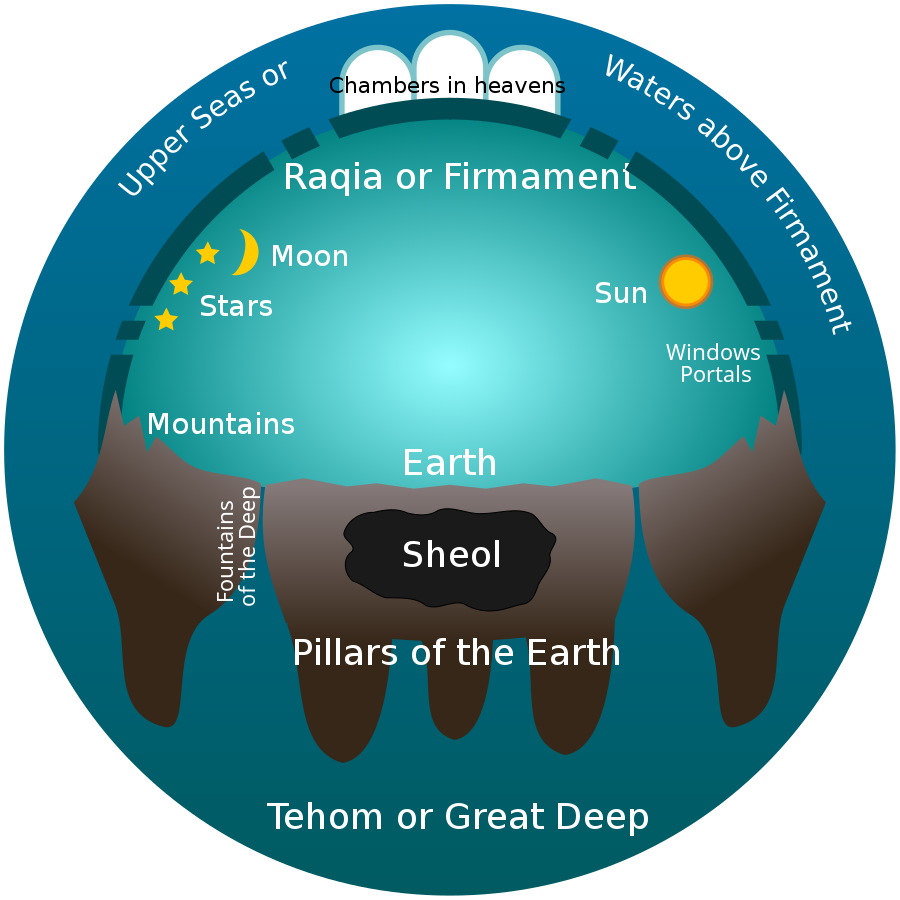
Early Hebrew conception of the cosmos. The firmament, Sheol and tehom are depicted.
глаз
glows
glass
(and many of such mnemonic (or really hypothetically etymologic doublets and triplets)
aye = yes
fu (boo, фу) = no
вода = да
огня = нет (пламя flame)
we should go further into the tabooed stuff. s is ass
ссать = to ssss (to piss)
but words to sit to shit (что делаешь? сижу. что? сру!(с натугой сказанное сижу) he sits/shits)
and this link goes on connecting all the words into its carnifval
ã as eau explains the word ocean as that very primordial ã with sea inside of it.
океан ~ о кеа н ~ окружающее море он
k ~ c? and indeed. but I thought k is fire, or metal, but not sea.
in ocean ce is ʃ but it still doesn't explain why would it be not labial in the context above.
the secret of c is that is a form of b? some different langage families differently understood the concepts of elements, different words for them had? why would they or what implications could such situation have? the duck and the rabbit and so on.
A air
E ё eau
I ice?
o eau?
u
Air
Earth
why would air be not above the water. smoke on the water.
air is read as er in french.
it should be hebrew! but in hebrew I know how those three mothers are recognized, as three mothers.
אוויר (avIr, also אויר) is air in hebrew.
אוירה (avirA) is atmosphere, female form of air ? air is male? дух носился над водой.
ר֣וּחַ אֱלֹהִ֔ים מְרַחֶ֖פֶת עַל־פְּנֵ֥י הַמָּֽיִם
A abodve M
and I just wanted to say that A & M are the two protoletters, because fire is also beginning with אש :א.
fire~air, both are gaseious.
fire is literally not air. and it is exactly the way to say .
Fire and flame are both 不 air and 不 water. And it also shows that sefer yetzirah is correct and those three elements are air, fire, water. But then the torah gives them as earth, fire, water: eretz v sha-maim
And I wonder why I remember it like that whern in reality it's fire, water, earth.
בְּרֵאשִׁ֖ית בָּרָ֣א אֱלֹהִ֑ים אֵ֥ת הַשָּׁמַ֖יִם וְאֵ֥ת הָאָֽרֶץ
S as soil? A is air. Mire? Fire is labial, but not M
A F S
AbcdeFghijC? it's way too far, way too much of an assumption, an attempt.
Air Fire Solid?
Agni.. agni opens rigveda, there should be something to it.
Aarde Water Lucht Vuur is fire, Vlam is flame, and it makes me wonder even more how often does dutch V becomes F in english and П in russian. Vier Vijf, Four Five, 4етыре Пять. почти что. П как покойник, покой название буквы в русской азбуке, и если Т означало смерть, то это П ᚢ
(4 simbolizes death in chinese and japanese, and russians are closer to them than englishmen)
At the point of flame and fire I'd rather leave this hypothesis, but then f not as a fundamental element, but as merely fu of no tells that what.. that I give me too many liberties, recognizing a- as that very no as well
Yet back to the Younger Futhark I mentioned previously:

The Younger Futhark: Danish long-branch runes and Swedish/Norwegian short-twig runes.
As you can see, they're already in 3 aettir, and not a trace of selection for articulatory features of the runes in them can be seen.
And here's anohter interesting representation of runes from the same webpage:

The ogam lochlannach, Book of Ballymote, fol. 170v
(ogam like in ogham?)
I wonder why there ᚠ and ᚴ look the same and why does transliteration sequence is cut at 16th when there's 18 at that runic row, and does it shift? yeah, I recognize h, I recognize n, but then goes ᛆ and yet in the transliteration row they placed i before it, but then they missed ᛁ from the runic row, and then that row of 18 runes is a row of 19 runes, which is a golden number and is somehow essential fro runic calendars. I dig such a wide field, I need specialists in each and every area.
Staveless runes represent the legendary 15:

notice how ᚱ and ᚢ again remind eachother.
ᛘ and ᛦ reflect eachother again. And once again two R's seem to be too much, especially for a 15-rune set, so one.. and I probably spoke about it, and I should sustain from this graphomania unless I have somehting to say. For how many times have I told it to myself and then I told me to give up alcohol for years until I have.
once again:

look at the Swedish/Norwegina b. How can that b be that much like these a: ᚨᚩᚪᚫᚬᚭᚯᚰ
But then though ᚭ is among unicode a's, that very a is sometimes read as o: futork.
but ..and I guess it is a variant of ᚮ, simply because it's double and ..suddenly I realize how many shapes are variants of one another, and thus many letters are united as shapes of one another, and than because I saw some rough shapes where ᛚ would look like ᚿ, even though I won't find some shapes, but because they're so similar both graphically an dphonetically, I unite them, but then ᛚ is distinguished by being higher and ᚿ has staff above it, which if any is the matter,
ᛦ and ᛏ both reflect ᚦ, and if they're both variants of the same shape, then I suspect unusual ᛋ to be a hieroglyphic shape depicting lightning (громовица) next (or actually preceding, as in nature) to ᛏ the th-r, the thor, the thunder. No wonder germans write nouns with capital letter: all nouns are names.
(either living beings, or deified abstract concepts, or some shinto fellows deify even objects)
So what I am saying is that ᚭ is o=ו=v=b and thus as 2 opposes the a~d
it all comes down to yin yang, dual system of 1 & 2, a & b, b & d, b & t
B & D
vowels only colour the message, yet initial vowel matters more for recognizing the word. And I suspect it to be non. a- = i- = un-
but then do we need i to recognize interior in ntr, because it's read as нутро and that is what interior is.
on=на, thus sometimes initial vowel matters less, but it cant be dropped in words like anomal, because it's meaningful. but nml is not nrml. what other word could come down to nml? немил? другой язык, и не одно слово, и подходит по смыслу слегка. what else? so it can be atributed solely to anomal?
and if we simplify it into that binary alphabet of bt, it would be tbt. tibet is anomal, кабак is anomal, совет не должен быть anomal, but it is, but why do I look for examples in russian? tbt: sweet, lips, tips, tops, cops, raped, rapes, caps, (cops are caps? taped, saved, raved, craved? rapper, and many words come to that, but not simple words, simple could be, but it's rather tbbt. so I haven't met tbt-words since I wrote the text after those examples (tbbtt)
So can I write poems with more freedom to the interpretation?
become someone be high see deep and lucid, let
That short-twig ᛒ looking like ᚭ is supported by ᚴ standing for K as C is which is a shape of ᚦ, it's staveless form. And if upwards, downwards, left and right is variable, I beieve I will have only two letters: single and double, the proto-ogham of a sort, ogham consisting of only two letters:
B & D
ᚁ and ᚇ
only in ogham they seem to be the other way around: labial is single and lingual is double, but then there man is mathur, why may say that they were influenced by patriarchal influence of what later become the catholic church less.
Ladies first, this is where the B before C came, but then in runes we already have D single and B double, but B stands before D. It is super weird. And how these two play along, are others go the same way?
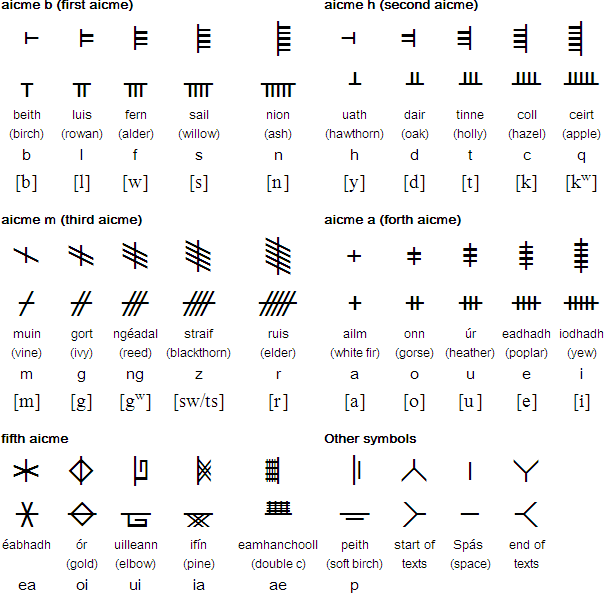
᚛ ᚁᚂᚃᚄᚅ ᚆᚇᚈᚉᚊ ᚋᚌᚍᚎᚏ ᚐᚑᚒᚓᚔ ᚕᚖᚗᚘᚙᚚ᚜
᚛ ᚁᚇᚃᚉ are b d f c, which is super cool if c is g. But then in slopey aicme ᚌ is g, and thus it jumps between b & d. And why did I stop? but I didn't, I went 1 to 4 and 5's are ᚅᚊᚏ nqr, and these are how it goes in the alphabet, and all three are linguals, and that is even the order these consonants go and the only one missing between them is p, but ogham doesn't have p in these aicmes (I don't know celtic plural suffix, just as runes only later added it, bornholm runeset doesn't have ᛈ, but then I think ᚱ was П. contraversy. )
So for convenience of my speculation I suspect the slopey qicme to be also not original, less authentic than the other two. Because it doesn't support the play of f reflecting t, c reflecting s, but then the other letters don't play this game that much either, and even c/s is requiring an explanation, but it's from some ancient notebooks of mine, I building on air of my suggestion, not cool.
but then slopey aicme opposes: isn't it cool how g is standing at the position shared with d & l, for it relates to them both which I raised in other contexts. M as a form of B (and so is H, and see japanese to realize why it's among them) and then z is where s and c are. And we already mentioned r, and the only slopey letter not directly reminding the other two is ng in the gropur of t and f. But then the others tell, now it belongs to them, some θ-like t-f with which the also weird ŋ. Makes some sense, like ᛃ and ᛜ, even though ᛃ is nominally [j] which is more like ᛜ than θ, but (но ~ no) then them being third directly envokes ᚦ the legendary third.
and once again it's time to move on. vol.19
...

